Chipara, A. C.; Tsafack, T.; Owuor, P. S.; Yeon, J.; Junkermeier, C. E.; van Duin, A. C. T.; Bhowmick, S.; Asif, S. A. S.; Radhakrishnan, S.; Park, J. H.; Brunetto, G.; Kaipparettu, B. A.; Galvão, D. S.; Chipara, M.; Lou, J.; Tsang, H. H.; Dubey, M.; Vajtai, R.; Tiwary, C. S.; Ajayan, P. M.
Underwater Adhesive using Solid–liquid Polymer Mixes Journal Article
In: Materials Today Chemistry, vol. 9, pp. 149-157, 2018.
@article{Chipara2018,
title = {Underwater Adhesive using Solid–liquid Polymer Mixes},
author = {A.C. Chipara and T. Tsafack and P.S. Owuor and J. Yeon and C.E. Junkermeier and A.C.T. van Duin and S. Bhowmick and S.A.S. Asif and S. Radhakrishnan and J.H. Park and G. Brunetto and B.A. Kaipparettu and D.S. Galvão and M. Chipara and J. Lou and H.H. Tsang and M. Dubey and R. Vajtai and C.S. Tiwary and P.M. Ajayan},
url = {https://www.sciencedirect.com/science/article/pii/S2468519418301423#appsec1},
doi = {10.1016/j.mtchem.2018.07.002},
year = {2018},
date = {2018-08-08},
journal = {Materials Today Chemistry},
volume = {9},
pages = {149-157},
abstract = {Instantaneous adhesion between different materials is a requirement for several applications ranging from electronics to biomedicine. Approaches such as surface patterning, chemical cross-linking, surface modification, and chemical synthesis have been adopted to generate temporary adhesion between various materials and surfaces. Because of the lack of curing times, temporary adhesives are instantaneous, a useful property for specific applications that need quick bonding. However, to this day, temporary adhesives have been mainly demonstrated under dry conditions and do not work well in submerged or humid environments. Furthermore, most rely on chemical bonds resulting from strong interactions with the substrate such as acrylate based. This work demonstrates the synthesis of a universal amphibious adhesive solely by combining solid polytetrafluoroethylene (PTFE) and liquid polydimethylsiloxane (PDMS) polymers. While the dipole-dipole interactions are induced by a large electronegativity difference between fluorine atoms in PTFE and hydrogen atoms in PDMS, strong surface wetting allows the proposed adhesive to fully coat both substrates and PTFE particles, thereby maximizing the interfacial chemistry. The two-phase solid–liquid polymer system displays adhesive characteristics applicable both in air and water, and enables joining of a wide range of similar and dissimilar materials (glasses, metals, ceramics, papers, and biomaterials). The adhesive exhibits excellent mechanical properties for the joints between various surfaces as observed in lap shear testing, T-peel testing, and tensile testing. The proposed biocompatible adhesive can also be reused multiple times in different dry and wet environments. Additionally, we have developed a new reactive force field parameterization and used it in our molecular dynamics simulations to validate the adhesive nature of the mixed polymer system with different surfaces. This simple amphibious adhesive could meet the need for a universal glue that performs well with a number of materials for a wide range of conditions.},
keywords = {},
pubstate = {published},
tppubtype = {article}
}
Oliveira, Eliezer F.; Autreto, Pedro A. S.; Woellner, Cristiano F.; Galvao, Douglas S.
On the mechanical properties of novamene: a fully atomistic molecular dynamics and DFT investigation Journal Article
In: Carbon, vol. 139, pp. 782-788, 2018.
@article{Oliveira2018e,
title = {On the mechanical properties of novamene: a fully atomistic molecular dynamics and DFT investigation},
author = {Eliezer F. Oliveira and Pedro A. S. Autreto and Cristiano F. Woellner and Douglas S. Galvao},
url = {https://www.sciencedirect.com/science/article/pii/S0008622318306882?via%3Dihub#appsec1},
doi = {10.1016/j.carbon.2018.07.038},
year = {2018},
date = {2018-07-19},
journal = {Carbon},
volume = {139},
pages = {782-788},
abstract = {We have investigated through fully atomistic reactive molecular dynamics and density functional theory simulations, the mechanical properties and fracture dynamics of single-ringed novamene (1R-novamene), a new 3D carbon allotrope structure recently proposed. Our results showed that 1R-novamene is an anisotropic structure with relation to tensile deformation. Although 1R-novamente shares some mechanical features with other carbon allotropes, it also exhibits distinct ones, such as, extensive structural reconstructions. 1R-novamene presents ultimate strength (∼100 GPa) values lower than other carbon allotropes, but it has the highest ultimate strain along the z-direction (∼22.5%). Although the Young's modulus (∼600 GPa) and ultimate strength values are smaller than for other carbon allotropes, they still outperform other materials, such as for example silicon, steel or titanium alloys. With relation to the fracture dynamics, 1R-novamene is again anisotropic with the fracture/crack propagation originating from deformed heptagons and pentagons for x and y directions and broken sp3 bonds connecting structural planes. Another interesting feature is the formation of multiple and long carbon linear chains in the final fracture stages.},
keywords = {},
pubstate = {published},
tppubtype = {article}
}
Gautam, Chandkiram; Chakravarty, Dibyendu; Woellner, Cristiano F.; Mishra, Vijay Kumar; Ahamad, Naseer; Gautam, Amarendra; Ozden, Sehmus; Jose, Sujin; Biradar, Santosh Kumar; Vajtai, Robert; Trivedi, Ritu; Tiwary, Chandra Sekhar; Galvao, Douglas S.; Ajayan, P. M.
Synthesis and 3D Interconnected Nanostructured h-BN-Based Biocomposites by Low-Temperature Plasma Sintering: Bone Regeneration Applications Journal Article
In: ACS Omega, vol. 3, no. 6, pp. 6013–6021, 2018.
@article{Gautam2018,
title = {Synthesis and 3D Interconnected Nanostructured h-BN-Based Biocomposites by Low-Temperature Plasma Sintering: Bone Regeneration Applications},
author = {Chandkiram Gautam and Dibyendu Chakravarty and Cristiano F. Woellner and Vijay Kumar Mishra and Naseer Ahamad and Amarendra Gautam and Sehmus Ozden and Sujin Jose and Santosh Kumar Biradar and Robert Vajtai and Ritu Trivedi and Chandra Sekhar Tiwary and Douglas S. Galvao and P.M. Ajayan},
url = {https://pubs.acs.org/doi/abs/10.1021/acsomega.8b00707},
doi = {10.1021/acsomega.8b00707},
year = {2018},
date = {2018-06-05},
journal = {ACS Omega},
volume = {3},
number = {6},
pages = {6013–6021},
abstract = {Recent advances and demands in biomedical applications drive a large amount of research to synthesize easily scalable low-density, high-strength, and wear-resistant biomaterials. The chemical inertness with low density combined with high strength makes h-BN one of the promising materials for such application. In this work, three-dimensional hexagonal boron nitride (h-BN) interconnected with boron trioxide (B2O3) was prepared by easily scalable and energy efficient spark plasma sintering (SPS) process. The composite structure shows significant densification (1.6–1.9 g/cm3) and high surface area (0.97–14.5 m2/g) at an extremely low SPS temperature of 250 °C. A high compressive strength of 291 MPa with a reasonably good wear resistance was obtained for the composite structure. The formation of strong covalent bonds between h-BN and B2O3 was formulated and established by molecular dynamics simulation. The composite showed significant effect on cell viability/proliferation. It shows a high mineralized nodule formation over the control, which suggests its use as a possible osteogenic agent in bone formation.},
keywords = {},
pubstate = {published},
tppubtype = {article}
}
Balan, Aravind Puthirath; Radhakrishnan, Sruthi; Woellner, Cristiano F.; Sinha, Shyam K.; Deng, Liangzi; de los Reyes, Carlos; Rao, Manmadha; Paulose, Maggie; Neupane, Ram; Vajtai, Robert; Chu, Ching-Wu; Costin, Gelu; Galvao, Douglas S.; Marti, Angel A.; van Aken, Peter; Varghese, Oomman K; Tiwary, Chandra Sekhar; Anantharaman, M R; Ajayan, Pulickel M
Exfoliation of a non-van der Waals material from iron ore hematite Journal Article
In: Nature Nanotechnology, vol. 13, pp. 602–610, 2018.
@article{Balan2018,
title = {Exfoliation of a non-van der Waals material from iron ore hematite},
author = {Aravind Puthirath Balan and Sruthi Radhakrishnan and Cristiano F. Woellner and Shyam K. Sinha and Liangzi Deng and Carlos de los Reyes and Manmadha Rao and Maggie Paulose and Ram Neupane and Robert Vajtai and Ching-Wu Chu and Gelu Costin and Douglas S. Galvao and Angel A. Marti and Peter van Aken and Oomman K Varghese and Chandra Sekhar Tiwary and M R Anantharaman and Pulickel M Ajayan
},
url = {https://www.nature.com/articles/s41565-018-0134-y},
year = {2018},
date = {2018-05-07},
journal = {Nature Nanotechnology},
volume = {13},
pages = {602--610},
abstract = {With the advent of graphene, the most studied of all two-dimensional materials, many inorganic analogues have been synthesized and are being exploited for novel applications. Several approaches have been used to obtain large-grain, high-quality materials. Naturally occurring ores, for example, are the best precursors for obtaining highly ordered and large-grain atomic layers by exfoliation. Here, we demonstrate a new two-dimensional material ‘hematene’ obtained from natural iron ore hematite (α-Fe2O3), which is isolated by means of liquid exfoliation. The two-dimensional morphology of hematene is confirmed by transmission electron microscopy. Magnetic measurements together with density functional theory calculations confirm the ferromagnetic order in hematene while its parent form exhibits antiferromagnetic order. When loaded on titania nanotube arrays, hematene exhibits enhanced visible light photocatalytic activity. Our study indicates that photogenerated electrons can be transferred from hematene to titania despite a band alignment unfavourable for charge transfer.},
keywords = {},
pubstate = {published},
tppubtype = {article}
}
Bizao, Rafael A; Machado, Leonardo D; de Sousa, Jose M; Pugno, Nicola M; Galvao, Douglas S
Scale Effects on the Ballistic Penetration of Graphene Sheets Journal Article
In: Nature Scientific Reports, vol. 8, pp. 6750, 2018.
@article{Bizao2018,
title = {Scale Effects on the Ballistic Penetration of Graphene Sheets},
author = {Bizao, Rafael A and Machado, Leonardo D and de Sousa, Jose M and Pugno, Nicola M and Galvao, Douglas S},
url = {https://www.nature.com/articles/s41598-018-25050-2},
doi = {doi:10.1038/s41598-018-25050-2},
year = {2018},
date = {2018-04-30},
journal = {Nature Scientific Reports},
volume = {8},
pages = {6750},
abstract = {Carbon nanostructures are promising ballistic protection materials, due to their low density and excellent mechanical properties. Recent experimental and computational investigations on the behavior of graphene under impact conditions revealed exceptional energy absorption properties as well. However, the reported numerical and experimental values differ by an order of magnitude. In this work, we combined numerical and analytical modeling to address this issue. In the numerical part, we employed reactive molecular dynamics to carry out ballistic tests on single, double, and triple-layered graphene sheets. We used velocity values within the range tested in experiments. Our numerical and the experimental results were used to determine parameters for a scaling law. We find that the specific penetration energy decreases as the number of layers (N) increases, from ∼15 MJ/kg for N = 1 to ∼0.9 MJ/kg for N = 350, for an impact velocity of 900 m/s. These values are in good agreement with simulations and experiments, within the entire range of N values for which data is presently available. Scale effects explain the apparent discrepancy between simulations and experiments.},
keywords = {},
pubstate = {published},
tppubtype = {article}
}
Marco AE Maria Celina M Miyazaki, Daiane Damasceno Borges
Experimental and computational investigation of reduced graphene oxide nanoplatelets stabilized in poly(styrene sulfonate) sodium salt Journal Article
In: Journal of Materials Science, vol. 53, no. 14, pp. 10049-10056, 2018.
@article{Miyazaki2018,
title = {Experimental and computational investigation of reduced graphene oxide nanoplatelets stabilized in poly(styrene sulfonate) sodium salt},
author = {Celina M Miyazaki, Marco AE Maria, Daiane Damasceno Borges, Cristiano F Woellner, Gustavo Brunetto, Alexandre F Fonseca, Carlos JL Constantino, Marcelo A Pereira-da-Silva, Abner de Siervo, Douglas S Galvao, Antonio Riul Jr},
url = {https://link.springer.com/article/10.1007/s10853-018-2325-1},
doi = {https://link.springer.com/article/10.1007/s10853-018-2325-1},
year = {2018},
date = {2018-04-19},
journal = {Journal of Materials Science},
volume = {53},
number = {14},
pages = {10049-10056},
abstract = {The production of large-area interfaces and the use of scalable methods to build up
designed nanostructures generating advanced functional properties are of high
interest for many materials science applications. Nevertheless, large-area coverage
remains a major problem even for pristine graphene, and here we present a hybrid,
composite graphene-like material soluble in water that can be exploited in many
areas such as energy storage, electrodes fabrication, selective membranes and
biosensing. Graphene oxide (GO) was produced by the traditional Hummers’
method being further reduced in the presence of poly(styrene sulfonate) sodium salt
(PSS), thus creating stable reduced graphene oxide (rGO) nanoplatelets wrapped by
PSS (GPSS). Molecular dynamics simulations were carried out to further clarify the
interactions between PSS molecules and rGO nanoplatelets, with calculations
supported by Fourier transform infrared spectroscopy analysis. The intermolecular
forces between rGO nanoplatelets and PSS lead to the formation of a hybrid material
(GPSS) stabilized by van der Waals forces, allowing the fabrication of high-quality
layer-by-layer (LbL) films with poly(allylamine hydrochloride) (PAH). Raman and
electrical characterizations corroborated the successful modifications in the electronic
structures from GO to GPSS after the chemical treatment, resulting in (PAH/
GPSS) LbL films four orders of magnitude more conductive than (PAH/GO).},
keywords = {},
pubstate = {published},
tppubtype = {article}
}
designed nanostructures generating advanced functional properties are of high
interest for many materials science applications. Nevertheless, large-area coverage
remains a major problem even for pristine graphene, and here we present a hybrid,
composite graphene-like material soluble in water that can be exploited in many
areas such as energy storage, electrodes fabrication, selective membranes and
biosensing. Graphene oxide (GO) was produced by the traditional Hummers’
method being further reduced in the presence of poly(styrene sulfonate) sodium salt
(PSS), thus creating stable reduced graphene oxide (rGO) nanoplatelets wrapped by
PSS (GPSS). Molecular dynamics simulations were carried out to further clarify the
interactions between PSS molecules and rGO nanoplatelets, with calculations
supported by Fourier transform infrared spectroscopy analysis. The intermolecular
forces between rGO nanoplatelets and PSS lead to the formation of a hybrid material
(GPSS) stabilized by van der Waals forces, allowing the fabrication of high-quality
layer-by-layer (LbL) films with poly(allylamine hydrochloride) (PAH). Raman and
electrical characterizations corroborated the successful modifications in the electronic
structures from GO to GPSS after the chemical treatment, resulting in (PAH/
GPSS) LbL films four orders of magnitude more conductive than (PAH/GO).
Eliezer F.; Autreto Oliveira, Pedro A. S. ; Woellner
On the mechanical properties of novamene: a fully atomistic molecular dynamics and DFT investigation Online
2018, (preprint ArXiv:1804.07215).
@online{Oliveira2018f,
title = {On the mechanical properties of novamene: a fully atomistic molecular dynamics and DFT investigation},
author = {Oliveira, Eliezer F.; Autreto, Pedro A. S.; Woellner, Cristiano F.; Galvao, Douglas S.},
url = {https://arxiv.org/abs/1804.07215},
year = {2018},
date = {2018-04-19},
abstract = {We have investigated through fully atomistic reactive molecular dynamics and DFT simulations, the mechanical properties and fracture dynamics of novamene, a new 3D carbon allotrope structure recently proposed. Our results showed that novamene is an anisotropic structure with relation to tensile deformation. Although novamente shares some mechanical features with other carbon allotropes, it also exhibits distinct ones, such as, extensive structural reconstructions (self-healing effect). Novamene presents ultimate strength (~ 100 GPa) values lower than other carbon allotropes, but it has the highest ultimate strain along the z-direction (~ 22.5%). Although the Young's modulus (~ 600 GPa) and ultimate strength values are smaller than for other carbon allotropes, they still outperform other materials, such as for example silicon, steel or titanium alloys. With relation to the fracture dynamics, novamene is again anisotropic with the fracture/crack propagation originating from deformed heptagons and pentagons for x and y directions and broken sp3 bonds connecting structural planes. Another interesting feature is the formation of multiple and long carbon linear chains in the final fracture stages.},
note = {preprint ArXiv:1804.07215},
keywords = {},
pubstate = {published},
tppubtype = {online}
}
Kabbani, Mohamad A.; Kochat, Vidya; Bhowmick, Sanjit; Soto, Matias; Som, Anirban; Krishnadas, K. R.; Woellner, Cristiano F.; Jaques, Ygor M.; Barrera, Enrique V.; Asif, Syed; Vajtai, Robert; Pradeep, Thalappil; Galvão, Douglas S.; Kabbani, Ahmad T.; Tiwary, Chandra Sekhar; Ajayan, Pulickel M.
Consolidation of Functionalized Graphene at Ambient Temperature via Mechano-chemistry Journal Article
In: Carbon, vol. 134, no. 8, pp. 491-499, 2018.
@article{Kabbani2018,
title = {Consolidation of Functionalized Graphene at Ambient Temperature via Mechano-chemistry},
author = {Mohamad A. Kabbani and Vidya Kochat and Sanjit Bhowmick and Matias Soto and Anirban Som and K.R. Krishnadas and Cristiano F. Woellner and Ygor M. Jaques and Enrique V. Barrera and Syed Asif and Robert Vajtai and Thalappil Pradeep and Douglas S. Galvão and Ahmad T. Kabbani and Chandra Sekhar Tiwary and Pulickel M. Ajayan},
url = {https://www.sciencedirect.com/science/article/pii/S0008622318302987?dgcid=raven_sd_aip_email},
doi = {DOI:10.1016/j.carbon.2018.03.049},
year = {2018},
date = {2018-03-22},
journal = {Carbon},
volume = {134},
number = {8},
pages = {491-499},
abstract = {Graphitic solids are typically produced via high temperature and energy consuming
processing (e.g. sintering) of carbon particles. Here, we demonstrate the mechano-chemical
assembly of functionalized graphene layers into 3D graphitic solids via room temperature and
low energy consuming processing. The chemical functional groups on graphene layers are
interconnected at room temperature under pressure leading to porous three-dimensional
structures with tunable mechanical and electrical properties. The formation of mechanochemistry
induced atomic scale junctions and their impact on mechanical properties of
graphene assembled carbon materials are demonstrated through nano-indentation experiments
and confirmed using DFT and molecular dynamics simulations. The results show room
temperature consolidation routes of graphene layers into bulk carbon solids.},
keywords = {},
pubstate = {published},
tppubtype = {article}
}
processing (e.g. sintering) of carbon particles. Here, we demonstrate the mechano-chemical
assembly of functionalized graphene layers into 3D graphitic solids via room temperature and
low energy consuming processing. The chemical functional groups on graphene layers are
interconnected at room temperature under pressure leading to porous three-dimensional
structures with tunable mechanical and electrical properties. The formation of mechanochemistry
induced atomic scale junctions and their impact on mechanical properties of
graphene assembled carbon materials are demonstrated through nano-indentation experiments
and confirmed using DFT and molecular dynamics simulations. The results show room
temperature consolidation routes of graphene layers into bulk carbon solids.
Zink, Stefan; Moura, Francisco Alirio; da Silva Autreto, Pedro Alves; Galvao, Douglas Soares; Mizaikoff, Boris
Virtually Imprinted Polymers (VIPs): Understanding Molecularly Templated Materials via Molecular Dynamics Simulations Journal Article
In: Physical Chemistry Chemical Physics, vol. 20, pp. 13145-13152, 2018.
@article{Zink2018b,
title = {Virtually Imprinted Polymers (VIPs): Understanding Molecularly Templated Materials via Molecular Dynamics Simulations},
author = {Stefan Zink and Francisco Alirio Moura and Pedro Alves da Silva Autreto and Douglas Soares Galvao and Boris Mizaikoff},
url = {http://pubs.rsc.org/en/content/articlelanding/2018/cp/c7cp08284c/unauth#!divAbstract},
doi = {10.1039/C7CP08284C},
year = {2018},
date = {2018-02-15},
journal = {Physical Chemistry Chemical Physics},
volume = {20},
pages = {13145-13152},
abstract = {Molecularly imprinted polymers are advanced recognition materials selectively rebinding a target molecule present during synthesis of the polymer matrix. It is commonly understood that the templating process is based on embedding the complex formed between a template and functional monomers into a co-polymer matrix via polymerization with a cross-linker while maintaining their spatial arrangement forming a molecular imprint. Template removal then leads to synthetic recognition sites ready to selectively rebind their targets, which are complementary in functionality, size and shape to the target. In this study, an innovative theoretical concept using fully atomistic molecular dynamics simulations for modeling molecular templating processes is introduced yielding virtually imprinted polymers (VIPs). VIPs created for the template of 17-beta-estradiol and applied in modeled chromatography experiments demonstrated selectivity for their template evidencing the creation of virtual imprints as a result of a template synthesis protocol, which represents a theoretical confirmation of the governing imprinting theory.},
keywords = {},
pubstate = {published},
tppubtype = {article}
}
Leonardo D Machado Cristiano F Woellner, Pedro AS Autreto; Galvao, Douglas S
Structural Transformations of Carbon and Boron Nitride Nanoscrolls at High Impact Collisions Journal Article
In: Physical Chemistry Chemical Physics, vol. 20, pp. 4911-4916, 2018.
@article{Woellner2018,
title = {Structural Transformations of Carbon and Boron Nitride Nanoscrolls at High Impact Collisions},
author = {Cristiano F Woellner, Leonardo D Machado, Pedro AS Autreto, Jose M de Sousa, and Douglas S Galvao},
url = {http://pubs.rsc.org/en/content/articlelanding/2018/cp/c7cp07402f#!divAbstract},
doi = {DOI:10.1039/C7CP07402F},
year = {2018},
date = {2018-02-14},
journal = {Physical Chemistry Chemical Physics},
volume = {20},
pages = {4911-4916},
abstract = {The behavior of nanostructures under high strain-rate conditions has been the object of theoretical and
experimental investigations in recent years. For instance, it has been shown that carbon and boron
nitride nanotubes can be unzipped into nanoribbons at high-velocity impacts. However, the response of
many nanostructures to high strain-rate conditions is still unknown. In this work, we have investigated
the mechanical behavior of carbon (CNS) and boron nitride nanoscrolls (BNS) colliding against solid
targets at high velocities, using fully atomistic reactive (ReaxFF) molecular dynamics (MD) simulations.
CNS (BNS) are graphene (boron nitride) membranes rolled up into papyrus-like structures. Their openended
topology leads to unique properties not found in their close-ended analogs, such as nanotubes.
Our results show that collision products are mainly determined by impact velocities and by two
orientation angles, which define the position of the scroll (i) axis and (ii) open edge relative to the target.
Our MD results showed that for appropriate velocities and orientations, large-scale deformations and
nanoscroll fractures could occur. We also observed unscrolling (scrolls going back to quasi-planar
membranes), scroll unzipping into nanoribbons, and significant reconstruction due to breaking and/or
formation of new chemical bonds. For particular edge orientations and velocities, conversion from open
to close-ended topology is also possible, due to the fusion of nanoscroll walls.},
keywords = {},
pubstate = {published},
tppubtype = {article}
}
experimental investigations in recent years. For instance, it has been shown that carbon and boron
nitride nanotubes can be unzipped into nanoribbons at high-velocity impacts. However, the response of
many nanostructures to high strain-rate conditions is still unknown. In this work, we have investigated
the mechanical behavior of carbon (CNS) and boron nitride nanoscrolls (BNS) colliding against solid
targets at high velocities, using fully atomistic reactive (ReaxFF) molecular dynamics (MD) simulations.
CNS (BNS) are graphene (boron nitride) membranes rolled up into papyrus-like structures. Their openended
topology leads to unique properties not found in their close-ended analogs, such as nanotubes.
Our results show that collision products are mainly determined by impact velocities and by two
orientation angles, which define the position of the scroll (i) axis and (ii) open edge relative to the target.
Our MD results showed that for appropriate velocities and orientations, large-scale deformations and
nanoscroll fractures could occur. We also observed unscrolling (scrolls going back to quasi-planar
membranes), scroll unzipping into nanoribbons, and significant reconstruction due to breaking and/or
formation of new chemical bonds. For particular edge orientations and velocities, conversion from open
to close-ended topology is also possible, due to the fusion of nanoscroll walls.
Borges, Daiane Damasceno; Galvao, Douglas S.
Schwarzites for Natural Gas Storage: A Grand-Canonical Monte Carlo Study Journal Article
In: MRS Advances, vol. 3, no. 1-2, pp. 115-120, 2018.
@article{Borges2018d,
title = {Schwarzites for Natural Gas Storage: A Grand-Canonical Monte Carlo Study },
author = {Daiane Damasceno Borges and Douglas S. Galvao},
url = {https://www.cambridge.org/core/journals/mrs-advances/article/schwarzites-for-natural-gas-storage-a-grandcanonical-monte-carlo-study/2DF8D601AF8EF04BBAC5CCCBEFA8339E},
doi = {https://doi.org/10.1557/adv.2018.190},
year = {2018},
date = {2018-02-13},
journal = {MRS Advances},
volume = {3},
number = {1-2},
pages = {115-120},
abstract = {he 3D porous carbon-based structures called Schwarzites have been recently a subject of renewed interest due to the possibility of being synthesized in the near future. These structures exhibit negatively curvature topologies with tuneable porous sizes and shapes, which make them natural candidates for applications such as CO2 capture, gas storage and separation. Nevertheless, the adsorption properties of these materials have not been fully investigated. Following this motivation, we have carried out Grand-Canonical Monte Carlo simulations to study the adsorption of small molecules such as CO2, CO, CH4, N2 and H2, in a series of Schwarzites structures. Here, we present our preliminary results on natural gas adsorptive capacity in association with analyses of the guest-host interaction strengths. Our results show that Schwarzites P7par, P8bal and IWPg are the most promising structures with very high CO2 and CH4 adsorption capacity and low saturation pressure (<1bar) at ambient temperature. The P688 is interesting for H2 storage due to its exceptional high H2 adsorption enthalpy value of -19kJ/mol.},
keywords = {},
pubstate = {published},
tppubtype = {article}
}
Borges, Daiane Damasceno; Woellner, Cristiano F.; Autreto, Pedro A. S.; Galvao, Douglas S.
Water/alcohol separation via layered oxide graphene membranes Journal Article
In: MRS Advances, vol. 3, no. 1-2, pp. 109-114, 2018.
@article{Borges2018d,
title = {Water/alcohol separation via layered oxide graphene membranes},
author = {Daiane Damasceno Borges and Cristiano F. Woellner and Pedro A. S. Autreto and Douglas S. Galvao},
url = {https://www.cambridge.org/core/journals/mrs-advances/article/wateralcohol-separation-in-graphene-oxide-membranes-insights-from-molecular-dynamics-and-monte-carlo-simulations/C61C66FF48D35EB2DB3408ACCE96C41A},
doi = { https://doi.org/10.1557/adv.2018.192},
year = {2018},
date = {2018-02-13},
journal = {MRS Advances},
volume = {3},
number = {1-2},
pages = {109-114},
abstract = {Graphene-based membranes have been investigated as promising candidates for water filtration and gas separation applications. Experimental evidences have shown that graphene oxide can be impermeable to liquids, vapors and gases, while allowing a fast permeation of water molecules. This phenomenon has been attributed to the formation of a network of nano capillaries that allow nearly frictionless water flow while blocking other molecules by steric hindrance effects. It is supposed that water molecules are transported through the percolated two-dimensional channels formed between graphene-based sheets. Although these channels allow fast water permeation in such materials, the flow rates are strongly dependent on how the membranes are fabricated. Also, some fundamental issues regarding the nanoscale mechanisms of water permeation are still not fully understood and their interpretation remains controversial. In this work, we have investigated the dynamics of water permeation through pristine graphene and graphene oxide model membranes that have strong impact on water/alcohol separation. We have carried out fully atomistic classical molecular dynamics simulations of systems composed of multiple layered graphene-based sheets into contact with a pure water reservoir under controlled thermodynamics conditions (e. g., by varying temperature and pressure values). We have systematically analysed how the transport dynamics of the confined nanofluids depend on the interlayer distances and the role of the oxide functional groups. Our results show the water flux is much more effective for graphene than for graphene oxide membranes. These results can be attributed to the H-bonds formation between oxide functional groups and water, which traps the water molecules and precludes ultrafast water transport through the nanochannels.},
keywords = {},
pubstate = {published},
tppubtype = {article}
}
Oliveira, Eliezer Fernando; Autreto, Pedro Alves da Silva; Galvao, Douglas Soares
On hardening silver nanocubes by high velocity impacts: a fully atomistic molecular dynamics investigation Journal Article
In: Journal of Materials Science, vol. 53, no. 10, pp. 7486–7492, 2018.
@article{Oliveira2018,
title = {On hardening silver nanocubes by high velocity impacts: a fully atomistic molecular dynamics investigation},
author = {Oliveira, Eliezer Fernando and Autreto, Pedro Alves da Silva and Galvao, Douglas Soares},
url = {https://link.springer.com/article/10.1007/s10853-018-2104-z},
doi = {10.1007/s10853-018-2104-z},
year = {2018},
date = {2018-02-09},
journal = {Journal of Materials Science},
volume = {53},
number = {10},
pages = {7486–7492},
abstract = {Gradient nanograins (GNG) creation in metals has been a promising approach to obtain ultra-strong materials. Recently, R. Thevamaran et al. (Science 354:312 in 2016) proposed a single-step method based on high-velocity impacts of silver nanocubes (SNC) to produce almost perfect GNG. However, after certain time, these grains spontaneously coalesce, which compromises the induced hardening and other mechanical properties. To better understand these processes, a detailed investigation at the atomic scale of the deformation/hardening mechanisms are needed, which is one of the objectives of the present work. We carried out fully atomistic molecular dynamics (MD) simulations of silver nanocubes at high impact velocity values using realistic structural models. Our MD results suggest that besides the GNG mechanisms, the observed SNC hardening could be also the result of the existence of polycrystalline arrangements formed by HCP domains encapsulated by FCC ones in the smashed SNC. This can be a new way to design ultra-strong materials, even in the absence of GNG domains.},
keywords = {},
pubstate = {published},
tppubtype = {article}
}
de Sousa, J. M.; Aguiar, A. L.; Girao, E. C.; Fonseca, Alexandre F.; Filho, A. G. Souza; Galvao, Douglas S.
Mechanical Properties of Pentagraphene-based Nanotubes: A Molecular Dynamics Study Journal Article
In: MRS Advances, vol. 3, no. 1-2, pp. 97-102, 2018.
@article{deSousa2018b,
title = {Mechanical Properties of Pentagraphene-based Nanotubes: A Molecular Dynamics Study},
author = {J. M. de Sousa and A. L. Aguiar and E. C. Girao and Alexandre F. Fonseca and A. G. Souza Filho and Douglas S. Galvao},
url = {https://www.cambridge.org/core/journals/mrs-advances/article/mechanical-properties-of-pentagraphenebased-nanotubes-a-molecular-dynamics-study/289AB70DADF20059BB8FCC9EF07B97AB},
doi = { https://doi.org/10.1557/adv.2018.160},
year = {2018},
date = {2018-02-06},
journal = {MRS Advances},
volume = {3},
number = {1-2},
pages = {97-102},
abstract = {The study of the mechanical properties of nanostructured systems has gained importance in theoretical and experimental research in recent years. Carbon nanotubes (CNTs) are one of the strongest nanomaterials found in nature, with Young’s Modulus (EY) in the order 1.25 TPa. One interesting question is about the possibility of generating new nanostructures with 1D symmetry and with similar and/or superior CNT properties. In this work, we present a study on the dynamical, structural, mechanical properties, fracture patterns and EY values for one class of these structures, the so-called pentagraphene nanotubes (PGNTs). These tubes are formed rolling up pentagraphene membranes (which are quasi-bidimensional structures formed by densely compacted pentagons of carbon atoms in sp3 and sp2 hybridized states) in the same form that CNTs are formed from rolling up graphene membranes. We carried out fully atomistic molecular dynamics simulations using the ReaxFF force field. We have considered zigzag-like and armchair-like PGNTs of different diameters. Our results show that PGNTs present EY ∼ 800 GPa with distinct elastic behavior in relation to CNTs, mainly associated with mechanical failure, chirality dependent fracture patterns and extensive structural reconstructions.},
keywords = {},
pubstate = {published},
tppubtype = {article}
}
Cristiano F Woellner Daiane Damasceno Borges, Pedro AS Autreto
Insights on the mechanism of water-alcohol separation in multilayer graphene oxide membranes: entropic versus enthalpic factors Journal Article
In: Carbon, vol. 127, pp. 280-286, 2018.
@article{Borges2018,
title = {Insights on the mechanism of water-alcohol separation in multilayer graphene oxide membranes: entropic versus enthalpic factors},
author = {Daiane Damasceno Borges, Cristiano F Woellner, Pedro AS Autreto, Douglas S Galvao},
url = {https://www.sciencedirect.com/science/article/pii/S000862231731134X},
doi = {https://doi.org/10.1016/j.carbon.2017.11.020},
year = {2018},
date = {2018-02-01},
journal = {Carbon},
volume = {127},
pages = {280-286},
abstract = {xperimental evidence has shown that graphene oxide (GO) can be impermeable to liquids, vapors and gases, while it allows a fast permeation of water molecules. Theoretical studies to understand the filtration mechanisms come mostly from water desalination, while very few works have been dedicated to alcohol dehydration. In this work, we have investigated the molecular level mechanism underlying the alcohol/water separation inside GO membranes. A series of Molecular Dynamics and Grand-Canonical Monte Carlo simulations were carried out to probe the ethanol/water and methanol/water separation through GO membranes composed of multiple layered graphene-based films with different interlayer distance values and number of oxygen-containing functional groups. Our results show that the size exclusion and membrane affinities are not sufficient to explain the selectivity. Besides that, the favorable water molecular arrangement inside GO 2D-channels forming a robust H-bond network and the fast water permeation are crucial for an effective separation mechanism. In other words, the separation phenomenon is not only governed by membrane affinities (enthalpic mechanisms) but mainly by the geometry and size factors (entropic mechanisms). Our findings are consistent with the available experimental data and contribute to clarify important aspects of the separation behavior of confined alcohol/water in GO membranes.},
keywords = {},
pubstate = {published},
tppubtype = {article}
}
Fonseca, Alexandre F.; Galvao, Douglas S.
Self-Driven Graphene Tearing and Peeling: A Fully Atomistic Molecular Dynamics Investigation Journal Article
In: MRS Advances, vol. 3, no. 8-9, pp. 460-465, 2018.
@article{Fonseca2018,
title = {Self-Driven Graphene Tearing and Peeling: A Fully Atomistic Molecular Dynamics Investigation},
author = {Alexandre F. Fonseca and Douglas S. Galvao},
url = {https://www.cambridge.org/core/journals/mrs-advances/article/selfdriven-graphene-tearing-and-peeling-a-fully-atomistic-molecular-dynamics-investigation/BFC76FC4479AA617E16FA6AC7AB4D487},
doi = {https://doi.org/10.1557/adv.2018.120},
year = {2018},
date = {2018-01-30},
journal = {MRS Advances},
volume = {3},
number = {8-9},
pages = {460-465},
abstract = {In spite of years of intense research, graphene continues to produce surprising results. Recently, it was experimentally observed that under certain conditions graphene can self-drive its tearing and peeling from substrates. This process can generate long, micrometer sized, folded nanoribbons without the action of any external forces. Also, during this cracking-like propagation process, the width of the graphene folded ribbon continuously decreases and the process only stops when the width reaches about few hundreds nanometers in size. It is believed that interplay between the strain energy of folded regions, breaking of carbon-carbon covalent bonds, and adhesion of graphene-graphene and graphene-substrate are the most fundamental features of this process, although the detailed mechanisms at atomic scale remain unclear. In order to gain further insights on these processes we carried out fully atomistic reactive molecular dynamics simulations using the AIREBO potential as available in the LAMMPS computational package. Although the reported tearing/peeling experimental observations were only to micrometer sized structures, our results showed that they could also occur at nanometer scale. Our preliminary results suggest that the graphene tearing/peeling process originates from thermal energy fluctuations that results in broken bonds, followed by strain release that creates a local elastic wave that can either reinforce the process, similar to a whip cracking propagation, or undermine it by producing carbon dangling bonds that evolve to the formation of bonds between the two layers of graphene. As the process continues in time and the folded graphene decreases in width, the carbon-carbon bonds at the ribbon edge and interlayer bonds get less stressed, thermal fluctuations become unable to break them and the process stops.},
keywords = {},
pubstate = {published},
tppubtype = {article}
}
Woellner, Cristiano F.; Botari, Tiago; Perim, Eric; Galvao, Douglas S.
Mechanical Properties of Schwarzites - A Fully Atomistic Reactive Molecular Dynamics Investigation Journal Article
In: MRS Advances, pp. 1-6, 2018.
@article{Woellner2018b,
title = {Mechanical Properties of Schwarzites - A Fully Atomistic Reactive Molecular Dynamics Investigation},
author = {Cristiano F. Woellner and Tiago Botari and Eric Perim and Douglas S. Galvao},
url = {https://www.cambridge.org/core/journals/mrs-advances/article/mechanical-properties-of-schwarzites-a-fully-atomistic-reactive-molecular-dynamics-investigation/012AF477491A46541A052C944E4E4834},
doi = { https://doi.org/10.1557/adv.2018.124},
year = {2018},
date = {2018-01-29},
journal = {MRS Advances},
pages = {1-6},
abstract = {Schwarzites are crystalline, 3D porous structures with a stable negative curvature formed of sp2-hybridized carbon atoms. These structures present topologies with tunable porous size and shape and unusual mechanical properties. In this work, we have investigated the mechanical behavior under compressive strain and energy absorption of four different Schwarzites. We considered two Schwarzites families, the so-called Gyroid and Primitive and two structures from each family. We carried out reactive molecular dynamics simulations, using the ReaxFF force field as available in the LAMMPS code. Our results also show they exhibit remarkable resilience under mechanical compression. They can be reduced to half of their original size before structural failure (fracture) occurs.},
keywords = {},
pubstate = {published},
tppubtype = {article}
}
Woellner, Cristiano F.; Owuor, Peter S.; Li, Tong; Vinod, Soumya; Ozden, Sehmus; Kosolwattana, Suppanat; Bhowmick, Sanjit; Duy, Luong X.; Salvatierra, Rodrigo V.; Wei, Bingqing; Asif, Syed A. S.; Tour, James M.; Vajtai, Robert; Lou, Jun; Galvão, Douglas S.; Tiwary, Chandra S.; Ajayan, Pulickel. M.
Mechanical Properties of Ultralow Density Graphene Oxide/Polydimethylsiloxane Foams Journal Article
In: MRS Advances, vol. 3, no. 1-2, pp. 61-66, 2018.
@article{Woellner2018c,
title = {Mechanical Properties of Ultralow Density Graphene Oxide/Polydimethylsiloxane Foams},
author = {Cristiano F. Woellner and Peter S. Owuor and Tong Li and Soumya Vinod and Sehmus Ozden and Suppanat Kosolwattana and Sanjit Bhowmick and Luong X. Duy and Rodrigo V. Salvatierra and Bingqing Wei and Syed A. S. Asif and James M. Tour and Robert Vajtai and Jun Lou and Douglas S. Galvão and Chandra S. Tiwary and Pulickel. M. Ajayan},
url = {https://www.cambridge.org/core/journals/mrs-advances/article/mechanical-properties-of-ultralow-density-graphene-oxidepolydimethylsiloxane-foams/BC2DC24B3DB5714759FC1EDC71BD9D05},
doi = {DOI: 10.1557/adv.2018. 49},
year = {2018},
date = {2018-01-18},
journal = {MRS Advances},
volume = {3},
number = {1-2},
pages = { 61-66},
abstract = {Low-density, highly porous graphene/graphene oxide (GO) based-foams have shown high performance in energy absorption applications, even under high compressive deformations. In general, foams are very effective as energy dissipative materials and have been widely used in many areas such as automotive, aerospace and biomedical industries. In the case of graphene-based foams, the good mechanical properties are mainly attributed to the intrinsic graphene and/or GO electronic and mechanical properties. Despite the attractive physical properties of graphene/GO based-foams, their structural and thermal stabilities are still a problem for some applications. For instance, they are easily degraded when placed in flowing solutions, either by the collapsing of their layers or just by structural disintegration into small pieces. Recently, a new and scalable synthetic approach to produce low-density 3D macroscopic GO structure interconnected with polydimethylsiloxane (PDMS) polymeric chains (pGO) was proposed. A controlled amount of PDMS is infused into the freeze-dried foam resulting into a very rigid structure with improved mechanical properties, such as tensile plasticity and toughness. The PDMS wets the graphene oxide sheets and acts like a glue bonding PDMS and GO sheets. In order to obtain further insights on mechanisms behind the enhanced mechanical pGO response we carried out fully atomistic molecular dynamics (MD) simulations. Based on MD results, we build up a structural model that can explain the experimentally observed mechanical behavior.},
keywords = {},
pubstate = {published},
tppubtype = {article}
}
Azevedo, David L.; Bizao, Rafael A.; Galvao, Douglas S.
Molecular Dynamics Simulations of Ballistic Penetration of Pentagraphene Sheets Online
2018, (preprint arXiv:1801.05346).
@online{Azevedo2018b,
title = {Molecular Dynamics Simulations of Ballistic Penetration of Pentagraphene Sheets},
author = {David L. Azevedo and Rafael A. Bizao and Douglas S. Galvao},
url = {https://arxiv.org/abs/1801.05346},
year = {2018},
date = {2018-01-18},
abstract = {The superior mechanical properties and low density of carbon nanostructures make them promising ballistic protection materials, stimulating investigations on their high-strain-rate behavior. Recent experiments and simulations revealed graphene possesses exceptional energy absorption properties. In this work, we analyzed through fully atomistic molecular dynamics simulations the ballistic performance of a carbon-based material recently proposed named penta-graphene. Our results show that the fracture pattern is more spherical (no petals formation like observed for graphene). The estimated penetration energy for pentagraphene structures considered here was of 37.69 MJ/Kg, far superior to graphene (29.8 MJ/Kg) under same conditions. These preliminary results are suggestive that pentagraphene could be an excellent material for ballistic applications.},
note = {preprint arXiv:1801.05346},
keywords = {},
pubstate = {published},
tppubtype = {online}
}
Woellner, Cristiano F.; Botari, Tiago; Perim, Eric; Galvao, Douglas S.
Mechanical Properties of Schwarzites - A Fully Atomistic Reactive Molecular Dynamics Investigation Online
2018, (preprint arXiv:1801.05639).
@online{Woellner2018d,
title = {Mechanical Properties of Schwarzites - A Fully Atomistic Reactive Molecular Dynamics Investigation},
author = {Cristiano F. Woellner and Tiago Botari and Eric Perim and Douglas S. Galvao},
url = {https://arxiv.org/abs/1801.05639},
year = {2018},
date = {2018-01-18},
abstract = {Schwarzites are crystalline, 3D porous structures with stable negative curvature formed of sp2-hybridized carbon atoms. These structures present topologies with tunable porous size and shape and unusual mechanical properties. In this work, we have investigated the mechanical behavior under compressive strains and energy absorption of four different Schwarzites, through reactive molecular dynamics simulations, using the ReaxFF force field as available in the LAMMPS code. We considered two Schwarzites families, the so-called Gyroid and Primitive and two structures from each family. Our results also show they exhibit remarkable resilience under mechanical compression. They can be reduced to half of their original size before structural failure (fracture) occurs.},
note = {preprint arXiv:1801.05639},
keywords = {},
pubstate = {published},
tppubtype = {online}
}
2017
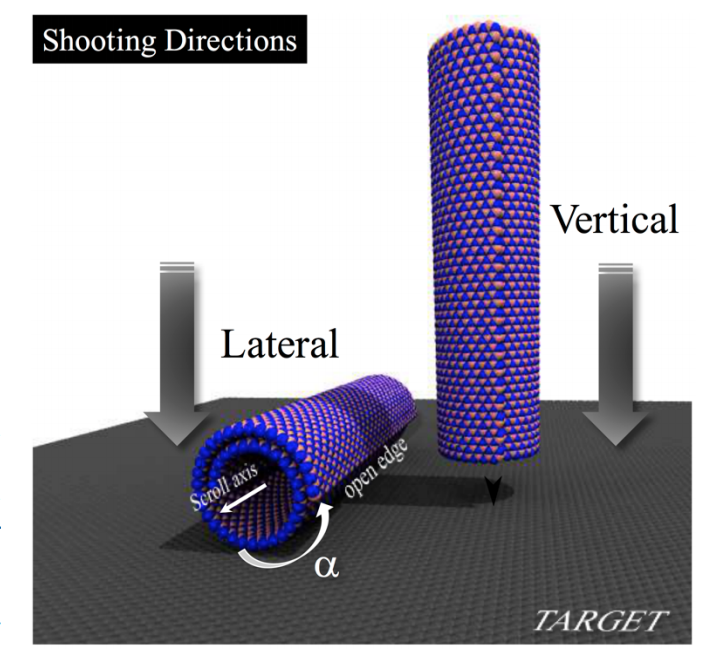
Leonardo D Machado Cristiano F Woellner, Pedro AS Autreto; Galvao, Douglas S
Structural Transformations of Carbon and Boron Nitride Nanoscrolls at High Impact Collisions Online
2017, (preprint ArXiv:1711.00378).
Abstract | Links | BibTeX | Tags: Fracture, impacts, Molecular Dynamics, Scrolls
@online{Woellner2017,
title = {Structural Transformations of Carbon and Boron Nitride Nanoscrolls at High Impact Collisions},
author = {Cristiano F Woellner, Leonardo D Machado, Pedro AS Autreto, Jose M de Sousa, and Douglas S Galvao},
url = {https://arxiv.org/pdf/1711.00378.pdf},
year = {2017},
date = {2017-11-01},
abstract = {The behavior of nanostructures under high strain-rate conditions has been object of theoretical and experimental investigations in recent years. For instance, it has been shown that carbon and boron nitride nanotubes can be unzipped into nanoribbons at high velocity impacts. However, the response of many nanostructures to high strain-rate conditions is still not completely understood. In this work we have investigated through fully atomistic reactive (ReaxFF) molecular dynamics (MD) simulations the mechanical behavior of carbon (CNS) and boron nitride nanoscrolls (BNS) colliding against solid targets at high velocities,. CNS (BNS) nanoscrolls are graphene (boron nitride) membranes rolled up into papyrus-like
structures. Their open-ended topology leads to unique properties not found in close-ended analogues, such as nanotubes.Our results show that the collision products are mainly determined by impact velocities and by two impact angles, which
define the position of the scroll (i) axis and (ii) open edge relative to the target. Our MD results showed that for appropriate velocities and orientations large-scale deformations and nanoscroll fracture can occur. We also observed unscrolling (scrolls going back to quasi-planar membranes), scroll unzipping into nanoribbons, and significant
reconstruction due to breaking and/or formation of new chemical bonds. For particular edge orientations and velocities, conversion from open to close-ended topology is also possible, due to the fusion of nanoscroll walls.},
note = {preprint ArXiv:1711.00378},
keywords = {Fracture, impacts, Molecular Dynamics, Scrolls},
pubstate = {published},
tppubtype = {online}
}
structures. Their open-ended topology leads to unique properties not found in close-ended analogues, such as nanotubes.Our results show that the collision products are mainly determined by impact velocities and by two impact angles, which
define the position of the scroll (i) axis and (ii) open edge relative to the target. Our MD results showed that for appropriate velocities and orientations large-scale deformations and nanoscroll fracture can occur. We also observed unscrolling (scrolls going back to quasi-planar membranes), scroll unzipping into nanoribbons, and significant
reconstruction due to breaking and/or formation of new chemical bonds. For particular edge orientations and velocities, conversion from open to close-ended topology is also possible, due to the fusion of nanoscroll walls.
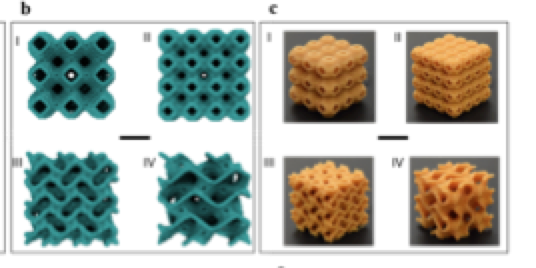
Sajadi, Seyed Mohammad; Owuor, Peter Samora; Schara, Steven; Woellner, Cristiano F.; Rodrigues, Varlei; Vajtai, Robert; Lou, Jun; Galvao, Douglas S.; Tiwary, Chandra Sekhar; Ajayan, Pulickel M.
Multi-scale Geometric Design Principles Applied to 3D Printed Schwartizes Journal Article
In: Advanced Materials, vol. 2017, pp. 1704820, 2017.
Abstract | Links | BibTeX | Tags: 3D printing, Mechanical Properties, Molecular Dynamics, Schwarzites
@article{Sajadi2017,
title = {Multi-scale Geometric Design Principles Applied to 3D Printed Schwartizes},
author = {Seyed Mohammad Sajadi and Peter Samora Owuor and Steven Schara and Cristiano F. Woellner and Varlei Rodrigues and Robert Vajtai and Jun Lou and Douglas S. Galvao and Chandra Sekhar Tiwary and Pulickel M. Ajayan},
url = {http://onlinelibrary.wiley.com/doi/10.1002/adma.201704820/full},
doi = {10.1002/adma.201704820},
year = {2017},
date = {2017-09-14},
journal = {Advanced Materials},
volume = {2017},
pages = {1704820},
abstract = {Schwartzites are 3D porous solids with periodic minimal surfaces having negative Gaussian curvatures and can possess unusual mechanical and electronic properties. The mechanical behavior of primitive and gyroid schwartzite structures across different length scales is investigated after these geometries are 3D printed at centimeter length scales based on molec- ular models. Molecular dynamics and nite elements simulations are used
to gain further understanding on responses of these complex solids under compressive loads and kinetic impact experiments. The results show that these structures hold great promise as high load bearing and impact-resistant materials due to a unique layered deformation mechanism that emerges in these architectures during loading. Easily scalable techniques such as 3D printing can be used for exploring mechanical behavior of various predicted complex geometrical shapes to build innovative engineered materials with tunable properties.},
keywords = {3D printing, Mechanical Properties, Molecular Dynamics, Schwarzites},
pubstate = {published},
tppubtype = {article}
}
to gain further understanding on responses of these complex solids under compressive loads and kinetic impact experiments. The results show that these structures hold great promise as high load bearing and impact-resistant materials due to a unique layered deformation mechanism that emerges in these architectures during loading. Easily scalable techniques such as 3D printing can be used for exploring mechanical behavior of various predicted complex geometrical shapes to build innovative engineered materials with tunable properties.
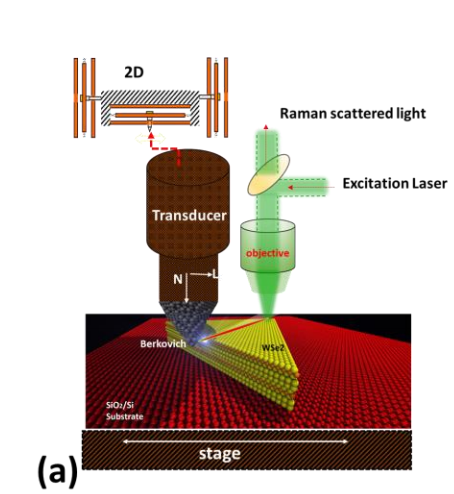
Manimunda, P; Nakanishi, Y; Jaques, YM; Susarla, S; Woellner, CF; Bhowmick, S; Asif, SAS; Galvao, DS; Tiwary, CS; Ajayan, PM
Nanoscale deformation and friction characteristics of atomically thin WSe2 and heterostructure using nanoscratch and Raman spectroscopy Journal Article
In: 2D Materials, vol. 4, no. 4, pp. 045005, 2017.
Abstract | Links | BibTeX | Tags: Chalcogenides, Heterostructures, Molecular Dynamics
@article{Manimunda2017,
title = {Nanoscale deformation and friction characteristics of atomically thin WSe2 and heterostructure using nanoscratch and Raman spectroscopy},
author = {Manimunda, P and Nakanishi, Y and Jaques, YM and Susarla, S and Woellner, CF and Bhowmick, S and Asif, SAS and Galvao, DS and Tiwary, CS and Ajayan, PM},
url = {http://iopscience.iop.org/article/10.1088/2053-1583/aa8475/meta},
doi = {10.1088/2053-1583/aa8475},
year = {2017},
date = {2017-08-23},
journal = {2D Materials},
volume = {4},
number = {4},
pages = {045005},
abstract = {2D transition metals di-selenides are attracting a lot of attention due to their interesting optical, chemical and electronics properties. Here, the deformation characteristics of monolayer, multi- layer WSe2 and its heterostructure with MoSe2 were investigated using a new technique that combines nanoscratch and Raman spectroscopy. The 2D monolayer WSe2 showed anisotropy in deformation. Effect of number of WSe2 layers on friction characteristics were explored in detail. Experimental observations were further supported by MD simulations. Raman spectra recorded from the scratched regions showed strain induced degeneracy splitting. Further nano-scale scratch tests were extended to MoSe2–WSe2 lateral heterostructures. Effect of deformation on lateral hetero junctions were further analysed using PL and Raman spectroscopy. This new technique is completely general and can be applied to study other 2D materials.},
keywords = {Chalcogenides, Heterostructures, Molecular Dynamics},
pubstate = {published},
tppubtype = {article}
}
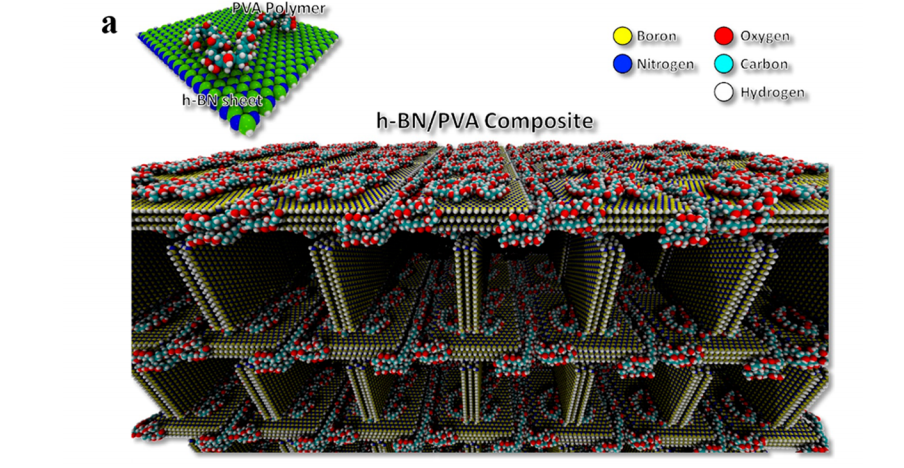
Owuor, Peter Samora; Park, Ok-Kyung; Woellner, Cristiano F; Jalilov, Almaz S; Susarla, Sandhya; Joyner, Jarin; Ozden, Sehmus; Duy, LuongXuan; Villegas Salvatierra, Rodrigo; Vajtai, Robert; Tour, James M; Lou, Jun; Galvao, Douglas S; Tiwary, Chandra S; Ajayan, P M
Lightweight Hexagonal Boron Nitride Foam for CO2 Absorption Journal Article
In: ACS Nano, vol. 11, no. 8, pp. 8944–8952, 2017.
Abstract | Links | BibTeX | Tags: foams, Mechanical Properties, Molecular Dynamics
@article{Owuor2017b,
title = {Lightweight Hexagonal Boron Nitride Foam for CO2 Absorption},
author = {Owuor, Peter Samora and Park, Ok-Kyung and Woellner, Cristiano F and Jalilov, Almaz S and Susarla, Sandhya and Joyner, Jarin and Ozden, Sehmus and Duy, LuongXuan and Villegas Salvatierra, Rodrigo and Vajtai, Robert and Tour, James M and Lou, Jun and Galvao, Douglas S and Tiwary, Chandra S and Ajayan, P M},
url = {http://pubs.acs.org/doi/abs/10.1021/acsnano.7b03291},
doi = {10.1021/acsnano.7b03291},
year = {2017},
date = {2017-08-03},
journal = {ACS Nano},
volume = {11},
number = {8},
pages = {8944–8952},
abstract = {Weak van der Waals forces between inert hexagonal boron nitride (h-BN) nanosheets make it easy for them to slide over each other, resulting in an unstable structure in macroscopic dimensions. Creating interconnections between these inert nanosheets can remarkably enhance their mechanical properties. However, controlled design of such interconnections remains a fundamental problem for many applications of h-BN foams. In this work, a scalable in situ freeze-drying synthesis of low-density, lightweight 3D macroscopic structures made of h-BN nanosheets chemically connected by poly(vinyl alcohol) (PVA) molecules via chemical cross-link is demonstrated. Unlike pristine h-BN foam which disintegrates upon handling after freeze-drying, h-BN/PVA foams exhibit stable mechanical integrity in addition to high porosity and large surface area. Fully atomistic simulations are used to understand the interactions between h-BN nanosheets and PVA molecules. In addition, the h-BN/PVA foam is investigated as a possible CO2 absorption and as laser irradiation protection material.
},
keywords = {foams, Mechanical Properties, Molecular Dynamics},
pubstate = {published},
tppubtype = {article}
}
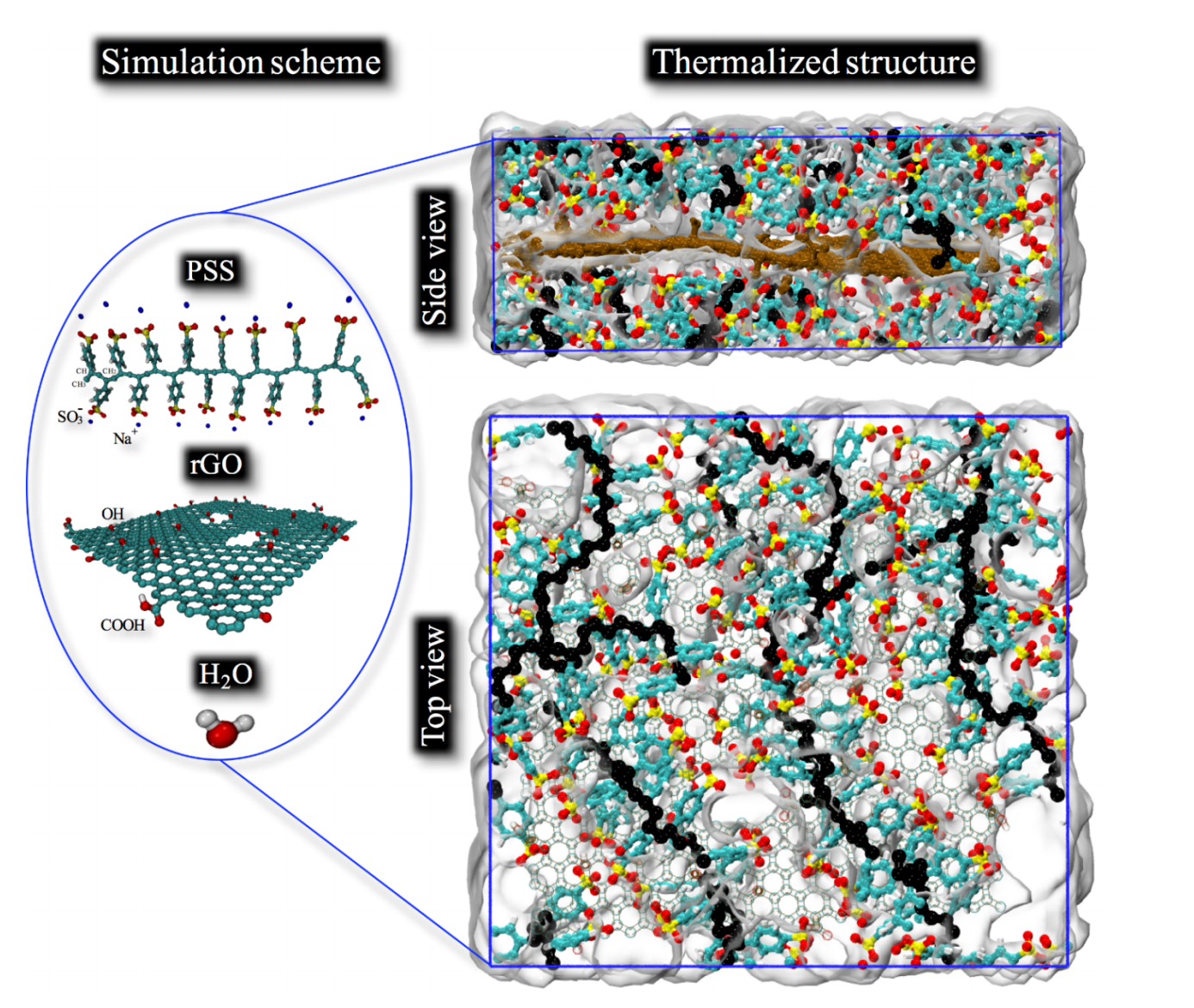
Miyazaki, Celina M; Maria, Marco AE; Borges, Daiane Damasceno; Woellner, Cristiano F; Brunetto, Gustavo; Fonseca, Alexandre F; Constantino, Carlos JL; Pereira-da-Silva, Marcelo A; de Siervo, Abner; Galvao, Douglas S; Riul Jr., Antonio
2017, (preprint arXiv:1702.00250).
Abstract | Links | BibTeX | Tags: Graphene, Molecular Dynamics, Polymers
@online{Miyazaki2017,
title = {Synthesis, characterization and computational simulation of graphene nanoplatelets stabilized in poly (styrene sulfonate) sodium salt},
author = {Miyazaki, Celina M and Maria, Marco AE and Borges, Daiane Damasceno and Woellner, Cristiano F and Brunetto, Gustavo and Fonseca, Alexandre F and Constantino, Carlos JL and Pereira-da-Silva, Marcelo A and de Siervo, Abner and Galvao, Douglas S and Riul Jr., Antonio},
url = {https://arxiv.org/abs/1705.10673},
year = {2017},
date = {2017-05-30},
abstract = {The production of large area interfaces and the use of scalable methods to build-up designed nanostructures generating advanced functional properties are of high interest for many materials science applications. Nevertheless, large area coverage remains a major problem for pristine graphene and here we present a hybrid, composite graphene-like material soluble in water, which can be exploited in many areas, such as energy storage, electrodes fabrication, selective membranes and biosensing. Graphene oxide (GO) was produced by the traditional Hummers method being further reduced in the presence of poly(styrene sulfonate) sodium salt (PSS), thus creating stable reduced graphene oxide (rGO) nanoplateles wrapped by PSS (GPSS). Molecular dynamics simulations were carried out of further clarify the interactions between PSS molecules and rGO nanoplatelets, with calculations supported by FTIR analysis. The intermolecular forces between rGO nanoplatelets and PSS lead to the formation of a hybrid material (GPSS) stabilized by van der Waals forces, allowing the fabrication of high quality layer-by-layer (LbL) films with polyalillamine hydrochloride (PAH). Raman and electrical characterizations corroborated the successful modifications in the electronic structures from GO to GPSS after the chemical treatment, resulting in (PAH/GPSS) LbL films four orders of magnitude more conductive than (PAH/GO).
},
note = {preprint arXiv:1702.00250},
keywords = {Graphene, Molecular Dynamics, Polymers},
pubstate = {published},
tppubtype = {online}
}
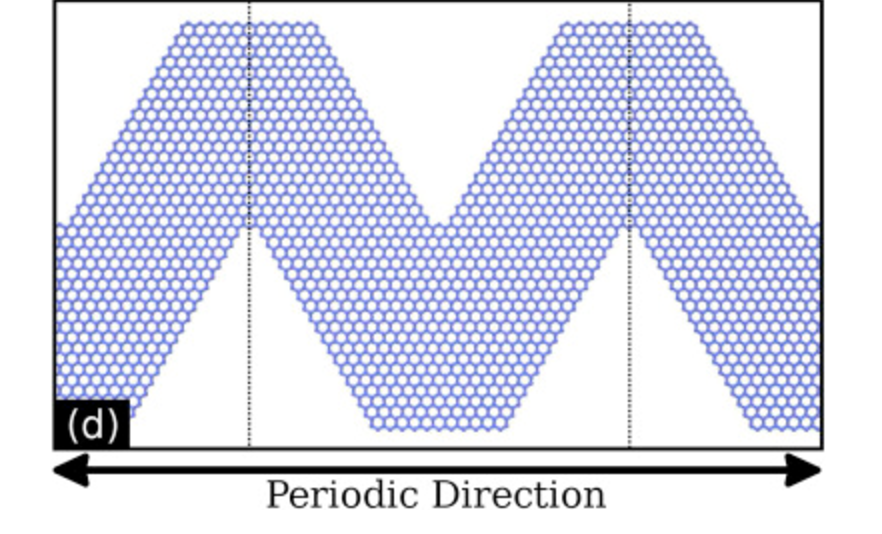
Bizao, Rafael A; Botari, Tiago; Perim, Eric; Pugno, Nicola M; Galvao, Douglas S
Mechanical properties and fracture patterns of graphene (graphitic) nanowiggles Journal Article
In: Carbon, vol. 119, pp. 431-437, 2017, (See also ArxIv version: https://arxiv.org/abs/1702.01100).
Abstract | Links | BibTeX | Tags: Graphene, Molecular Dynamics, NanoRibbons, Nanowiggles
@article{Bizao2017b,
title = {Mechanical properties and fracture patterns of graphene (graphitic) nanowiggles},
author = {Bizao, Rafael A and Botari, Tiago and Perim, Eric and Pugno, Nicola M and Galvao, Douglas S},
url = {http://www.sciencedirect.com/science/article/pii/S0008622317303743},
doi = {10.1016/j.carbon.2017.04.018},
year = {2017},
date = {2017-04-14},
journal = {Carbon},
volume = {119},
pages = {431-437},
abstract = {Graphene nanowiggles (GNW) are graphene-based nanostructures obtained by making alternated regular cuts in pristine graphene nanoribbons. GNW were recently synthesized and it was demonstrated that they exhibit tunable electronic and magnetic properties by just varying their shape. Here, we have investigated the mechanical properties and fracture patterns of a large number of GNW of different shapes and sizes using fully atomistic reactive molecular dynamics simulations. Our results show that the GNW mechanical properties are strongly dependent on its shape and size and, as a general trend narrow sheets have larger ultimate strength and Young's modulus than wide ones. The estimated Young's modulus values were found to be in a range of ≈100−1000 GPa and the ultimate strength in a range of ≈20−110 GPa, depending on GNW shape. Also, super-ductile behavior under strain was observed for some structures.},
note = {See also ArxIv version: https://arxiv.org/abs/1702.01100},
keywords = {Graphene, Molecular Dynamics, NanoRibbons, Nanowiggles},
pubstate = {published},
tppubtype = {article}
}
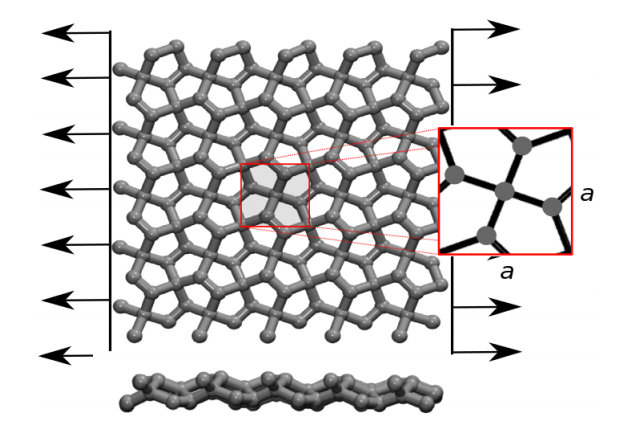
de Sousa, JM; Aguiar, AL; Girao, EC; Fonseca, Alexandre F; AG Filho, Souza; Galvao, Douglas S
Mechanical Properties and Fracture Patterns of Pentagraphene Membranes Online
2017, (preprint arXiv:1703.03789).
Abstract | Links | BibTeX | Tags: DFT, Mechanical Properties, Molecular Dynamics, pentagraphene
@online{deSousa2017,
title = {Mechanical Properties and Fracture Patterns of Pentagraphene Membranes},
author = {de Sousa, JM and Aguiar, AL and Girao, EC and Fonseca, Alexandre F and AG Filho, Souza and Galvao, Douglas S},
url = {https://arxiv.org/abs/1703.03789},
year = {2017},
date = {2017-03-10},
abstract = {Recently, a new two-dimensional carbon allotrope called pentagraphene (PG) was
proposed. PG exhibits mechanical and electronic interesting properties, including typical
band gap values of semiconducting materials. PG has a Cairo-tiling-like 2D lattice
of non coplanar pentagons and its mechanical properties have not been yet fully investigated.
In this work, we combined density functional theory (DFT) calculations and
reactive molecular dynamics (MD) simulations to investigate the mechanical properties
and fracture patterns of PG membranes under tensile strain. We show that PG
membranes can hold up to 20% of strain and that fracture occurs only after substantial
dynamical bond breaking and the formation of 7, 8 and 11 carbon rings and carbon
chains. The stress-strain behavior was observed to follow two regimes, one exhibiting linear elasticity followed by a plastic one, involving carbon atom re-hybridization with
the formation of carbon rings and chains. Our results also show that mechanically
induced structural transitions from PG to graphene is unlikely to occur, in contrast to
what was previously speculated in the literature.},
note = {preprint arXiv:1703.03789},
keywords = {DFT, Mechanical Properties, Molecular Dynamics, pentagraphene},
pubstate = {published},
tppubtype = {online}
}
proposed. PG exhibits mechanical and electronic interesting properties, including typical
band gap values of semiconducting materials. PG has a Cairo-tiling-like 2D lattice
of non coplanar pentagons and its mechanical properties have not been yet fully investigated.
In this work, we combined density functional theory (DFT) calculations and
reactive molecular dynamics (MD) simulations to investigate the mechanical properties
and fracture patterns of PG membranes under tensile strain. We show that PG
membranes can hold up to 20% of strain and that fracture occurs only after substantial
dynamical bond breaking and the formation of 7, 8 and 11 carbon rings and carbon
chains. The stress-strain behavior was observed to follow two regimes, one exhibiting linear elasticity followed by a plastic one, involving carbon atom re-hybridization with
the formation of carbon rings and chains. Our results also show that mechanically
induced structural transitions from PG to graphene is unlikely to occur, in contrast to
what was previously speculated in the literature.
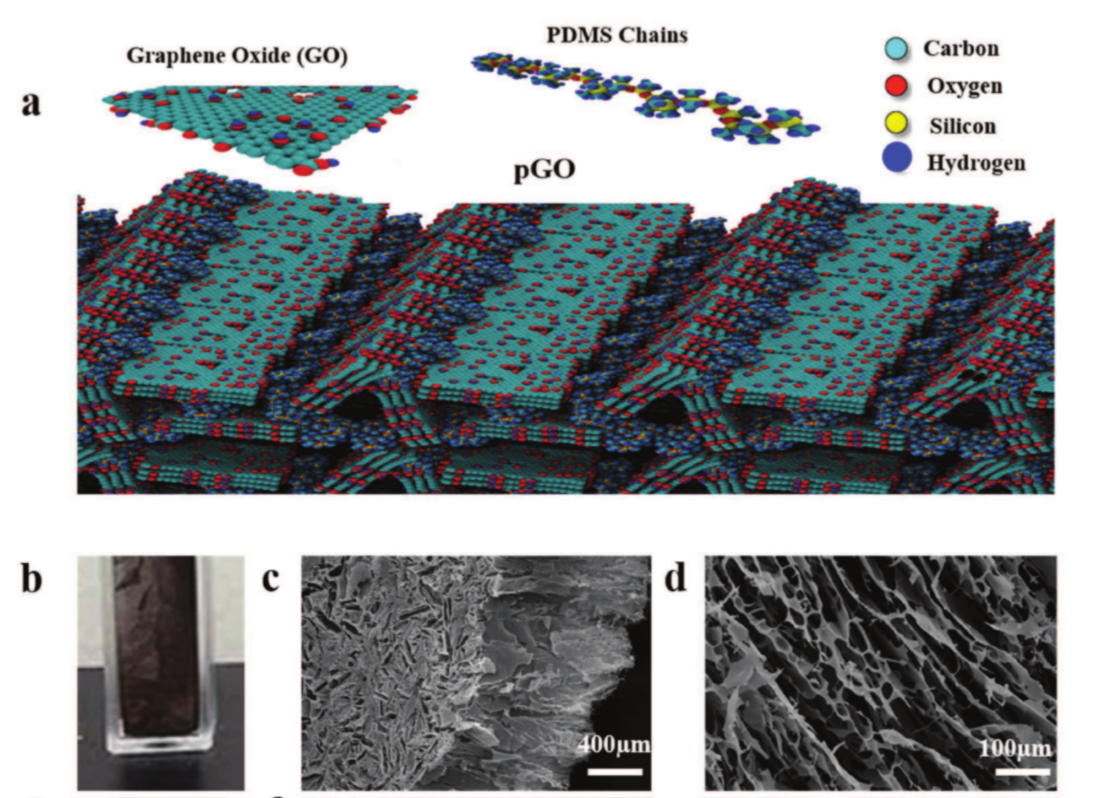
Cristiano F Woellner Peter Samora Owuor, Tong Li
High Toughness in Ultralow Density Graphene Oxide Foam Journal Article
In: Advanced Materials Interfaces, vol. 4, no. 10, pp. 1700030, 2017.
Abstract | Links | BibTeX | Tags: foams, graphene oxide, Mechanical Properties, Molecular Dynamics
@article{Owuor2017,
title = {High Toughness in Ultralow Density Graphene Oxide Foam},
author = {Peter Samora Owuor, Cristiano F Woellner, Tong Li, Soumya Vinod, Sehmus Ozden, Suppanat Kosolwattana, Sanjit Bhowmick, Luong Xuan Duy, Rodrigo V Salvatierra, Bingqing Wei, Syed AS Asif, James M Tour, Robert Vajtai, Jun Lou, Douglas S Galvão, Chandra Sekhar Tiwary, Pulickel Ajayan},
url = {http://onlinelibrary.wiley.com/doi/10.1002/admi.201700030/abstract },
doi = {10.1002/admi.201700030},
year = {2017},
date = {2017-03-01},
journal = {Advanced Materials Interfaces},
volume = {4},
number = {10},
pages = {1700030},
abstract = {Here, the scalable synthesis of low-density 3D macroscopic structure of graphene oxide (GO) interconnected with polydimethylsiloxane (PDMS) is reported. A controlled amount of PDMS is infused into the freeze-dried foam to result into a very rigid structure with improved mechanical properties, such as tensile plasticity and toughness. The PDMS wets the graphene oxide sheets and acts like glue between the 2D sheets. Molecular dynamics simulations are used to further elucidate the mechanisms of the interactions of graphene oxide layers with PDMS. The ability of using the interconnecting graphene oxide foam as an effective oil–water separator and stable insulating behavior to elevated temperatures are further demonstrated. The structural rigidity of the sample is also tested using laser impact and compared with GO foam.},
keywords = {foams, graphene oxide, Mechanical Properties, Molecular Dynamics},
pubstate = {published},
tppubtype = {article}
}
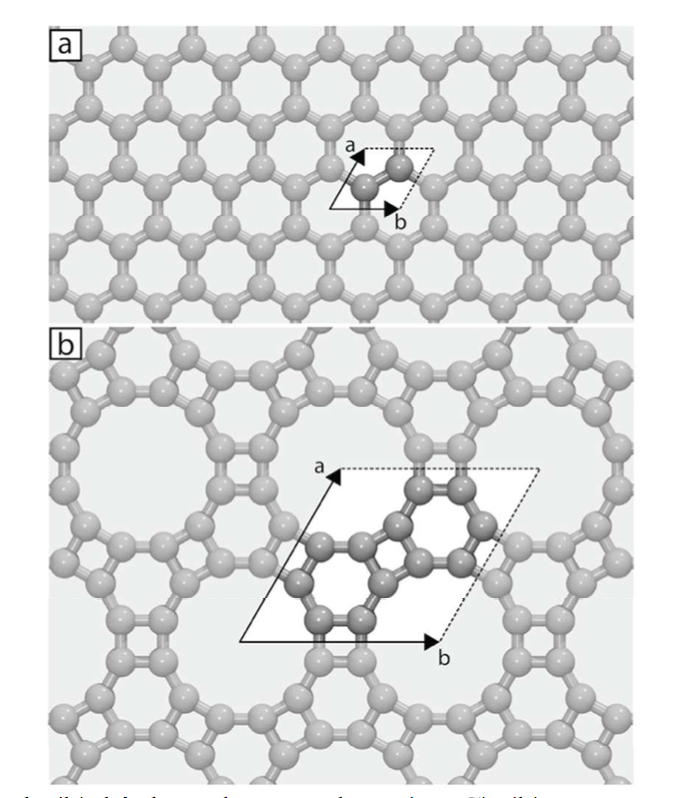
Splugues, Vinicius; da Silva Autreto, Pedro Alves; Galvao, Douglas S
Hydrogenation Dynamics of Biphenylene Carbon (Graphenylene) Membranes Journal Article
In: MRS Advances, vol. 2017, pp. 1-6, 2017.
Abstract | Links | BibTeX | Tags: Graphene, Hydrogenation, Molecular Dynamics
@article{Splugues2017,
title = {Hydrogenation Dynamics of Biphenylene Carbon (Graphenylene) Membranes},
author = {Splugues, Vinicius and da Silva Autreto, Pedro Alves and Galvao, Douglas S},
url = {https://www.cambridge.org/core/journals/mrs-advances/article/hydrogenation-dynamics-of-biphenylene-carbon-graphenylene-membranes/139DB900D41560D64F352A31CE219D3A},
doi = {10.1557/adv.2017.239},
year = {2017},
date = {2017-02-28},
journal = {MRS Advances},
volume = {2017},
pages = {1-6},
abstract = {The advent of graphene created a revolution in materials science. Because of this there is a renewed interest in other carbon-based structures. Graphene is the ultimate (just one atom thick) membrane. It has been proposed that graphene can work as impermeable membrane to standard gases, such argon and helium. Graphene-like porous membranes, but presenting larger porosity and potential selectivity would have many technological applications. Biphenylene carbon (BPC), sometimes called graphenylene, is one of these structures. BPC is a porous two-dimensional (planar) allotrope carbon, with its pores resembling typical sieve cavities and/or some kind of zeolites. In this work, we have investigated the hydrogenation dynamics of BPC membranes under different conditions (hydrogenation plasma density, temperature, etc.). We have carried out an extensive study through fully atomistic molecular dynamics (MD) simulations using the reactive force field ReaxFF, as implemented in the well-known Large-scale Atomic/Molecular Massively Parallel Simulator (LAMMPS) code. Our results show that the BPC hydrogenation processes exhibit very complex patterns and the formation of correlated domains (hydrogenated islands) observed in the case of graphene hydrogenation was also observed here. MD results also show that under hydrogenation BPC structure undergoes a change in its topology, the pores undergoing structural transformations and extensive hydrogenation can produce significant structural damages, with the formation of large defective areas and large structural holes, leading to structural collapse.
},
keywords = {Graphene, Hydrogenation, Molecular Dynamics},
pubstate = {published},
tppubtype = {article}
}
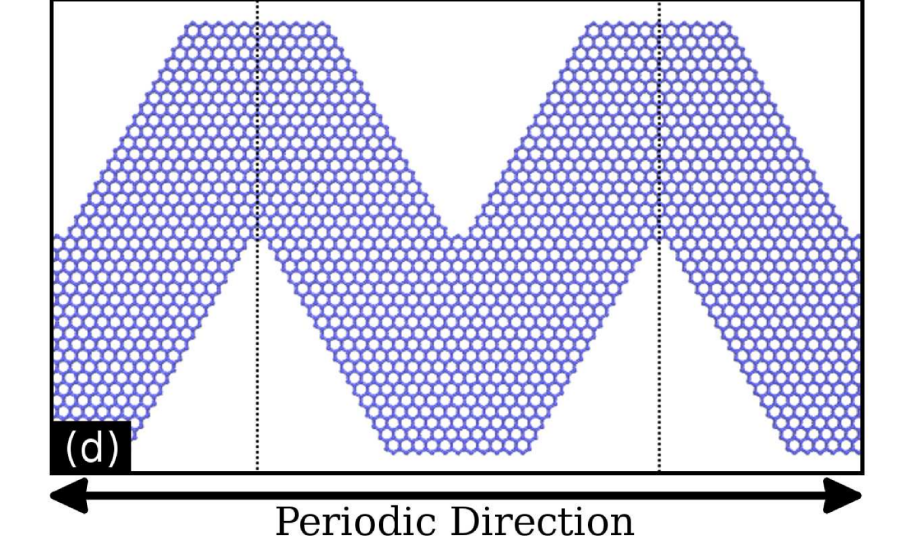
Bizao, Rafael A; Botari, Tiago; Perim, Eric; Pugno, Nicola M; Galvao, Douglas S
Mechanical Properties and Fracture Patterns of Graphene (Graphitic) Nanowiggles Online
2017, (preprint arXiv:1702.01100).
Abstract | Links | BibTeX | Tags: Graphene, Mechanical Properties, Molecular Dynamics, Nanowiggles
@online{Bizao2017,
title = {Mechanical Properties and Fracture Patterns of Graphene (Graphitic) Nanowiggles},
author = {Bizao, Rafael A and Botari, Tiago and Perim, Eric and Pugno, Nicola M and Galvao, Douglas S},
url = {https://arxiv.org/pdf/1702.01100.pdf},
year = {2017},
date = {2017-02-03},
abstract = {Graphene nanowiggles (GNW) are graphene-based nanostructures
obtained by making alternated regular cuts in pristine graphene nanoribbons.
GNW were recently synthesized and it was demonstrated that
they exhibit tunable electronic and magnetic properties by just varying
their shape. Here, we have investigated the mechanical properties and
fracture patterns of a large number of GNW of different shapes and
sizes using fully atomistic reactive molecular dynamics simulations.
Our results show that the GNW mechanical properties are strongly
dependent on its shape and size and, as a general trend narrow sheets
have larger ultimate strength and Young’s modulus than wide ones.
The estimated Young’s modulus values were found to be in a range of
≈ 100 − 1000 GPa and the ultimate strength in a range of ≈ 20 − 110
GPa, depending on GNW shape. Also, super-ductile behaviour under
strain was observed for some structures.},
note = {preprint arXiv:1702.01100},
keywords = {Graphene, Mechanical Properties, Molecular Dynamics, Nanowiggles},
pubstate = {published},
tppubtype = {online}
}
obtained by making alternated regular cuts in pristine graphene nanoribbons.
GNW were recently synthesized and it was demonstrated that
they exhibit tunable electronic and magnetic properties by just varying
their shape. Here, we have investigated the mechanical properties and
fracture patterns of a large number of GNW of different shapes and
sizes using fully atomistic reactive molecular dynamics simulations.
Our results show that the GNW mechanical properties are strongly
dependent on its shape and size and, as a general trend narrow sheets
have larger ultimate strength and Young’s modulus than wide ones.
The estimated Young’s modulus values were found to be in a range of
≈ 100 − 1000 GPa and the ultimate strength in a range of ≈ 20 − 110
GPa, depending on GNW shape. Also, super-ductile behaviour under
strain was observed for some structures.
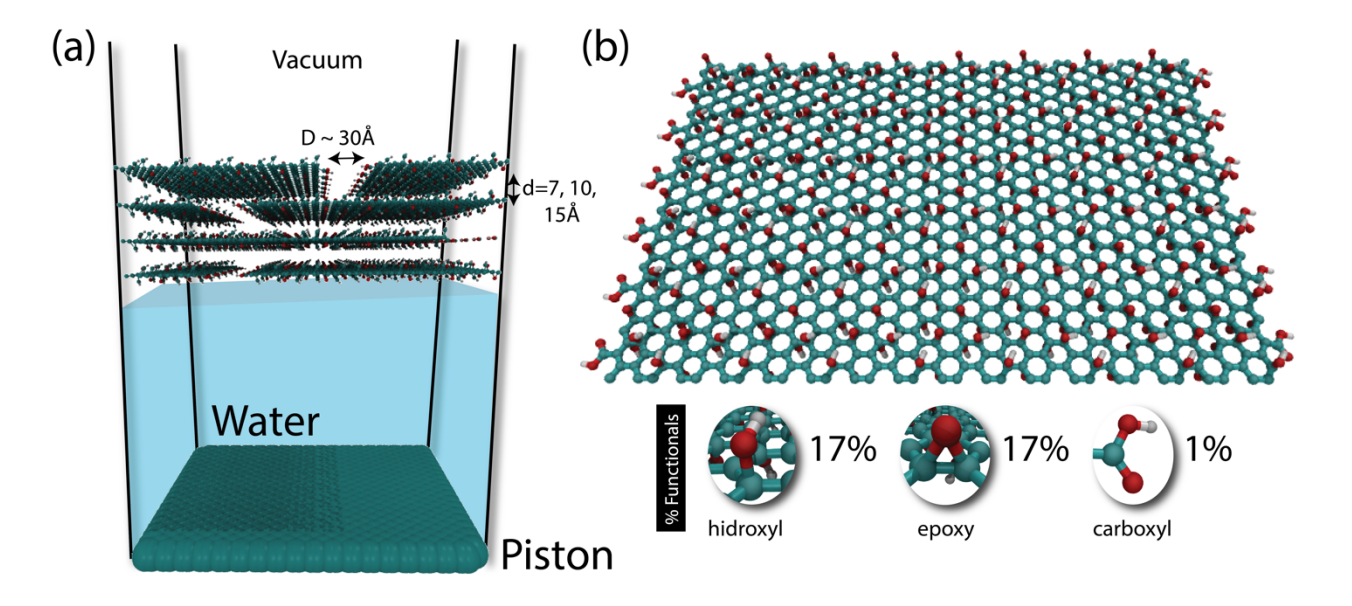
Borges, Daiane D; Woellner, Cristiano F; Autreto, Pedro AS; Galvao, Douglas S
2017, (preprint arXiv:1702.00250).
Abstract | Links | BibTeX | Tags: Graphene, Molecular Dynamics, water
@online{Borges2017,
title = {Water Permeation through Layered Graphene-based Membranes: A Fully Atomistic Molecular Dynamics Investigation},
author = {Borges, Daiane D and Woellner, Cristiano F and Autreto, Pedro AS and Galvao, Douglas S},
url = {https://arxiv.org/abs/1702.00250},
year = {2017},
date = {2017-02-01},
abstract = {Graphene-based membranes have been investigated as promising candidates for water
filtration and gas separation applications. Experimental evidences have shown that graphene
oxide can be impermeable to liquids, vapors and gases, while allowing a fast permeation of water
molecules. This phenomenon has been attributed to the formation of a network of nano
capillaries that allow nearly frictionless water flow while blocking other molecules by steric
hindrance effects. It is supposed that water molecules are transported through the percolated twodimensional
channels formed between graphene-based sheets. Although these channels allow
fast water permeation in such materials, the flow rates are strongly dependent on how the
membranes are fabricated. Also, some fundamental issues regarding the nanoscale mechanisms
of water permeation are still not fully understood and their interpretation remains controversial.
In this work, we have investigated the dynamics of water permeation through pristine graphene
and graphene oxide model membranes. We have carried out fully atomistic classical molecular
dynamics simulations of systems composed of multiple layered graphene-based sheets into
contact with a water reservoir under controlled thermodynamics conditions (e. g., by varying
temperature and pressure values). We have systematically analyzed how the transport dynamics
of the confined nanofluids depend on the interlayer distances and the role of the oxide functional
groups. Our results show the water flux is much more effective for graphene than for graphene
oxide membranes. These results are attributed to the H-bonds formation between oxide
functional groups and water, which traps the water molecules and precludes ultrafast water
transport through the nanochannels.},
note = {preprint arXiv:1702.00250},
keywords = {Graphene, Molecular Dynamics, water},
pubstate = {published},
tppubtype = {online}
}
filtration and gas separation applications. Experimental evidences have shown that graphene
oxide can be impermeable to liquids, vapors and gases, while allowing a fast permeation of water
molecules. This phenomenon has been attributed to the formation of a network of nano
capillaries that allow nearly frictionless water flow while blocking other molecules by steric
hindrance effects. It is supposed that water molecules are transported through the percolated twodimensional
channels formed between graphene-based sheets. Although these channels allow
fast water permeation in such materials, the flow rates are strongly dependent on how the
membranes are fabricated. Also, some fundamental issues regarding the nanoscale mechanisms
of water permeation are still not fully understood and their interpretation remains controversial.
In this work, we have investigated the dynamics of water permeation through pristine graphene
and graphene oxide model membranes. We have carried out fully atomistic classical molecular
dynamics simulations of systems composed of multiple layered graphene-based sheets into
contact with a water reservoir under controlled thermodynamics conditions (e. g., by varying
temperature and pressure values). We have systematically analyzed how the transport dynamics
of the confined nanofluids depend on the interlayer distances and the role of the oxide functional
groups. Our results show the water flux is much more effective for graphene than for graphene
oxide membranes. These results are attributed to the H-bonds formation between oxide
functional groups and water, which traps the water molecules and precludes ultrafast water
transport through the nanochannels.
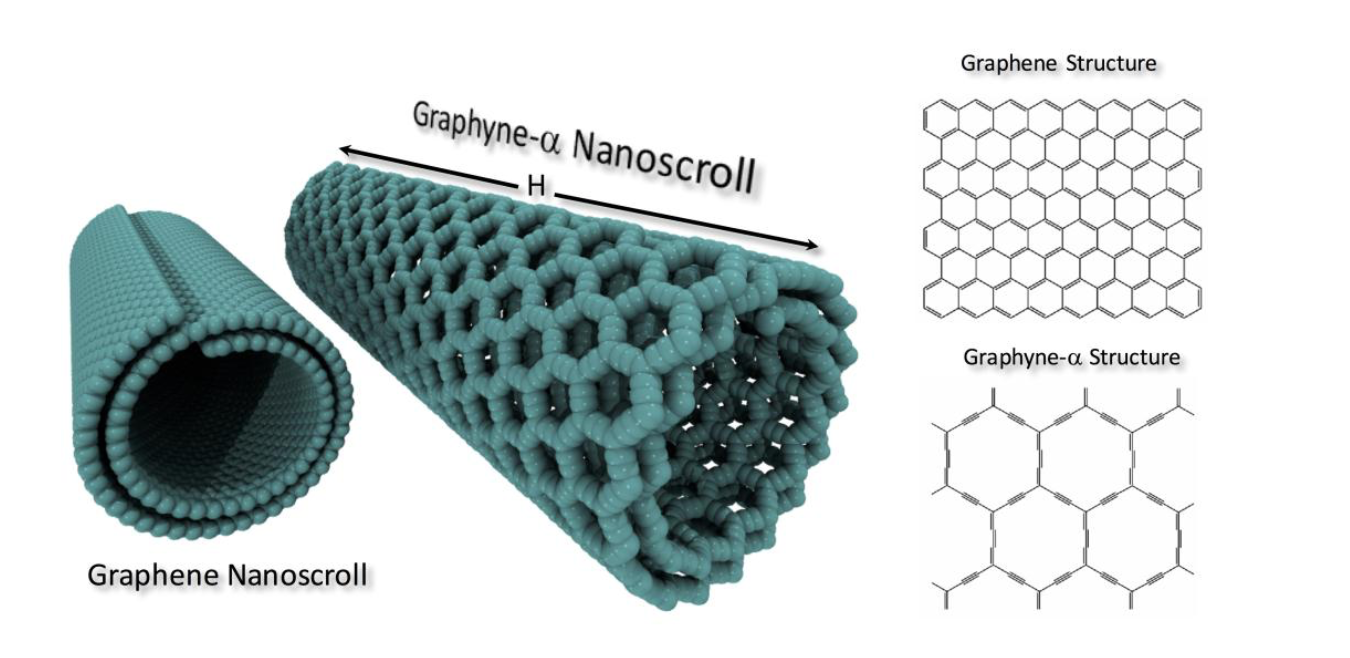
Solis, Daniel; Woellner, Cristiano F; Borges, Daiane D; Galvao, Douglas S
Mechanical and Thermal Stability of Graphyne and Graphdiyne Nanoscrolls Journal Article
In: MRS Advances, vol. 2017, pp. 129-134, 2017.
Abstract | Links | BibTeX | Tags: graphdiyne, Graphyne, Molecular Dynamics, Scrolls
@article{Solis2017,
title = {Mechanical and Thermal Stability of Graphyne and Graphdiyne Nanoscrolls},
author = {Solis, Daniel and Woellner, Cristiano F and Borges, Daiane D and Galvao, Douglas S},
url = {https://www.cambridge.org/core/journals/mrs-advances/article/mechanical-and-thermal-stability-of-graphyne-and-graphdiyne-nanoscrolls/202E7B7C471411200DE9D05C264726B8},
doi = {10.1557/adv.2017.130},
year = {2017},
date = {2017-02-01},
journal = {MRS Advances},
volume = {2017},
pages = {129-134},
abstract = {Graphynes and graphdiynes are carbon 2D allotrope structures presenting both sp2 and sp hybridized atoms. These materials have been theoretically predicted but due to intrinsic difficulties in their synthesis, only recently some of these structures have been experimentally realized. Graphyne nanoscrolls are structures obtained by rolling up graphyne sheets into papyrus-like structures. In this work, we have investigated, through fully atomistic reactive molecular dynamics simulations, the dynamics of nanoscroll formation for a series of graphyne (α, β, and δ types) structures. We have also investigated their thermal stability for a temperature range of 200-1000K. Our results show that stable nanoscrolls can be formed for all structures considered here. Their stability depends on a critical value of the ratio between length and height of the graphyne sheets. Our findings also show that these structures are structurally less stable then graphene-based nanoscrolls. This can be explained by the graphyne higher structural porosity which results in a decreased pi-pi stacking interactions.},
keywords = {graphdiyne, Graphyne, Molecular Dynamics, Scrolls},
pubstate = {published},
tppubtype = {article}
}
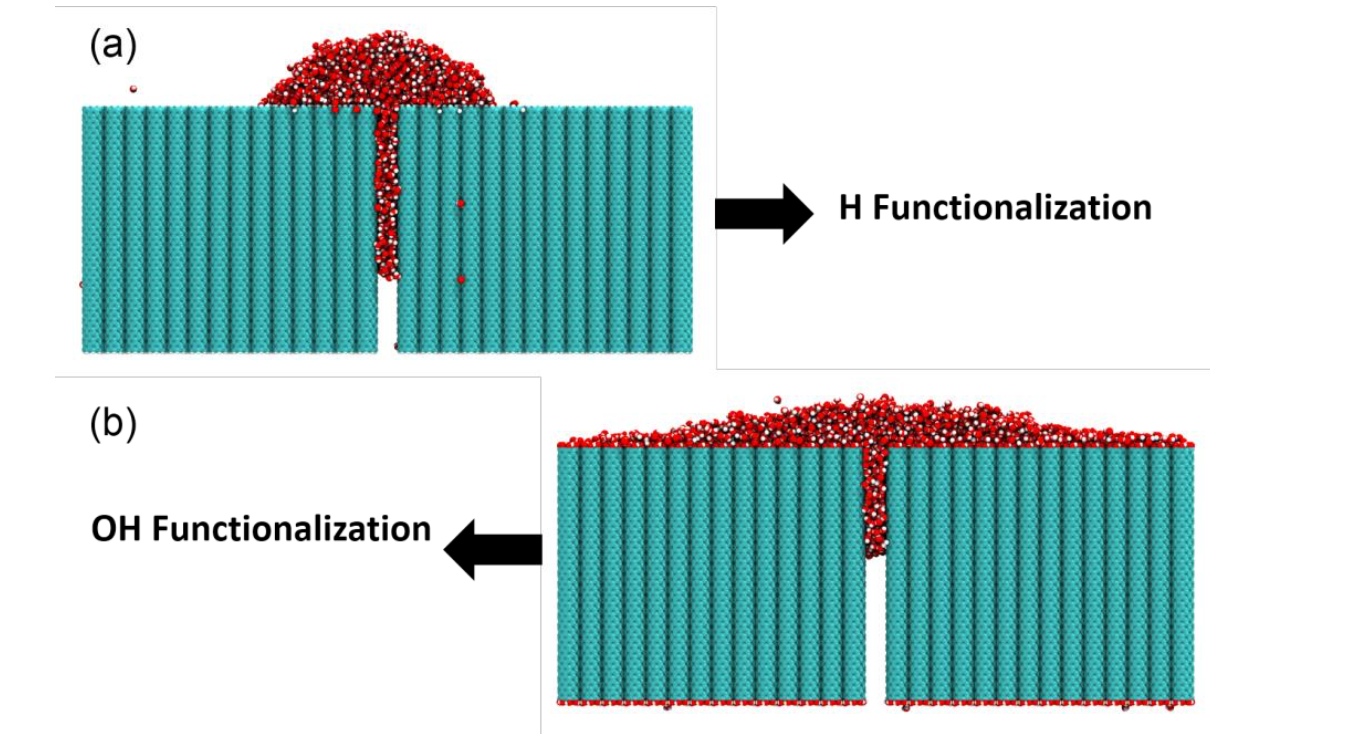
Jaques, Ygor M; Galvao, Douglas S
Permeation of Water Nanodroplets on Carbon Nanotubes Forests Journal Article
In: MRS Advances, vol. 2017, pp. 123-128, 2017.
Abstract | Links | BibTeX | Tags: cnt forests, Droplet, Molecular Dynamics
@article{Jaques2017b,
title = {Permeation of Water Nanodroplets on Carbon Nanotubes Forests},
author = {Jaques, Ygor M and Galvao, Douglas S},
url = {https://www.cambridge.org/core/journals/mrs-advances/article/permeation-of-water-nanodroplets-on-carbon-nanotubes-forests/99C67F3DC0AD10DB1A4580CC8CEFDF58},
doi = {10.1557/adv.2017.129},
year = {2017},
date = {2017-01-31},
journal = {MRS Advances},
volume = {2017},
pages = {123-128},
abstract = {Fully atomistic molecular dynamics simulations were carried out to investigate how a liquid-like water droplet behaves when into contact with a nanopore formed by carbon nanotube arrays. We have considered different tube arrays, varying the spacing between them, as well as, different chemical functionalizations on the uncapped nanotubes. Our results show that simple functionalizations (for instance, hydrogen ones) allow tuning up the wetting surface properties increasing the permeation of liquid inside the nanopore. For functionalizations that increase the surface hydrophilicity, even when the pore size is significantly increased the droplet remains at the surface without tube permeation.
},
keywords = {cnt forests, Droplet, Molecular Dynamics},
pubstate = {published},
tppubtype = {article}
}
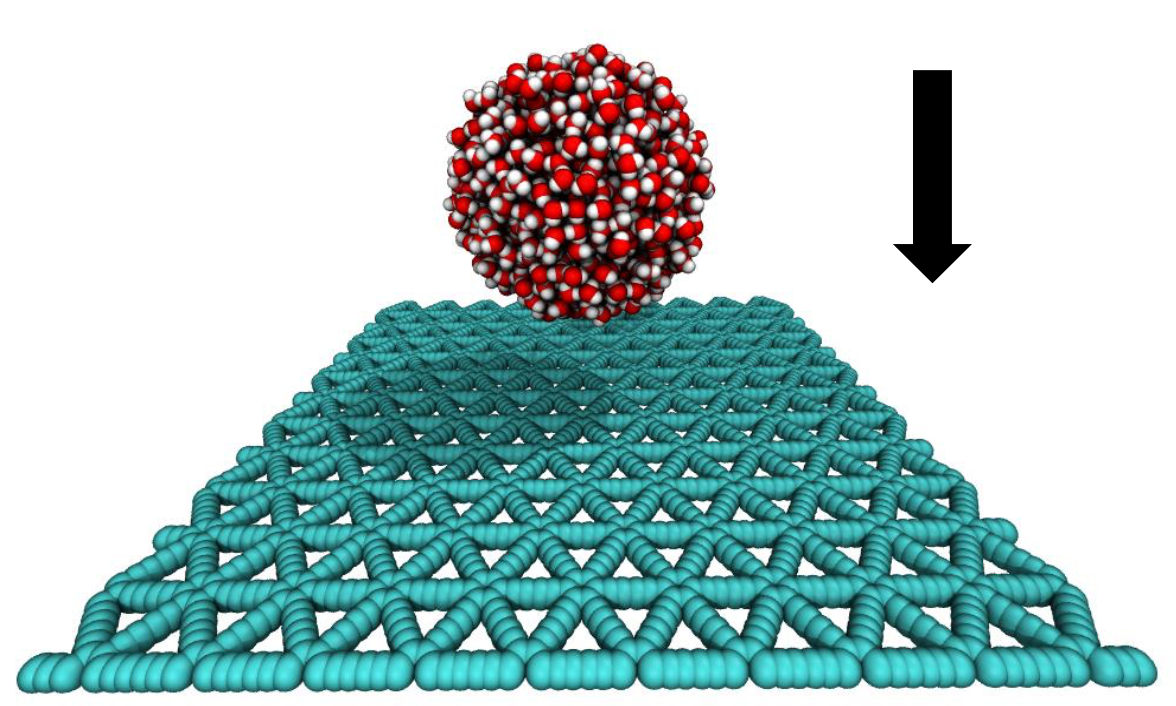
Jaques, Ygor M; Galvao, Douglas S
Nanodroplets Behavior on Graphdiyne Membranes Journal Article
In: MRS Advances, vol. 2017, pp. 1-6, 2017.
Abstract | Links | BibTeX | Tags: Droplet, graphdiynes, Molecular Dynamics, water
@article{Jaques2017,
title = {Nanodroplets Behavior on Graphdiyne Membranes},
author = {Jaques, Ygor M and Galvao, Douglas S},
url = {https://www.cambridge.org/core/journals/mrs-advances/article/nanodroplets-behavior-on-graphdiyne-membranes/16AD56CAD07570E7F4F194A56E9680C3},
doi = {10.1557/adv.2017.128},
year = {2017},
date = {2017-01-30},
journal = {MRS Advances},
volume = {2017},
pages = {1-6},
abstract = {In this work we have investigated, by fully atomistic reactive (force field ReaxFF) molecular dynamics simulations, some aspects of impact dynamics of water nanodroplets on graphdiyne-like membranes. We simulated graphdiyne-supported membranes impacted by nanodroplets at different velocities (from 100 up to 1500 m/s). The results show that due to the graphdiyne porous and elastic structure, the droplets present an impact dynamics very complex in relation to the ones observed for graphene membranes. Under impact the droplets spread over the surface with a maximum contact radius proportional to the impact velocity. Depending on the energy impact value, a number of water molecules were able to percolate the nanopore sheets. However, even in these cases the droplet shape is preserved and the main differences between the different impact velocities cases reside on the splashing pattern at the maximum spreading.},
keywords = {Droplet, graphdiynes, Molecular Dynamics, water},
pubstate = {published},
tppubtype = {article}
}
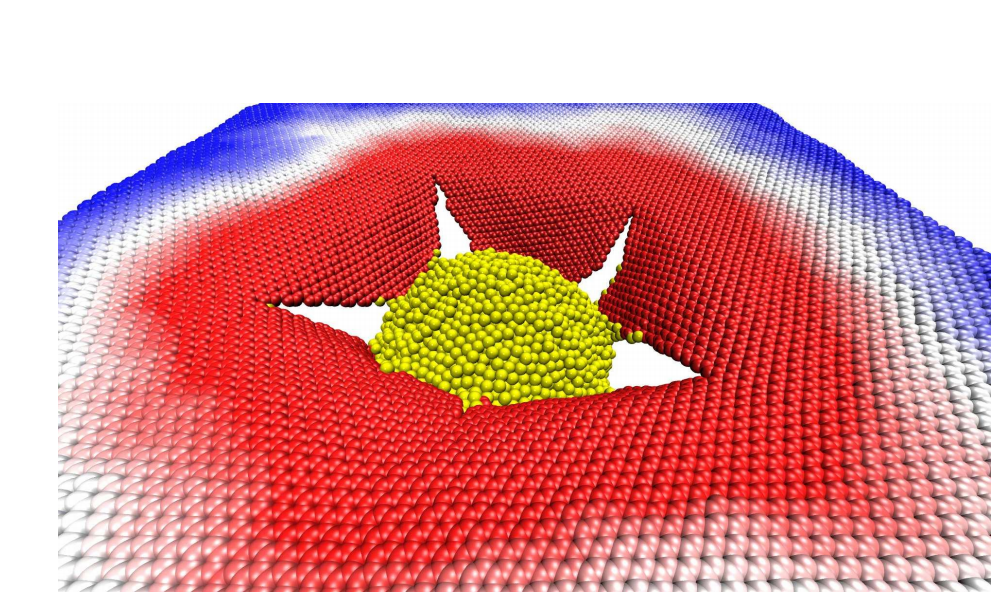
Bizao, Rafael A; Machado, Leonardo D; de Sousa, Jose M; Pugno, Nicola M; Galvao, Douglas S
Scale Effects on the Ballistic Penetration of Graphene Sheets Online
2017, (preprint arXiv:1701.07367).
Abstract | Links | BibTeX | Tags: ballistic impacts, Fracture, Graphene, Molecular Dynamics
@online{Bizao2017c,
title = {Scale Effects on the Ballistic Penetration of Graphene Sheets},
author = {Bizao, Rafael A and Machado, Leonardo D and de Sousa, Jose M and Pugno, Nicola M and Galvao, Douglas S},
url = {https://arxiv.org/pdf/1701.07367.pdf},
year = {2017},
date = {2017-01-25},
abstract = {Carbon nanostructures are promising ballistic protection materials,
due to their low density and excellent mechanical properties. Recent
experimental and computational investigations on the behavior
of graphene under impact conditions revealed exceptional energy absorption
properties as well. However, the reported numerical and experimental
values differ by an order of magnitude. In this work, we
combined numerical and analytical modeling to address this issue. In
the numerical part, we employed reactive molecular dynamics to carry
out ballistic tests on single and double-layered graphene sheets. We
used velocity values within the range tested in experiments. Our numerical
and the experimental results were used to determine parameters
for a scaling law, which is in good agreement with all experimental
and simulation results. We find that the specific penetration energy
decreases as the number of layers (N) increases, from ∼ 25 MJ/kg for
N = 1 to ∼ 0.26 MJ/kg as N → ∞. These scale effects explain the
apparent discrepancy between simulations and experiments.},
note = {preprint arXiv:1701.07367},
keywords = {ballistic impacts, Fracture, Graphene, Molecular Dynamics},
pubstate = {published},
tppubtype = {online}
}
due to their low density and excellent mechanical properties. Recent
experimental and computational investigations on the behavior
of graphene under impact conditions revealed exceptional energy absorption
properties as well. However, the reported numerical and experimental
values differ by an order of magnitude. In this work, we
combined numerical and analytical modeling to address this issue. In
the numerical part, we employed reactive molecular dynamics to carry
out ballistic tests on single and double-layered graphene sheets. We
used velocity values within the range tested in experiments. Our numerical
and the experimental results were used to determine parameters
for a scaling law, which is in good agreement with all experimental
and simulation results. We find that the specific penetration energy
decreases as the number of layers (N) increases, from ∼ 25 MJ/kg for
N = 1 to ∼ 0.26 MJ/kg as N → ∞. These scale effects explain the
apparent discrepancy between simulations and experiments.
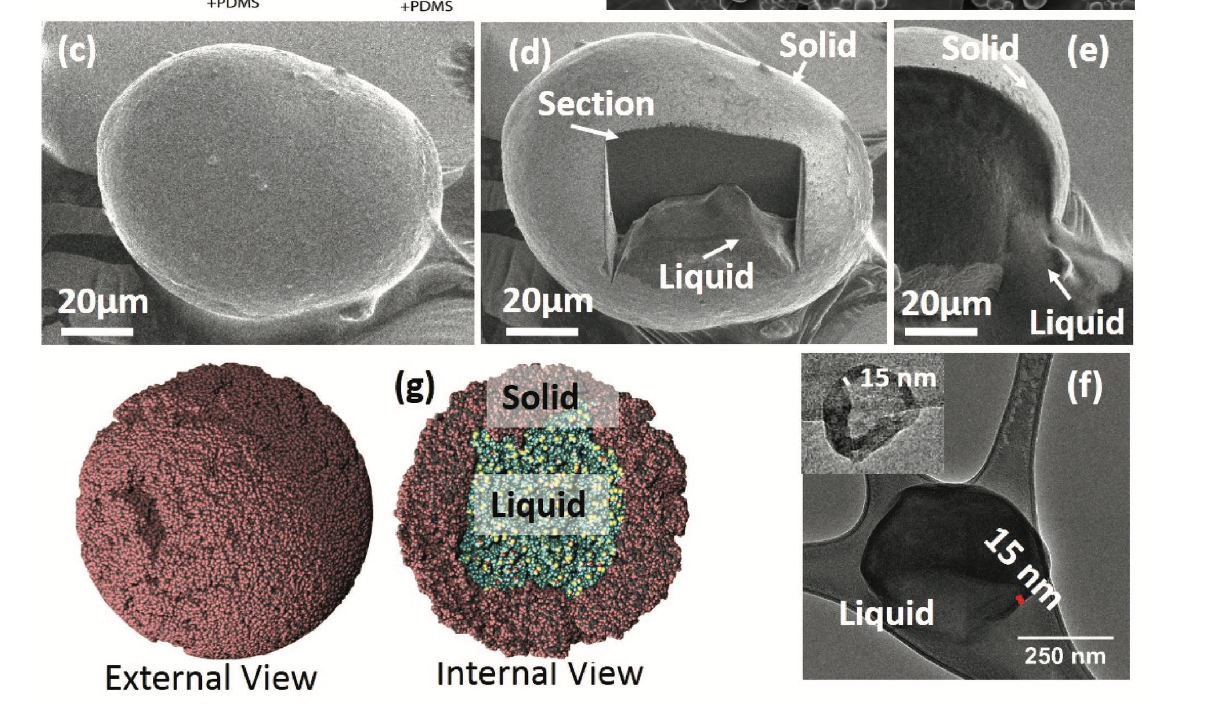
Peter Samora Owuor Alin Cristian Chipara, Sanjit Bhowmick
Structural Reinforcement through Liquid Encapsulation Journal Article
In: Advanced Materials Interfaces, vol. 4, pp. 1600781, 2017.
Abstract | Links | BibTeX | Tags: Mechanical Properties, Molecular Dynamics, solid-liquid interfaces
@article{Chipara2017,
title = {Structural Reinforcement through Liquid Encapsulation},
author = {Alin Cristian Chipara, Peter Samora Owuor, Sanjit Bhowmick, Gustavo Brunetto, SA Asif, Mircea Chipara, Robert Vajtai, Jun Lou, Douglas S Galvao, Chandra Sekhar Tiwary, Pulickel M Ajayan},
url = {http://onlinelibrary.wiley.com/doi/10.1002/admi.201600781/full},
doi = {10.1002/admi.201600781},
year = {2017},
date = {2017-01-23},
journal = {Advanced Materials Interfaces},
volume = {4},
pages = {1600781},
abstract = {The liquid inside a solid material is one of the most common composite materials in nature. The interface between solid–liquid plays an important role in unique deformation. Here, model systems of two polymers (polydimethylsiloxane–polyvinylidenefluoride) are used to make sphere of solid with liquid inside it.},
keywords = {Mechanical Properties, Molecular Dynamics, solid-liquid interfaces},
pubstate = {published},
tppubtype = {article}
}
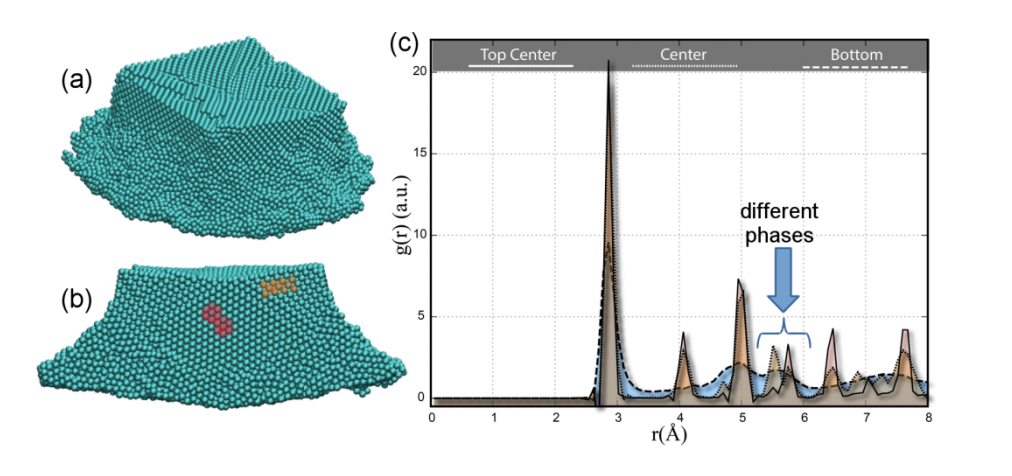
Oliveira, Eliezer Fernando; Pedro Alves da Silva Autreto,; Galvao, Douglas Soares
Silver Hardening via Hypersonic Impacts Online
2017, (preprint arXiv:1801.04780).
Abstract | Links | BibTeX | Tags: Fracture, impact, Molecular Dynamics, silver
@online{Oliveira2017,
title = {Silver Hardening via Hypersonic Impacts},
author = {Eliezer Fernando Oliveira and Pedro Alves da Silva Autreto, and Douglas Soares Galvao},
url = {https://arxiv.org/abs/1801.04780},
year = {2017},
date = {2017-01-15},
abstract = {The search for new ultra strong materials has been a very active research area. With relation
to metals, a successful way to improve their strength is by the creation of a gradient of
nanograins (GNG) inside the material. Recently, R. Thevamaran et al. [Science v354, 312-
316 (2016)] propose a single step method based on high velocity impact of silver nanocubes
to produce high-quality GNG. This method consists of producing high impact collisions of
silver cubes at hypersonic velocity (~400 m/s) against a rigid wall. Although they observed an
improvement in the mechanical properties of the silver after the impact, the GNG creation
and the strengthening mechanism at nanoscale remain unclear. In order to gain further
insights about these mechanisms, we carried out fully atomistic molecular dynamics
simulations (MD) to investigate the atomic conformations/rearrangements during and after
high impact collisions of silver nanocubes at ultrasonic velocity. Our results indicate the coexistence
of polycrystalline arrangements after the impact formed by core HCP domains
surrounded by FCC ones, which could also contribute to explain the structural hardening.},
note = {preprint arXiv:1801.04780},
keywords = {Fracture, impact, Molecular Dynamics, silver},
pubstate = {published},
tppubtype = {online}
}
to metals, a successful way to improve their strength is by the creation of a gradient of
nanograins (GNG) inside the material. Recently, R. Thevamaran et al. [Science v354, 312-
316 (2016)] propose a single step method based on high velocity impact of silver nanocubes
to produce high-quality GNG. This method consists of producing high impact collisions of
silver cubes at hypersonic velocity (~400 m/s) against a rigid wall. Although they observed an
improvement in the mechanical properties of the silver after the impact, the GNG creation
and the strengthening mechanism at nanoscale remain unclear. In order to gain further
insights about these mechanisms, we carried out fully atomistic molecular dynamics
simulations (MD) to investigate the atomic conformations/rearrangements during and after
high impact collisions of silver nanocubes at ultrasonic velocity. Our results indicate the coexistence
of polycrystalline arrangements after the impact formed by core HCP domains
surrounded by FCC ones, which could also contribute to explain the structural hardening.
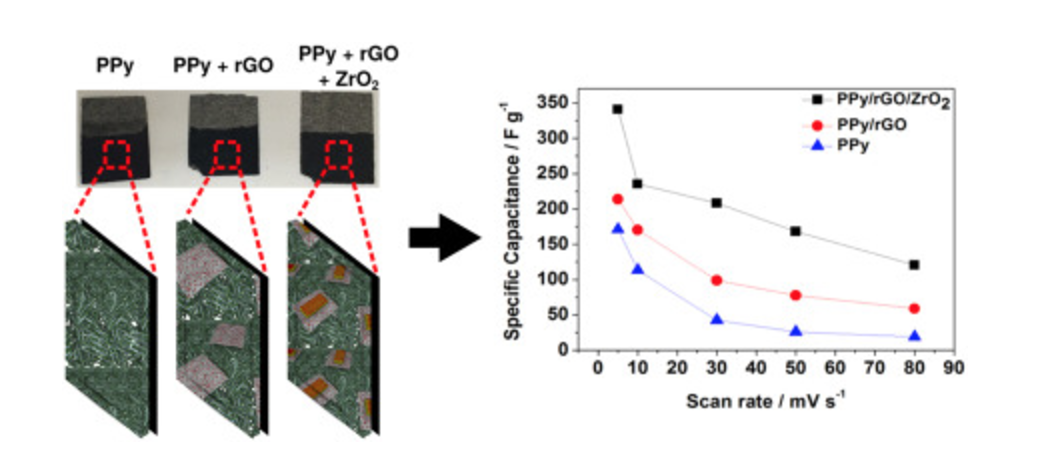
Alves, Ana Paula P; Koizumi, Ryota; Samanta, Atanu; Machado, Leonardo D; Singh, Abhisek K; Galvao, Douglas S; Silva, Glaura G; Tiwary, Chandra S; Ajayan, Pulickel M
One-step electrodeposited 3D-ternary composite of zirconia nanoparticles, rGO and polypyrrole with enhanced supercapacitor performance Journal Article
In: Nano Energy, vol. 31, pp. 225-232, 2017.
Abstract | Links | BibTeX | Tags: Molecular Dynamics, Polymers, supercapacitors, Zirconia
@article{Alves2017,
title = {One-step electrodeposited 3D-ternary composite of zirconia nanoparticles, rGO and polypyrrole with enhanced supercapacitor performance},
author = {Alves, Ana Paula P and Koizumi, Ryota and Samanta, Atanu and Machado, Leonardo D and Singh, Abhisek K and Galvao, Douglas S and Silva, Glaura G and Tiwary, Chandra S and Ajayan, Pulickel M},
url = {http://www.sciencedirect.com/science/article/pii/S221128551630502X},
doi = {10.1016/j.nanoen.2016.11.018},
year = {2017},
date = {2017-01-01},
journal = {Nano Energy},
volume = {31},
pages = {225-232},
abstract = {Supercapacitor electrodes consisting of conjugated polymers (CP), metal oxides and graphene nanosheets have been explored as a strategy to achieve high specific capacitance, power, energy density, and stability. In this work, we synthesized a 3D structure composed of zirconia oxide nanoparticles (ZrO2), reduced graphene oxide (rGO) and polypyrrole (PPy), using a simple and easily scalable one-step chronopotentiometry method. Detailed characterization revealed that the addition of rGO and ZrO2 modified the morphology of the electrode material. The capacitance of the resulting architecture improved by up to a 100%. The ternary composite featured high stability, with an increase of 5% in capacitance after a thousand cycles. DFT and MD simulations were carried out in order to provide further insight on the role of zirconia.
},
keywords = {Molecular Dynamics, Polymers, supercapacitors, Zirconia},
pubstate = {published},
tppubtype = {article}
}
2016
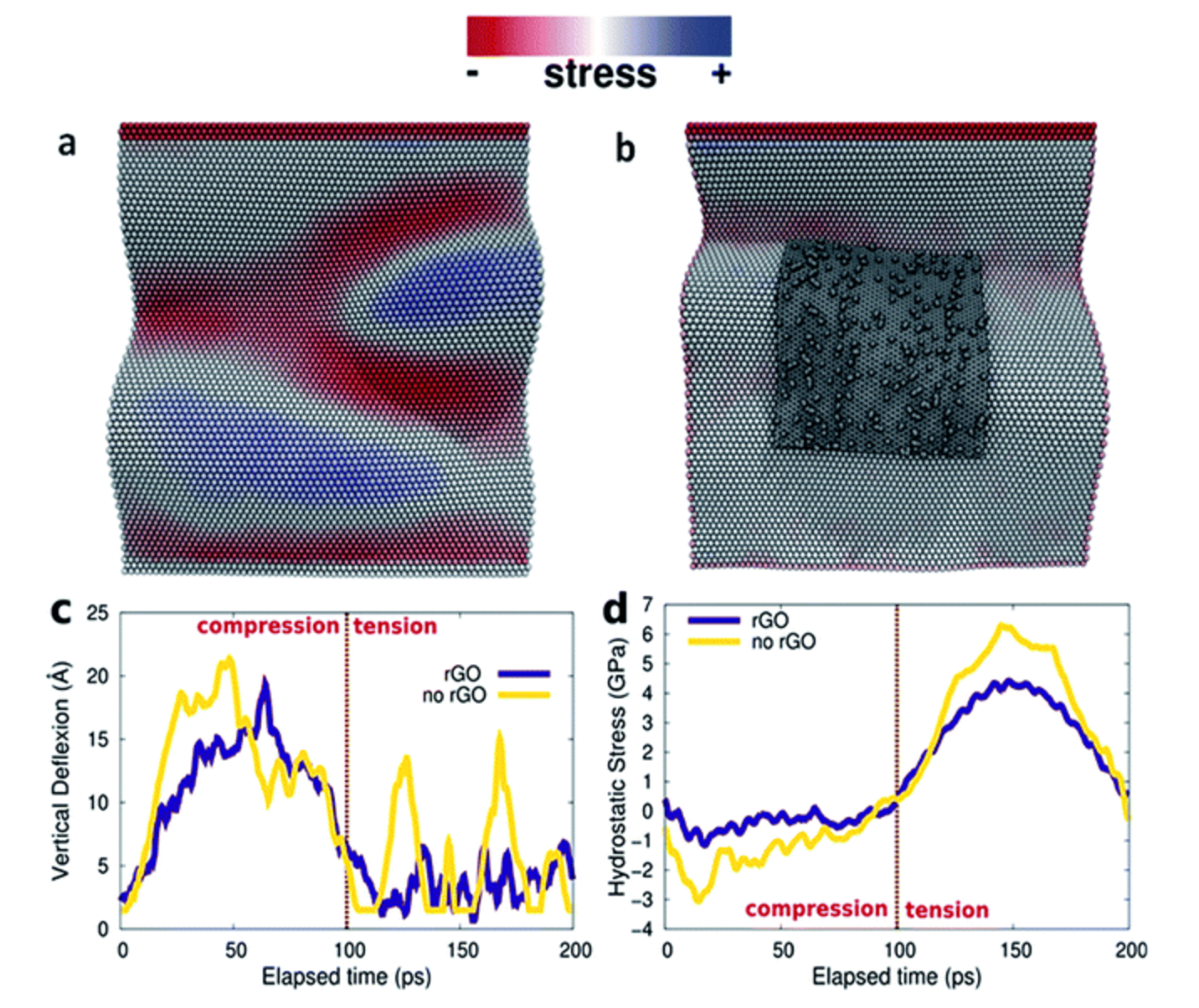
Chandra Sekhar Tiwary Sujin P Jose, Suppanat Kosolwattana
Enhanced supercapacitor performance of a 3D architecture tailored using atomically thin rGO–MoS 2 2D sheets Journal Article
In: RSC Advances, vol. 6, pp. 93384-93393, 2016.
Abstract | Links | BibTeX | Tags: Chalcogenides, DFT, graphene oxide, Molecular Dynamics
@article{Jose2016,
title = {Enhanced supercapacitor performance of a 3D architecture tailored using atomically thin rGO–MoS 2 2D sheets},
author = {Sujin P Jose, Chandra Sekhar Tiwary, Suppanat Kosolwattana, Prasanth Raghavan, Leonardo D Machado, Chandkiram Gautam, T Prasankumar, Jarin Joyner, Sehmus Ozden, Douglas S Galvao, PM Ajayan},
url = {xlink.rsc.org/?DOI=c6ra20960b},
doi = {10.1039/C6RA20960B},
year = {2016},
date = {2016-09-19},
journal = {RSC Advances},
volume = {6},
pages = {93384-93393},
abstract = {A 3D architecture is fabricated using 2D nano-sheets of GO and MoS2 as the building blocks by a facile, one-pot chronoamperometry method to achieve a conductive additive free, binder free and scalable supercapacitor electrode. The superior electrochemical properties of the 3D PPy-rGO–MoS2 (PGMo) are due to its porous structure, thin wall, high surface area and high electrical conductivity that endow rapid transportation of electrolyte ions and electrons throughout the electrode matrix. The synergistic effect between the components in a proper ratio improves the supercapacitor performance and material stability of PGMo. The possible correlation of the structure and electrochemical performance of the 3D ternary composite is backed by a fully atomistic molecular dynamics (MD) simulation study. The high specific capacitance (387 F g−1) and impressive cycling stability (>1000 cycles) estimated for PGMo open up an opportunity to consider the 3D ternary nanostructures as cutting edge materials for energy storage solutions.
},
keywords = {Chalcogenides, DFT, graphene oxide, Molecular Dynamics},
pubstate = {published},
tppubtype = {article}
}
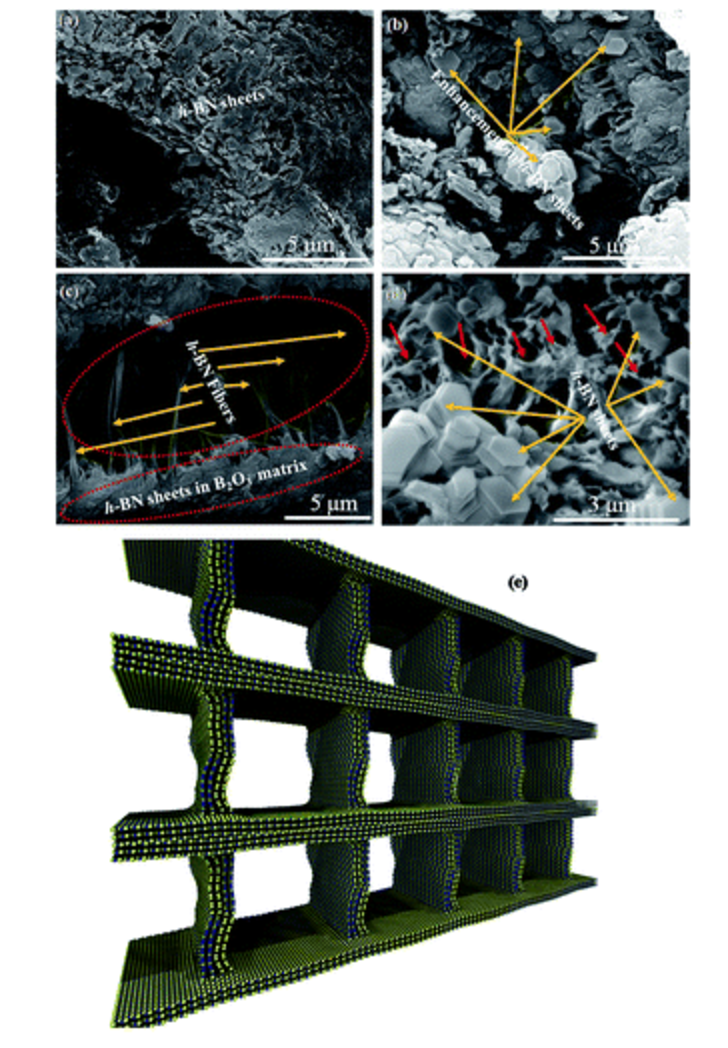
P. M. Gautam, Chandkiram; Tiwary, Chandra Sekhar; Machado, Leonardo D.; Jose, Sujin; Ozden, Sehmus; Biradar, Santoshkumar; Galvao, Douglas S.; Sonker, Rakesh K.; Yadav, B. C.; Vajtai, Robert; Ajayan,
Synthesis and porous h-BN 3D architectures for effective humidity and gas sensors Authors Journal Article
In: RSC Advances, vol. 6, no. 91, pp. 87888-87896, 2016.
Abstract | Links | BibTeX | Tags: Boron Nitride tubes, Modeling, Molecular Dynamics, Sensors
@article{Gautam2016,
title = {Synthesis and porous h-BN 3D architectures for effective humidity and gas sensors Authors},
author = {P. M. Gautam, Chandkiram and Tiwary, Chandra Sekhar and Machado, Leonardo D. and Jose, Sujin and Ozden, Sehmus and Biradar, Santoshkumar and Galvao, Douglas S. and Sonker, Rakesh K. and Yadav, B. C. and Vajtai, Robert and Ajayan},
url = {pubs.rsc.org/en/Content/ArticleHtml/2016/RA/c6ra18833h},
doi = {10.1039/C6RA18833H},
year = {2016},
date = {2016-09-09},
journal = {RSC Advances},
volume = {6},
number = {91},
pages = {87888-87896},
abstract = {3D (three dimensional) architectures synthesised using an easily scalable solid state method which results in an interconnected network of porous h-BN sheets with boron trioxide are reported in this study. The boron trioxide acts as a nucleating agent for the formation of laterally large nanosheets of h-BN with a low density and increases the specific surface area. The stable form shows improved mechanical properties (experimentally and using MD simulation) and serves as a suitable material for humidity and liquefied petroleum gas (LPG) sensor applications. The sensor shows stability for up to several months without losing its sensitivity.},
keywords = {Boron Nitride tubes, Modeling, Molecular Dynamics, Sensors},
pubstate = {published},
tppubtype = {article}
}
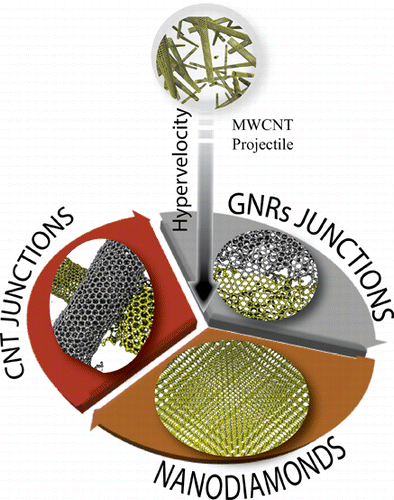
Leonardo D Machado Sehmus Ozden, ChandraSekhar Tiwary
Ballistic Fracturing of Carbon Nanotubes Journal Article
In: ACS Applied Materials & Interfaces, vol. 8, no. 37, pp. 24819-24825, 2016.
Abstract | Links | BibTeX | Tags: Ballistic Impact, Carbon Nanotubes, Molecular Dynamics
@article{Ozden2016b,
title = {Ballistic Fracturing of Carbon Nanotubes},
author = {Sehmus Ozden, Leonardo D Machado, ChandraSekhar Tiwary, Pedro AS Autreto, Robert Vajtai, Enrique V Barrera, Douglas S Galvao, Pulickel M Ajayan},
url = {pubs.acs.org/doi/abs/10.1021/acsami.6b07547},
doi = {10.1021/acsami.6b07547},
year = {2016},
date = {2016-09-08},
journal = {ACS Applied Materials & Interfaces},
volume = {8},
number = {37},
pages = {24819-24825},
abstract = {Advanced materials with multifunctional capabilities and high resistance to hypervelocity impact are of great interest to the designers of aerospace structures. Carbon nanotubes (CNTs) with their lightweight and high strength properties are alternative to metals and/or metallic alloys conventionally used in aerospace applications. Here we report a detailed study on the ballistic fracturing of CNTs for different velocity ranges. Our results show that the highly energetic impacts cause bond breakage and carbon atom rehybridizations, and sometimes extensive structural reconstructions were also observed. Experimental observations show the formation of nanoribbons, nanodiamonds, and covalently interconnected nanostructures, depending on impact conditions. Fully atomistic reactive molecular dynamics simulations were also carried out in order to gain further insights into the mechanism behind the transformation of CNTs. The simulations show that the velocity and relative orientation of the multiple colliding nanotubes are critical to determine the impact outcome.},
keywords = {Ballistic Impact, Carbon Nanotubes, Molecular Dynamics},
pubstate = {published},
tppubtype = {article}
}

Chandra Sekhar Tiwary Mohamad A Kabbani, Anirban Som
A generic approach for mechano-chemical reactions between carbon nanotubes of different functionalities Journal Article
In: Carbon, vol. 104, pp. 196-202, 2016.
Abstract | Links | BibTeX | Tags: Carbon Nanotubes, DFT, Fracture, Mechano-chemistry, Molecular Dynamics
@article{Kabbani2016,
title = {A generic approach for mechano-chemical reactions between carbon nanotubes of different functionalities},
author = {Mohamad A Kabbani, Chandra Sekhar Tiwary, Anirban Som, KR Krishnadas, Pedro AS Autreto, Sehmus Ozden, Kunttal Keyshar, Ken Hackenberg, Alin Christian Chipara, Douglas S Galvao, Robert Vajtai, Ahmad T Kabbani, Thalappil Pradeep, Pulickel M Ajayan},
url = {www.sciencedirect.com/science/article/pii/S000862231630183X},
doi = {10.1016/j.carbon.2016.02.094},
year = {2016},
date = {2016-08-31},
journal = {Carbon},
volume = {104},
pages = {196-202},
abstract = {Abstract Here, we report similar reactions between nanotubes carrying functionalities,
namely carbon nanotubes (CNTs) with the acyl chloride/hydroxyl and amine/carboxylic
functionalities directly attached to their surfaces, resulting in the formation ofchemically
modified graphene products. The reaction is spontaneous and is facilitated by simple
grinding of the reactants. The new solid-state reactions have been confirmed using different
spectroscopic and electron microscopy techniques.},
keywords = {Carbon Nanotubes, DFT, Fracture, Mechano-chemistry, Molecular Dynamics},
pubstate = {published},
tppubtype = {article}
}
namely carbon nanotubes (CNTs) with the acyl chloride/hydroxyl and amine/carboxylic
functionalities directly attached to their surfaces, resulting in the formation ofchemically
modified graphene products. The reaction is spontaneous and is facilitated by simple
grinding of the reactants. The new solid-state reactions have been confirmed using different
spectroscopic and electron microscopy techniques.
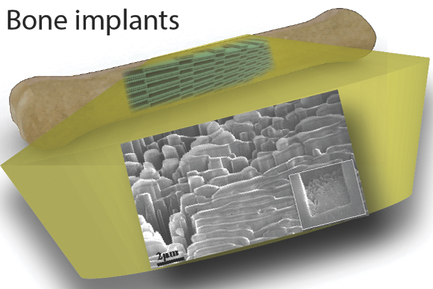
Chandra Sekhar Tiwary Dibyendu Chakravarty, Cristano F Woellner
3D Porous Graphene by Low-Temperature Plasma Welding for Bone Implants Journal Article
In: Advanced Materials, vol. 28, no. 40, pp. 8959-8967, 2016.
Abstract | Links | BibTeX | Tags: Graphene, Molecular Dynamics, Plasma Welding
@article{chakravarty20163d,
title = {3D Porous Graphene by Low-Temperature Plasma Welding for Bone Implants},
author = {Dibyendu Chakravarty, Chandra Sekhar Tiwary, Cristano F Woellner, Sruthi Radhakrishnan, Soumya Vinod, Sehmus Ozden, Pedro Alves da Silva Autreto, Sanjit Bhowmick, Syed Asif, Sendurai A Mani, Douglas S Galvao, Pulickel M},
url = {onlinelibrary.wiley.com/doi/10.1002/adma.201603146/abstract },
doi = {10.1002/adma.201603146},
year = {2016},
date = {2016-08-26},
journal = {Advanced Materials},
volume = {28},
number = {40},
pages = {8959-8967},
abstract = {3D scaffolds of graphene, possessing ultra-low density, macroporous microstructure, and high yield strength and stiffness can be developed by a novel plasma welding process. The bonding between adjacent graphene sheets is investigated by molecular dynamics simulations. The high degree of biocompatibility along with high porosity and good mechanical properties makes graphene an ideal material for use as body implants.},
keywords = {Graphene, Molecular Dynamics, Plasma Welding},
pubstate = {published},
tppubtype = {article}
}
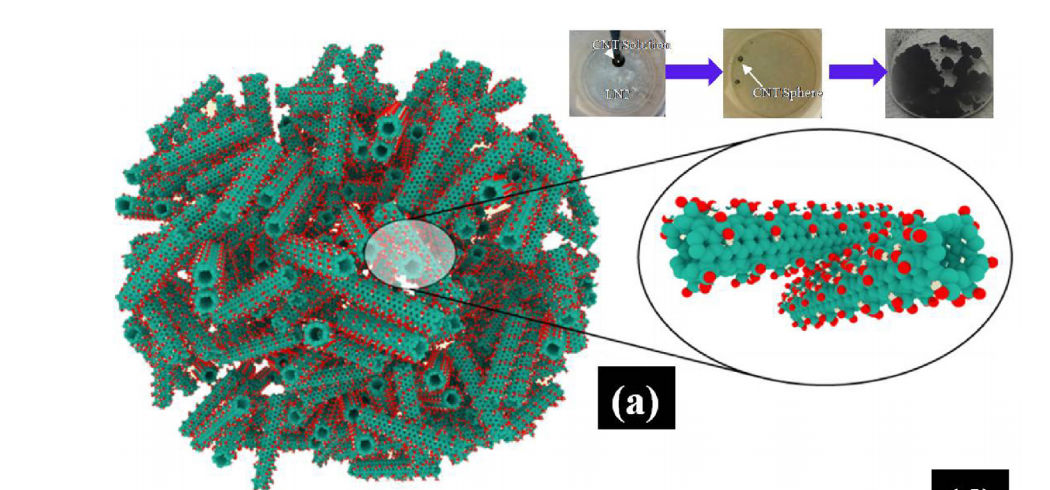
Amelia HC Hart Ryota Koizumi, Gustavo Brunetto
Mechano-chemical stabilization of three-dimensional carbon nanotube aggregates Journal Article
In: Carbon, vol. 110, pp. 27-33, 2016.
Abstract | Links | BibTeX | Tags: Mechano-chemistry, Molecular Dynamics, Nanotubes
@article{koizumi2016mechano,
title = {Mechano-chemical stabilization of three-dimensional carbon nanotube aggregates},
author = {Ryota Koizumi, Amelia HC Hart, Gustavo Brunetto, Sanjit Bhowmick, Peter S Owuor, John T Hamel, Anieph X Gentles, Sehmus Ozden, Jun Lou, Robert Vajtai, SA Syed Asif, Douglas S Galvão, CS Tiwary, PM Ajayan},
url = {www.sciencedirect.com/science/article/pii/S0008622316307400},
doi = {10.1016/j.carbon.2016.08.085},
year = {2016},
date = {2016-08-21},
journal = {Carbon},
volume = {110},
pages = {27-33},
abstract = {Here we report a combined study of experiments and simulations to understand how chemical functional groups can mechanically stabilize aggregates of carbon nanotubes (CNTs). Ultralow density aggregates of chemically functionalized CNTs, in the form of macro-scale spheres made by freeze-drying method, show mechanical stabilization and near complete elastic recovery during deformation. Simulations of interacting functionalized carbon nanotube aggregates show better structural retention compared to non-functionalized CNTs under compression, suggesting that the atomic-level interactions between functional groups on adjoining CNTs help maintain structural rigidity and elastic response during loading. Aggregates of non-functionalized CNTs collapses under similar loading conditions. The dynamic mechanical responses of CNT macrostructures and mechano-chemical stabilization are directly observed using in-situ deformation inside a scanning electron microscope.},
keywords = {Mechano-chemistry, Molecular Dynamics, Nanotubes},
pubstate = {published},
tppubtype = {article}
}
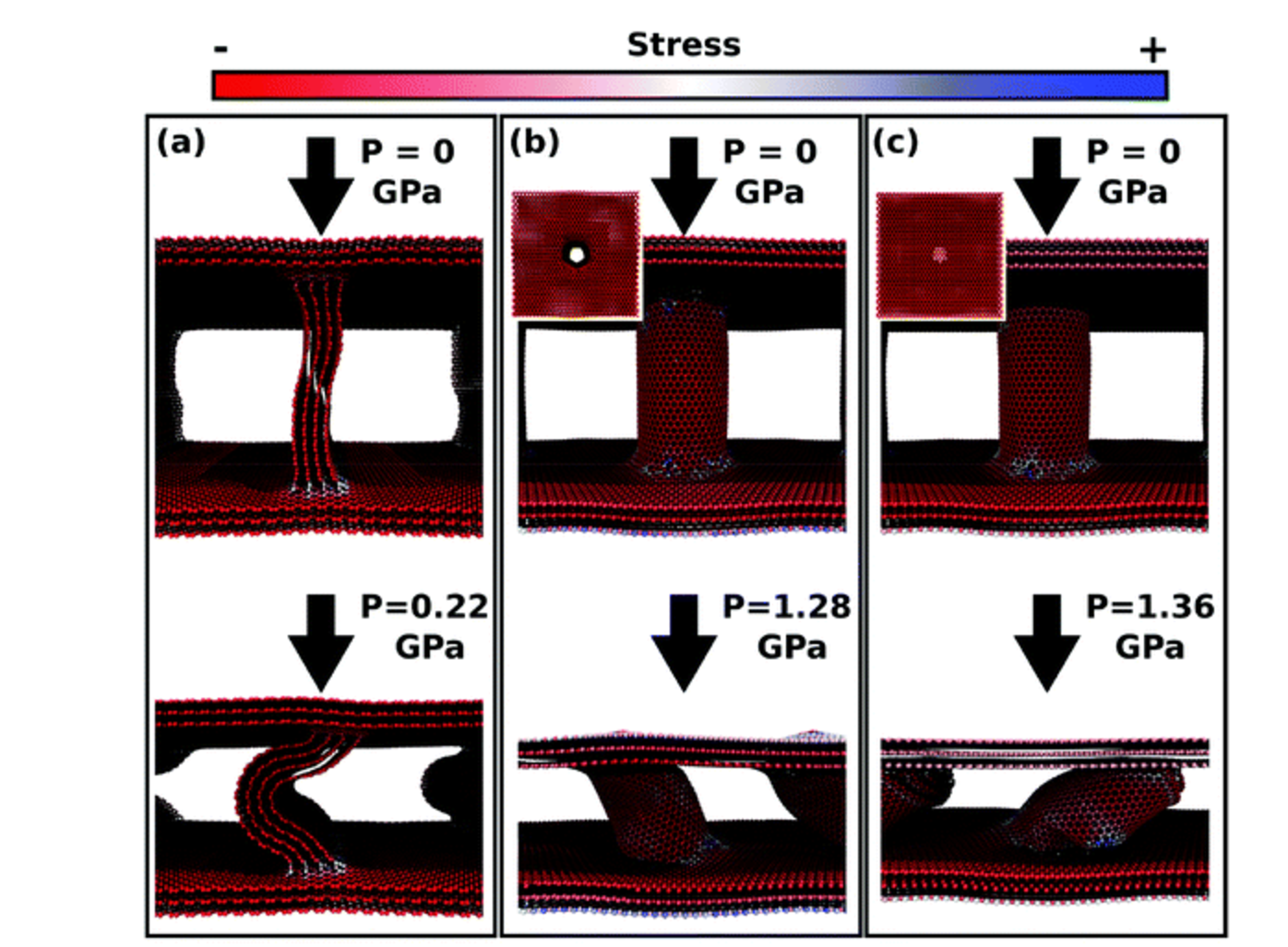
Chandra Sekhar Tiwary Soumya Vinod, Leonardo D Machado
Synthesis of ultralow density 3D graphene–CNT foams using a two-step method Journal Article
In: Nanoscale, vol. 8, no. 35, pp. 15857-15863, 2016.
Abstract | Links | BibTeX | Tags: Carbon Nanotubes, foams, Molecular Dynamics
@article{Vinod2016b,
title = {Synthesis of ultralow density 3D graphene–CNT foams using a two-step method},
author = {Soumya Vinod, Chandra Sekhar Tiwary, Leonardo D Machado, Sehmus Ozden, Robert Vajtai, Douglas S Galvao, Pulickel M Ajayan},
url = {xlink.rsc.org/?DOI=c6nr04252j},
doi = {10.1039/C6NR04252J},
year = {2016},
date = {2016-08-09},
journal = {Nanoscale},
volume = {8},
number = {35},
pages = {15857-15863},
abstract = {Here, we report a highly scalable two-step method to produce graphene foams with ordered carbon nanotube reinforcements. In our approach, we first used solution assembly methods to obtain graphene oxide foam. Next, we employed chemical vapor deposition to simultaneously grow carbon nanotubes and thermally reduce the 3D graphene oxide scaffold. The resulting structure presented increased stiffness, good mechanical stability and oil absorption properties. Molecular dynamics simulations were carried out to further elucidate failure mechanisms and to understand the enhancement of the mechanical properties. The simulations showed that mechanical failure is directly associated with bending of vertical reinforcements, and that, for similar length and contact area, much more stress is required to bend the corresponding reinforcements of carbon nanotubes, thus explaining the experimentally observed enhanced mechanical properties.
},
keywords = {Carbon Nanotubes, foams, Molecular Dynamics},
pubstate = {published},
tppubtype = {article}
}
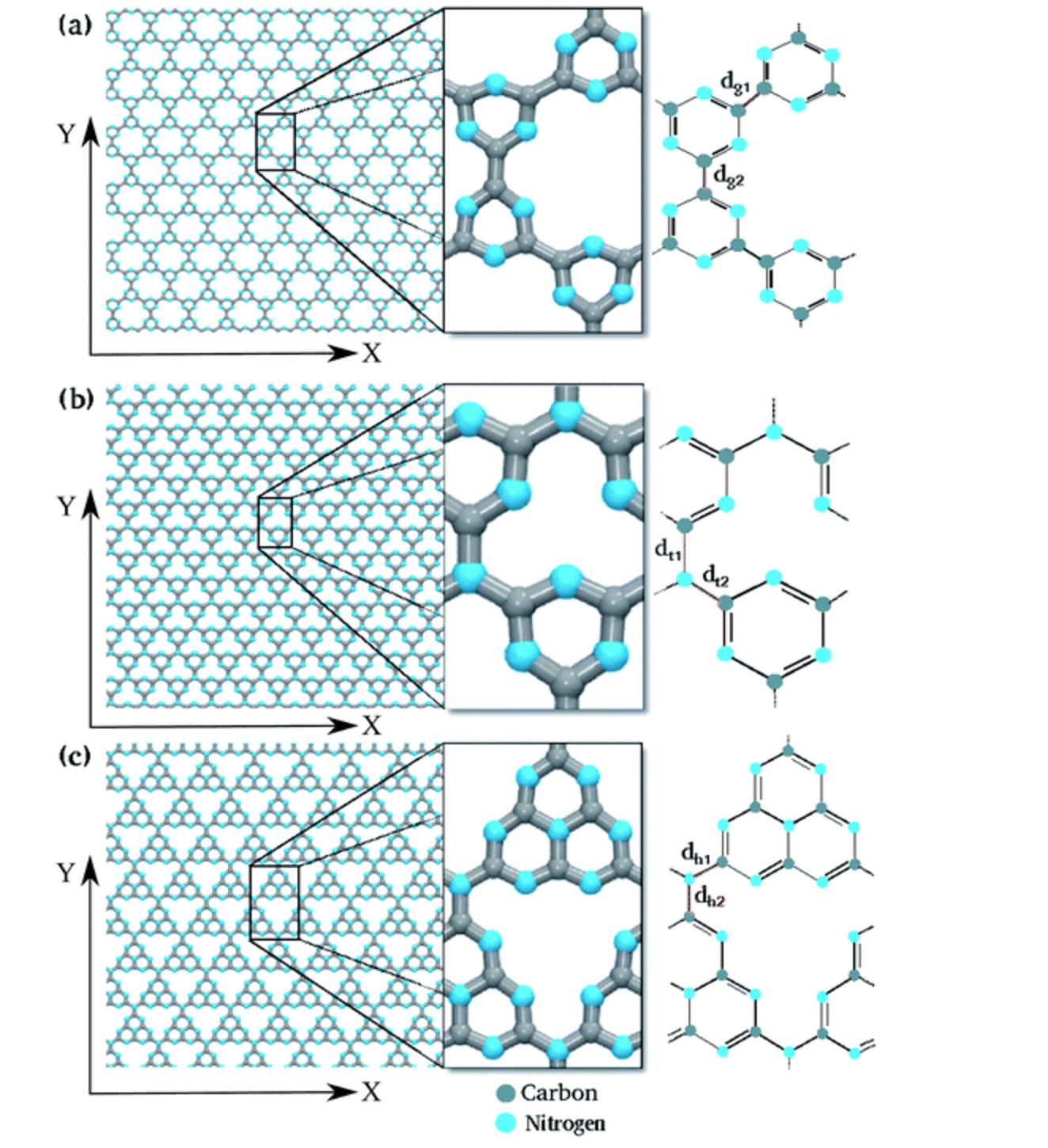
T Botari JM de Sousa, E Perim
Mechanical and structural properties of graphene-like carbon nitride sheets Journal Article
In: RSC Advances, vol. 6, no. 80, pp. 76915-76921, 2016.
Abstract | Links | BibTeX | Tags: carbon nitrides sheets, Mechanical Properties, Molecular Dynamics
@article{deSousa2016b,
title = {Mechanical and structural properties of graphene-like carbon nitride sheets},
author = {JM de Sousa, T Botari, E Perim, RA Bizao, Douglas S Galvao},
url = {pubs.rsc.org/en/content/articlehtml/2016/ra/c6ra14273g},
doi = {10.1039/C6RA14273G},
year = {2016},
date = {2016-08-08},
journal = {RSC Advances},
volume = {6},
number = {80},
pages = {76915-76921},
abstract = {Carbon nitride-based nanostructures have attracted special attention (from theory and experiments) due to their remarkable electromechanical properties. In this work we have investigated the mechanical properties of some graphene-like carbon nitride membranes through fully atomistic reactive molecular dynamics simulations. We have analyzed three different structures of these CN families, the so-called graphene-based g-CN, triazine-based g-C3N4 and heptazine-based g-C3N4. The stretching dynamics of these membranes was studied for deformations along their two main axes and at three different temperatures: 10 K, 300 K and 600 K. We show that g-CN membranes have the lowest ultimate fracture strain value, followed by heptazine-based and triazine-based ones, respectively. This behavior can be explained in terms of their differences in density values, topologies and types of chemical bonds. The dependency of the fracture patterns on the stretching directions is also discussed.},
keywords = {carbon nitrides sheets, Mechanical Properties, Molecular Dynamics},
pubstate = {published},
tppubtype = {article}
}
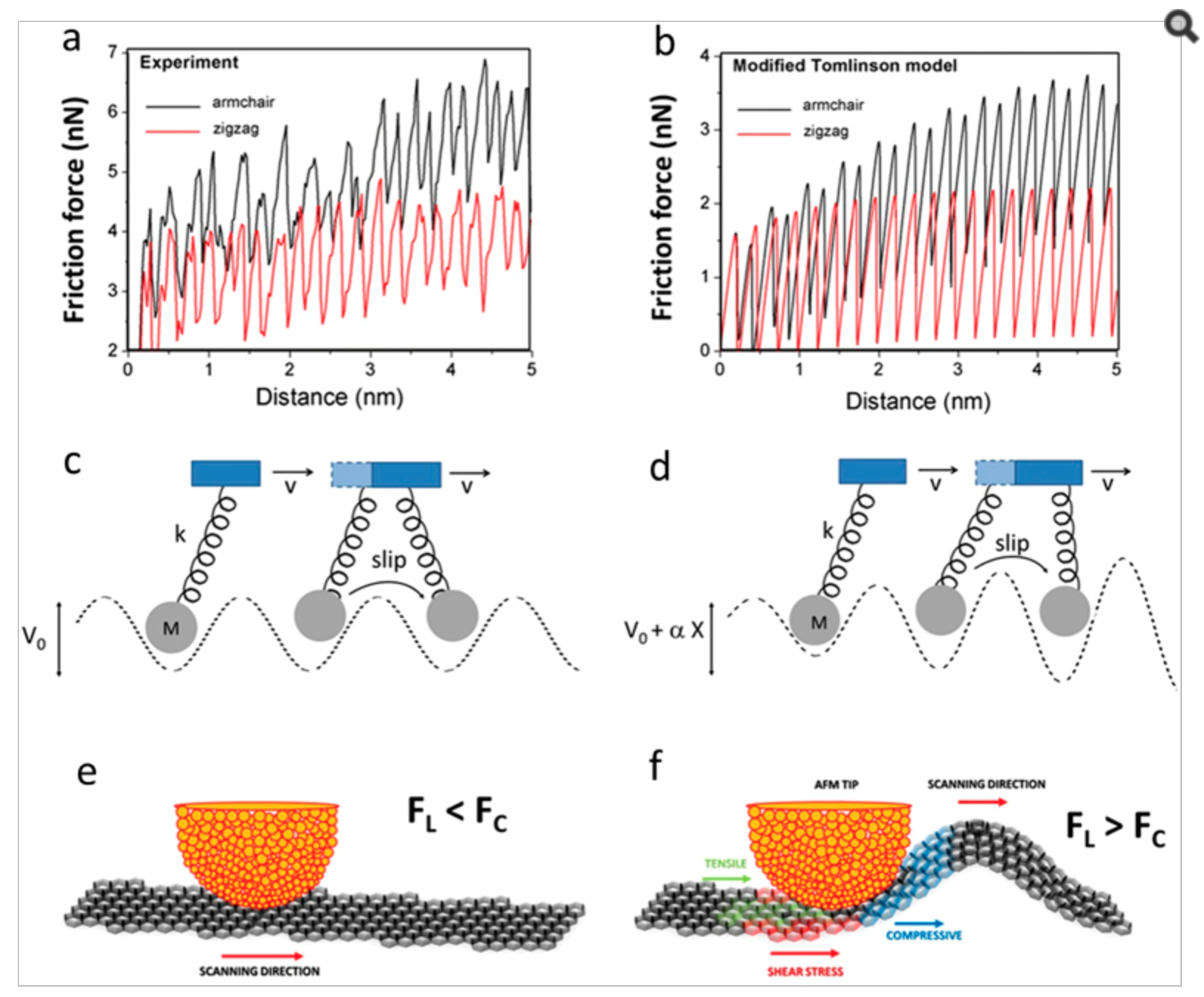
Rodrigo Prioli Clara M Almeida, Benjamin Fragneaud
Giant and Tunable Anisotropy of Nanoscale Friction in Graphene Journal Article
In: Nature Scientific Reports, vol. 6, pp. 31569, 2016.
Abstract | Links | BibTeX | Tags: DFT, Graphene, Molecular Dynamics, Tribology
@article{Almeida2016,
title = {Giant and Tunable Anisotropy of Nanoscale Friction in Graphene},
author = {Clara M Almeida, Rodrigo Prioli, Benjamin Fragneaud, Luiz Gustavo Cançado, Ricardo Paupitz, Douglas S Galvão, Marcelo De Cicco, Marcos G Menezes, Carlos A Achete, Rodrigo B Capaz},
url = {http://www-nature-com.ez88.periodicos.capes.gov.br/articles/srep31569},
doi = {10.1038/srep31569},
year = {2016},
date = {2016-07-18},
journal = {Nature Scientific Reports},
volume = {6},
pages = {31569},
abstract = {The nanoscale friction between an atomic force microscopy tip and graphene is investigated using friction force microscopy (FFM). During the tip movement, friction forces are observed to increase and then saturate in a highly anisotropic manner. As a result, the friction forces in graphene are highly dependent on the scanning direction: under some conditions, the energy dissipated along the armchair direction can be 80% higher than along the zigzag direction. In comparison, for highly-oriented pyrolitic graphite (HOPG), the friction anisotropy between armchair and zigzag directions is only 15%. This giant friction anisotropy in graphene results from anisotropies in the amplitudes of flexural deformations of the graphene sheet driven by the tip movement, not present in HOPG. The effect can be seen as a novel manifestation of the classical phenomenon of Euler buckling at the nanoscale, which provides the non-linear ingredients that amplify friction anisotropy. Simulations based on a novel version of the 2D Tomlinson model (modified to include the effects of flexural deformations), as well as fully atomistic molecular dynamics simulations and first-principles density-functional theory (DFT) calculations, are able to reproduce and explain the experimental observations.
},
keywords = {DFT, Graphene, Molecular Dynamics, Tribology},
pubstate = {published},
tppubtype = {article}
}
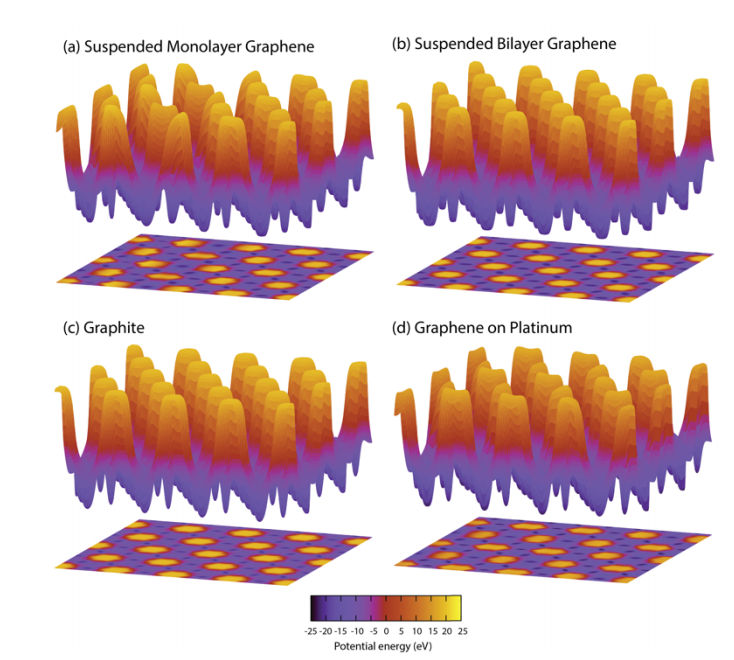
Pedro Alves da Silva Autreto Cristiano Francisco Woellner, Douglas S Galvao
Graphone (one-side hydrogenated graphene) formation on different substrates Online
2016.
Abstract | Links | BibTeX | Tags: Graphene, graphone, Molecular Dynamics
@online{Woellner2016b,
title = {Graphone (one-side hydrogenated graphene) formation on different substrates},
author = {Cristiano Francisco Woellner, Pedro Alves da Silva Autreto, Douglas S Galvao},
url = {arXiv preprint arXiv:1606.09235},
year = {2016},
date = {2016-06-29},
abstract = {In this work we present a fully atomistic reactive (ReaxFF force field) molecular dynamics study of the structural and dynamical aspects of the one-side hydrogenation of graphene membranes, leading to the formation of the so-called graphone structure. We have considered different substrates: graphene, few-layers graphene, graphite and platinum at different temperatures. Our results showed that the hydrogenation rates are very dependent on the substrate and thermal effects. Our results also showed that, similarly to graphane, large hydrogenated domains are unlikely to be formed. These hydrogenation processes occur through the formation of uncorrelated cluster domains.},
keywords = {Graphene, graphone, Molecular Dynamics},
pubstate = {published},
tppubtype = {online}
}
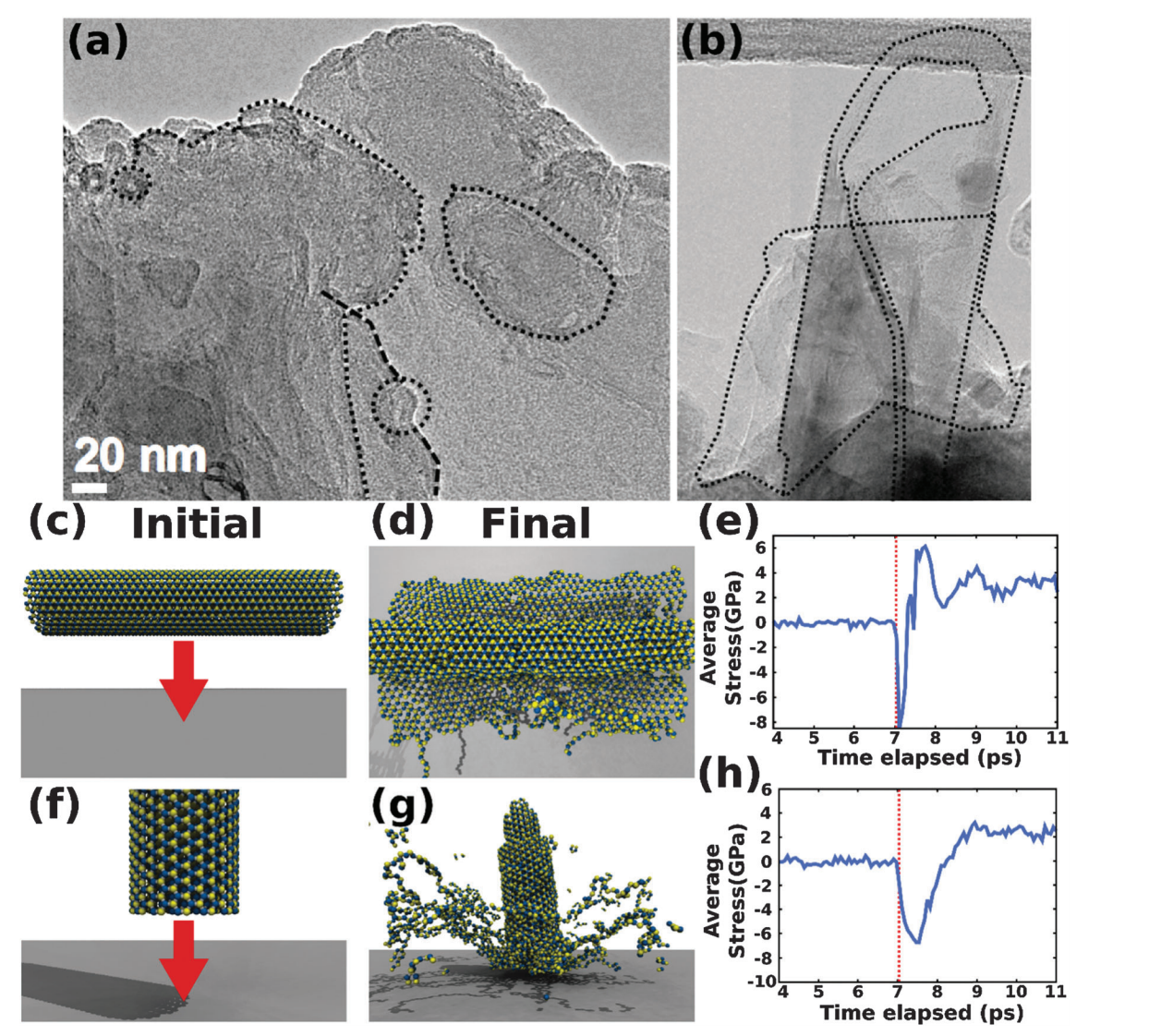
Sehmus Ozden Leonardo D Machado, ChandraSekhar Tiwary
The structural and dynamical aspects of boron nitride nanotubes under high velocity impacts Journal Article
In: Physical Chemistry Chemical Physics, vol. 18, pp. 14776-14781, 2016.
Abstract | Links | BibTeX | Tags: Ballistic Impact, Boron Nitride tubes, CNT, Fracture, Molecular Dynamics
@article{Machado2016,
title = {The structural and dynamical aspects of boron nitride nanotubes under high velocity impacts},
author = {Leonardo D Machado, Sehmus Ozden, ChandraSekhar Tiwary, Pedro AS Autreto, Robert Vajtai, Enrique V Barrera, Douglas S Galvao, Pulickel M Ajayan},
url = {xlink.rsc.org/?DOI=c6cp01949h},
doi = {10.1039/C6CP01949H},
year = {2016},
date = {2016-05-01},
journal = {Physical Chemistry Chemical Physics},
volume = {18},
pages = {14776-14781},
abstract = {This communication report is a study on the structural and dynamical aspects of boron nitride nanotubes (BNNTs) shot at high velocities (∼5 km s−1) against solid targets. The experimental results show unzipping of BNNTs and the formation of hBN nanoribbons. Fully atomistic reactive molecular dynamics simulations were also carried out to gain insights into the BNNT fracture patterns and deformation mechanisms. Our results show that longitudinal and axial tube fractures occur, but the formation of BN nanoribbons from fractured tubes was only observed for some impact angles. Although some structural and dynamical features of the impacts are similar to the ones reported for CNTs, because BNNTs are more brittle than CNTs this results in a larger number of fractured tubes but with fewer formed nanoribbons.},
keywords = {Ballistic Impact, Boron Nitride tubes, CNT, Fracture, Molecular Dynamics},
pubstate = {published},
tppubtype = {article}
}
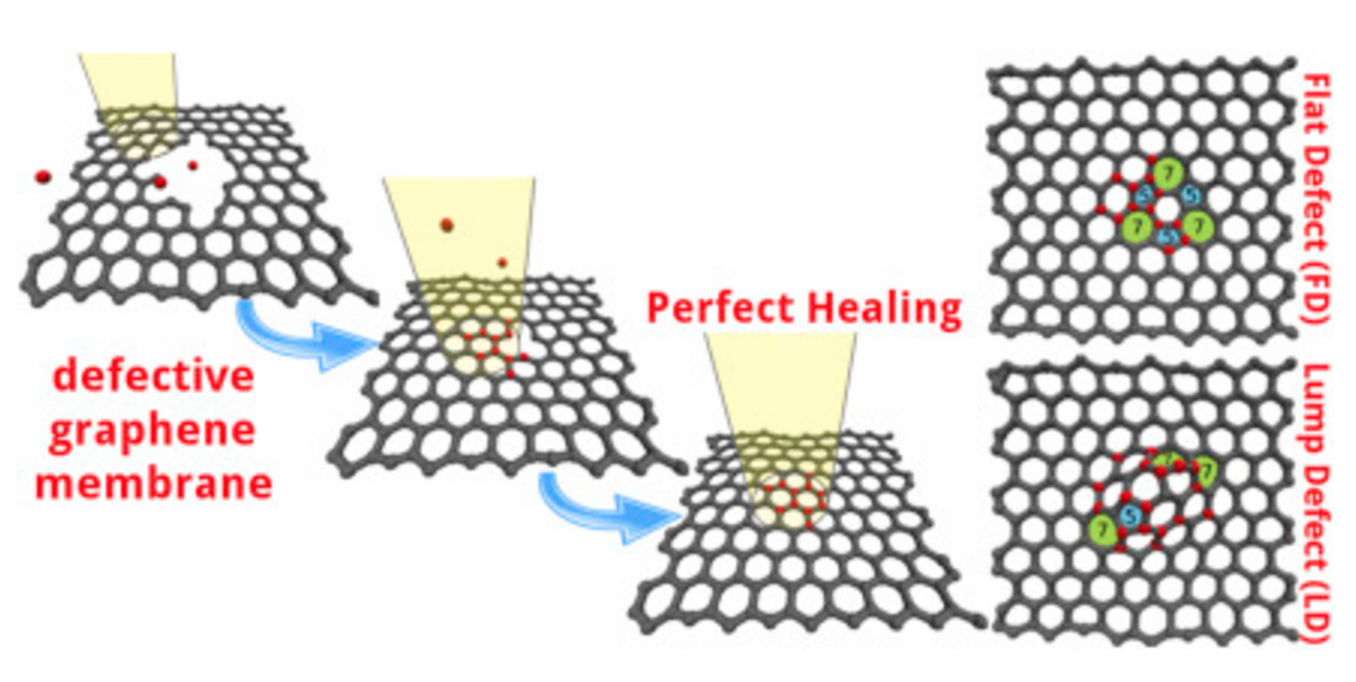
Botari, Tiago; Paupitz, Ricardo; da Silva Autreto, Pedro Alves; Galvao, Douglas S
Graphene healing mechanisms: A theoretical investigation Journal Article
In: Carbon, vol. 99, pp. 302-309, 2016.
Abstract | Links | BibTeX | Tags: Graphene, healing, Molecular Dynamics
@article{2016Healing,
title = {Graphene healing mechanisms: A theoretical investigation},
author = {Botari, Tiago and Paupitz, Ricardo and da Silva Autreto, Pedro Alves and Galvao, Douglas S},
url = {http://www.sciencedirect.com/science/article/pii/S0008622315304784},
doi = {10.1016/j.carbon.2015.11.070},
year = {2016},
date = {2016-04-30},
journal = {Carbon},
volume = {99},
pages = {302-309},
abstract = {Large holes in graphene membranes were recently shown to heal, either at room temperature during a low energy STEM experiment, or by annealing at high temperatures. However, the details of the healing mechanism remain unclear. We carried out fully atomistic reactive molecular dynamics simulations in order to address these mechanisms under different experimental conditions. Our results show that, if a carbon atom source is present, high temperatures can provide enough energy for the carbon atoms to overcome the potential energy barrier and to produce perfect reconstruction of the graphene hexagonal structure. At room temperature, this perfect healing is only possible if the heat effects of the electron beam from STEM experiment are explicitly taken into account. The reconstruction process of a perfect or near perfect graphene structure involves the formation of linear carbon chains, as well as rings containing 5, 6, 7 and 8 atoms with planar (Stone-Wales like) and non-planar (lump like) structures. These results shed light on the healing mechanism of graphene when subjected to different experimental conditions. Additionally, the methodology presented here can be useful for investigating the tailoring and manipulations of other nano-structures.},
keywords = {Graphene, healing, Molecular Dynamics},
pubstate = {published},
tppubtype = {article}
}
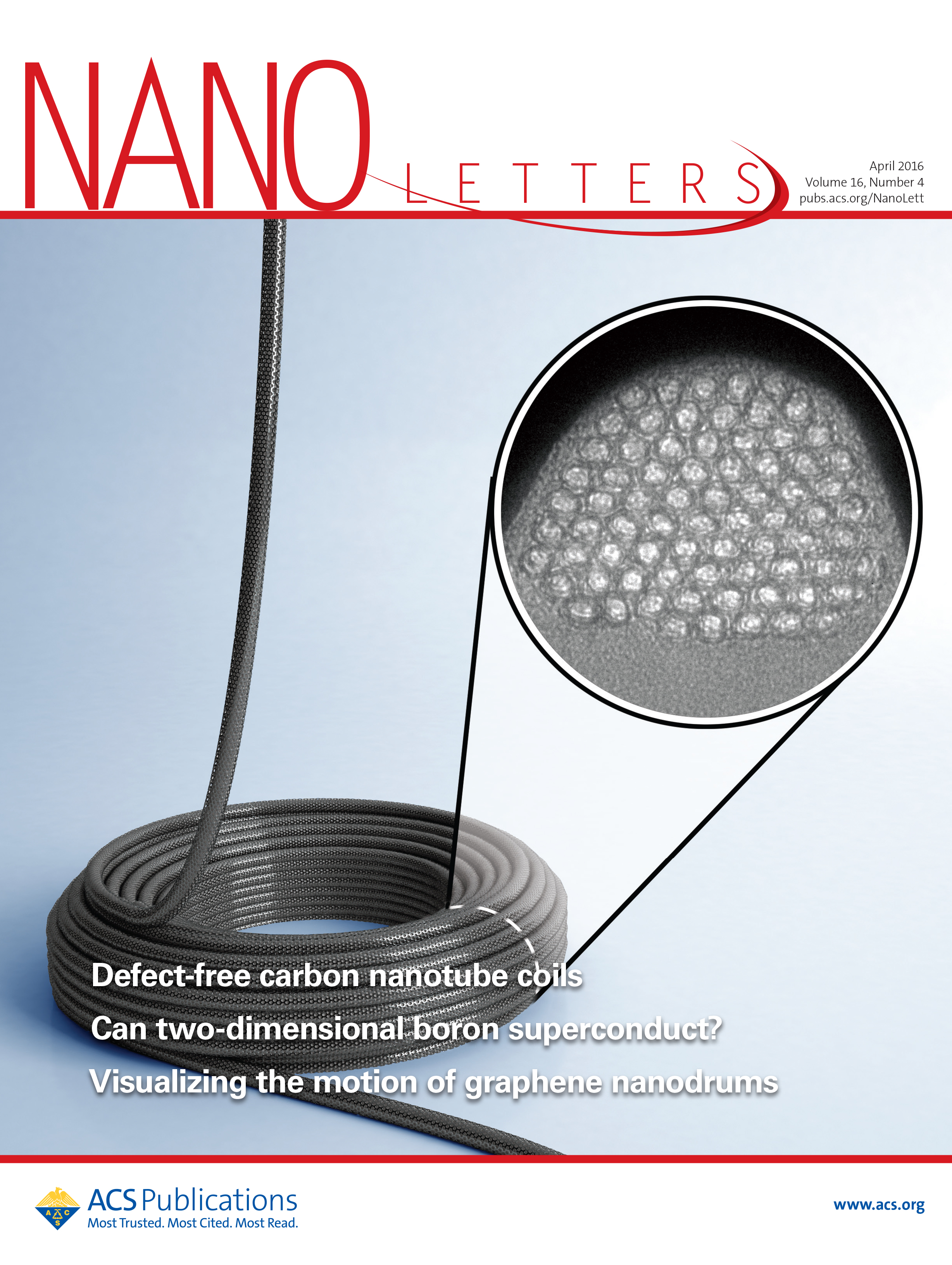
Anna Kremen Nitzan Shadmi, Yiftach Frenkel; Joselevich, Ernesto
Defect-Free Carbon Nanotube Coils Journal Article
In: Nano Letters, vol. 16, no. 4, pp. 2152–2158, 2016.
Abstract | Links | BibTeX | Tags: CNT, Coils, Molecular Dynamics, Synthesis, TEM
@article{Shadmi2016,
title = {Defect-Free Carbon Nanotube Coils},
author = {Nitzan Shadmi, Anna Kremen, Yiftach Frenkel, Zachary J. Lapin, Leonardo D. Machado, Sergio B. Legoas, Ora Bitton, Katya Rechav, Ronit Popovitz-Biro, Douglas S. Galvão, Ado Jorio, Lukas Novotny, Beena Kalisky, and Ernesto Joselevich},
url = {http://pubs.acs.org/doi/abs/10.1021/acs.nanolett.5b03417},
doi = {10.1021/acs.nanolett.5b03417},
year = {2016},
date = {2016-04-01},
journal = {Nano Letters},
volume = {16},
number = {4},
pages = {2152–2158},
abstract = {Carbon nanotubes are promising building blocks for various nanoelectronic components. A highly desirable geometry for such applications is a coil. However, coiled nanotube structures reported so far were inherently defective or had no free ends accessible for contacting. Here we demonstrate the spontaneous self-coiling of single-wall carbon nanotubes into defect-free coils of up to more than 70 turns with identical diameter and chirality, and free ends. We characterize the structure, formation mechanism, and electrical properties of these coils by different microscopies, molecular dynamics simulations, Raman spectroscopy, and electrical and magnetic measurements. The coils are highly conductive, as expected for defect-free carbon nanotubes, but adjacent nanotube segments in the coil are more highly coupled than in regular bundles of single-wall carbon nanotubes, owing to their perfect crystal momentum matching, which enables tunneling between the turns. Although this behavior does not yet enable the performance of these nanotube coils as inductive devices, it does point a clear path for their realization. Hence, this study represents a major step toward the production of many different nanotube coil devices, including inductors, electromagnets, transformers, and dynamos.},
keywords = {CNT, Coils, Molecular Dynamics, Synthesis, TEM},
pubstate = {published},
tppubtype = {article}
}

Gustavo Brunetto Sehmus Ozden, N. S. Karthiselva
Controlled 3D Carbon Nanotube Structures by Plasma Welding Journal Article
In: Advanced Materials Interfaces, vol. 2016, pp. 1500755, 2016.
Abstract | Links | BibTeX | Tags: 3D networks, Carbon Nanotubes, Elasticity, Molecular Dynamics
@article{Ozden2016,
title = {Controlled 3D Carbon Nanotube Structures by Plasma Welding},
author = {Sehmus Ozden, Gustavo Brunetto, N. S. Karthiselva, Douglas S. Galvão, Ajit Roy, Srinivasa R. Bakshi, Chandra S. Tiwary, andPulickel M. Ajayan},
url = {http://onlinelibrary.wiley.com/doi/10.1002/admi.201500755/abstract?campaign=wolearlyview},
doi = {10.1002/admi.201500755},
year = {2016},
date = {2016-03-17},
journal = {Advanced Materials Interfaces},
volume = {2016},
pages = {1500755},
abstract = {3D interconnected carbon nanotubes (CNTs) are synthesized using an industrially scalable spark plasma technique. At high electric field and elevated temperature under sufficient stress the nanotubes are welded together to form a solid block. The detailed spectroscopic and microscopic analyses show successful welding of the CNTs and formation of interconnected networks. The mechanical characteristics of the 3D CNT block show a high stiffness and yield strength. A full atomistic molecular dynamics simulation elucidates the CNT welding mechanism.},
keywords = {3D networks, Carbon Nanotubes, Elasticity, Molecular Dynamics},
pubstate = {published},
tppubtype = {article}
}
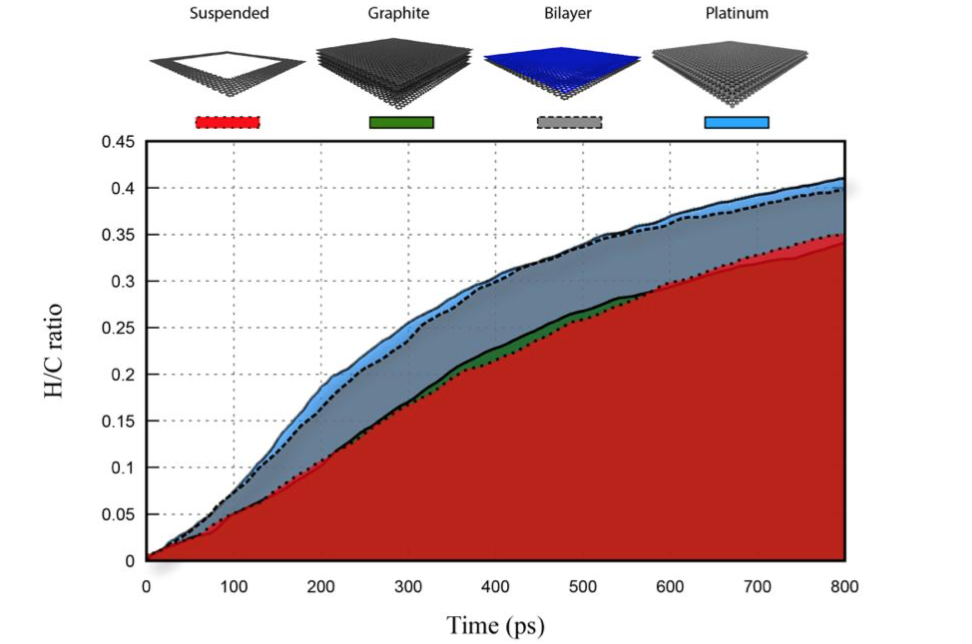
Pedro Alves da Silva Autreto Cristiano Francisco Woellner, Douglas S. Galvao
One Side-Graphene Hydrogenation (Graphone): Substrate Effects Journal Article
In: MRS Advances, vol. 2016, 2016.
Abstract | Links | BibTeX | Tags: Graphane, Graphene, graphone, Molecular Dynamics
@article{Woellner2016b,
title = {One Side-Graphene Hydrogenation (Graphone): Substrate Effects},
author = {Cristiano Francisco Woellner, Pedro Alves da Silva Autreto, Douglas S. Galvao},
url = {http://journals.cambridge.org/action/displayAbstract?fromPage=online&aid=10234793&fulltextType=RA&fileId=S2059852116001961},
doi = {DOI: 10.1557/adv.2016.196},
year = {2016},
date = {2016-03-01},
journal = {MRS Advances},
volume = {2016},
abstract = {Recent studies on graphene hydrogenation processes showed that hydrogenation occurs via island growing domains, however how the substrate can affect the hydrogenation dynamics and/or pattern formation has not been yet properly investigated. In this work we have addressed these issues through fully atomistic reactive molecular dynamics simulations. We investigated the structural and dynamical aspects of the hydrogenation of graphene membranes (one-side hydrogenation, the so called graphone structure) on different substrates (graphene, few-layers graphene, graphite and platinum). Our results also show that the observed hydrogenation rates are very sensitive to the substrate type. For all investigated cases, the largest fraction of hydrogenated carbon atoms was for platinum substrates. Our results also show that a significant number of randomly distributed H clusters are formed during the early stages of the hydrogenation process, regardless of the type of substrate. These results suggest that, similarly to graphane formation, large perfect graphone-like domains are unlikely to be formed. These findings are especially important since experiments have showed that cluster formation influences the electronic transport properties in hydrogenated graphene.
},
keywords = {Graphane, Graphene, graphone, Molecular Dynamics},
pubstate = {published},
tppubtype = {article}
}
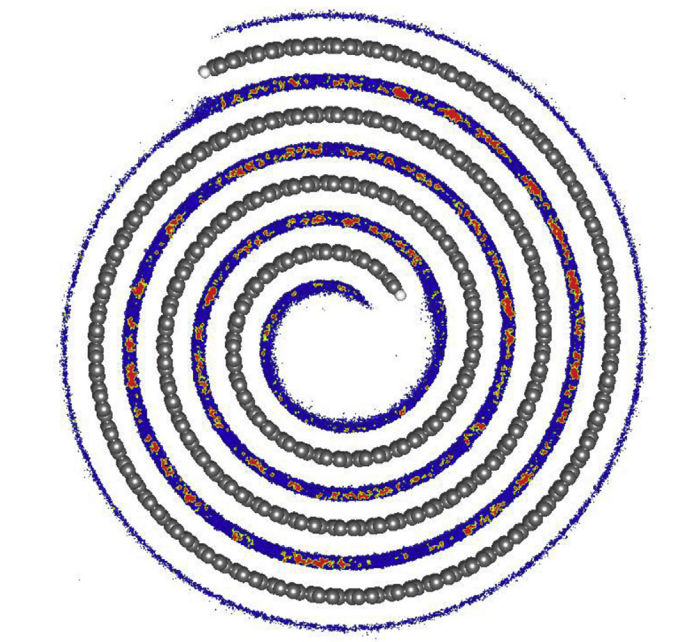
Daff, Thomas D; Collins, Sean P; Durekova, Hana; Perim, E; Skaf, Munir S; Galvão, Douglas S; Woo, Tom K
Evaluation of carbon nanoscroll materials for post-combustion CO2 capture Journal Article
In: Carbon, vol. 101, pp. 218–225, 2016.
Abstract | Links | BibTeX | Tags: CO2 capture, Molecular Dynamics, Scrolls
@article{Daff2016,
title = {Evaluation of carbon nanoscroll materials for post-combustion CO2 capture},
author = {Daff, Thomas D and Collins, Sean P and Durekova, Hana and Perim, E and Skaf, Munir S and Galvão, Douglas S and Woo, Tom K},
url = {http://www.sciencedirect.com/science/article/pii/S0008622316300604},
doi = {10.1016/j.carbon.2016.01.072},
year = {2016},
date = {2016-02-11},
journal = {Carbon},
volume = {101},
pages = {218–225},
abstract = {Carbon nanoscrolls are similar to multi-walled carbon nanotubes but constructed from rolled graphene sheets into papyrus-like structures. In this work, molecular simulations are used to evaluate the post-combustion CO2 capture properties of nanoscrolls made of graphene, α-, β-, and γ-graphyne, boron nitride, and three types of carbon nitride. The CO2 uptake capacity, CO2/N2 selectivity and CO2 working capacity were computed with grand canonical Monte Carlo simulations at conditions relevant to post-combustion CO2 capture. The interlayer spacing of the nanoscrolls was optimized for each property and sheet material. For graphene nanoscrolls, the optimal interlayer spacing of 7.3 Å was identified for both the CO2 uptake and selectivity, while for working capacity the optimal interlayer spacing was determined to be 8.6 Å. It was found that the CO2 uptake capacity of the materials correlated to the density of the sheets from which they were formed. Nanoscrolls made from graphene and boron nitride, which have the highest number of atoms per unit area, also showed the highest CO2 uptakes. At 0.15 bar CO2, 313 K, graphene and boron nitride nanoscrolls exhibited exceptional CO2 uptake capacities of 7.7 and 8.2 mmol/g, respectively, while also exhibiting high CO2/N2 selectivities of 135 and 153, respectively. Molecular dynamics simulations were used to examine the adsorption kinetics. The simulations showed that an empty graphene nanoscroll with a roll length of 200 Å could adsorb CO2 into the center of the roll within 10 ns. Materials with pores that can allow CO2 to pass through, such as graphynes, showed much faster adsorption times.},
keywords = {CO2 capture, Molecular Dynamics, Scrolls},
pubstate = {published},
tppubtype = {article}
}
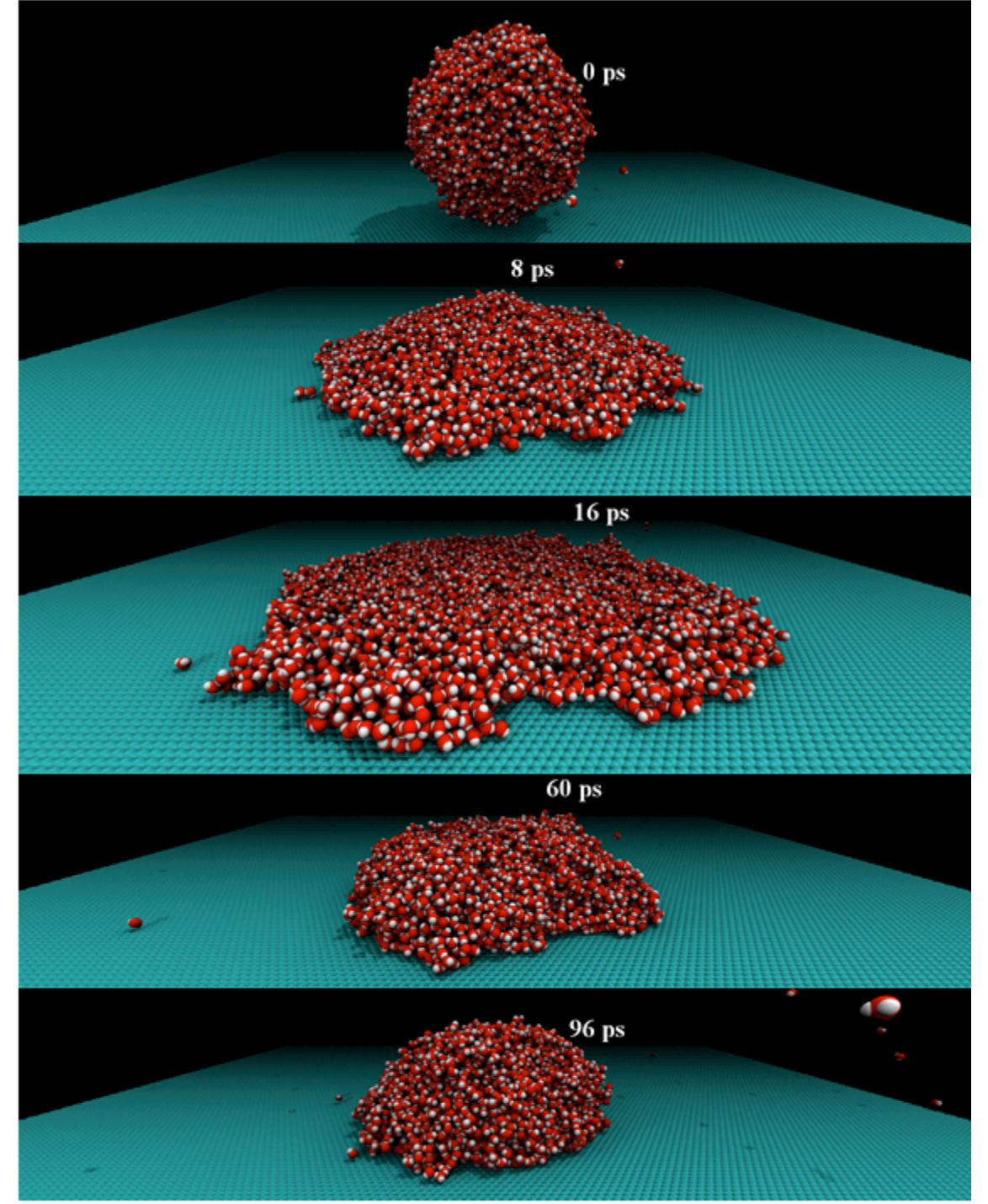
Jaques, Ygor M.; Brunetto, Gustavo; Galvao, Douglas S.
Nanodroplets Impacting on Graphene Online
2016, ((ArXiv preprint)).
Abstract | Links | BibTeX | Tags: Droplet, Graphene, Molecular Dynamics
@online{Jaques2016,
title = {Nanodroplets Impacting on Graphene},
author = {Jaques, Ygor M. and Brunetto, Gustavo and Galvao, Douglas S.},
url = {http://arxiv.org/abs/1602.02013},
year = {2016},
date = {2016-02-05},
abstract = {The unique and remarkable properties of graphene can be exploited as the basis to a wide
range of applications. However, in spite of years of investigations there are some important
graphene properties that are not still fully understood, as for example, its wettability. There are
controversial reported results whether graphene is really hydrophobic or hydrophilic. In order to
address this problem we have carried out classical molecular dynamics simulations of water
nanodroplets shot against graphene surface. Our results show that the contact angle values
between the nanodroplets and graphene surfaces depend on the initial droplet velocity value and
these angles can change from 86º (hydrophobic) to 35º (hydrophilic). Our preliminary results
indicate that the graphene wettability can be dependent on spreading liquid dynamics and which
can explain some of the apparent inconsistencies reported in the literature.},
note = {(ArXiv preprint)},
keywords = {Droplet, Graphene, Molecular Dynamics},
pubstate = {published},
tppubtype = {online}
}
range of applications. However, in spite of years of investigations there are some important
graphene properties that are not still fully understood, as for example, its wettability. There are
controversial reported results whether graphene is really hydrophobic or hydrophilic. In order to
address this problem we have carried out classical molecular dynamics simulations of water
nanodroplets shot against graphene surface. Our results show that the contact angle values
between the nanodroplets and graphene surfaces depend on the initial droplet velocity value and
these angles can change from 86º (hydrophobic) to 35º (hydrophilic). Our preliminary results
indicate that the graphene wettability can be dependent on spreading liquid dynamics and which
can explain some of the apparent inconsistencies reported in the literature.
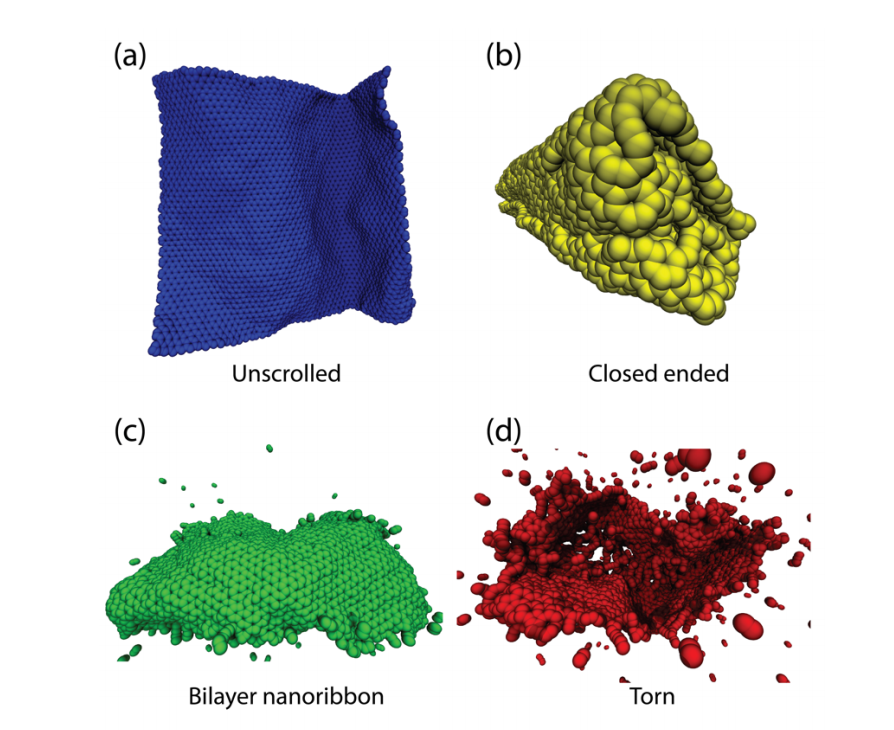
de Sousa, Jose Moreira; Machado, Leonardo Dantas; Woellner, Cristiano Francisco; Autreto, Pedro Alves da Silva; Galvao, Douglas S
Carbon Nanoscrolls at High Impacts: A Molecular Dynamics Investigation Online
2016, ((ArXiv Preprint)).
Abstract | Links | BibTeX | Tags: Ballistic Impact, Molecular Dynamics, Scrolls
@online{deSousa2016b,
title = {Carbon Nanoscrolls at High Impacts: A Molecular Dynamics Investigation},
author = {de Sousa, Jose Moreira and Machado, Leonardo Dantas and Woellner, Cristiano Francisco and Autreto, Pedro Alves da Silva and Galvao, Douglas S},
url = {http://arxiv.org/abs/1601.04875},
year = {2016},
date = {2016-01-19},
abstract = {The behavior of nanostructures under high strain-rate conditions has been object of interest in recent years. For instance, recent experimental investigations showed that at high velocity impacts carbon nanotubes can unzip resulting into graphene nanoribbons. Carbon nanoscrolls (CNS) are among the structures whose high impact behavior has not yet been investigated. CNS are graphene membranes rolled up into papyrus-like structures. Their unique open-ended topology leads to properties not found in close-ended structures, such as nanotubes. Here we report a fully atomistic reactive molecular dynamics study on the behavior of CNS colliding at high velocities against solid targets. Our results show that the velocity and scroll axis orientation are key parameters to determine the resulting formed nanostructures after impact. The relative orientation of the scroll open ends and the substrate is also very important. We observed that for appropriate velocities and orientations, the nanoscrolls can experience large structural deformations and large-scale fractures. We have also observed unscrolling (scrolls going back to planar or quasi-planar graphene membranes), unzip resulting into nanoribbons, and significant reconstructions from breaking and/or formation of new chemical bonds. Another interesting result was that if the CNS impact the substrate with their open ends, for certain velocities, fused scroll walls were observed.},
note = {(ArXiv Preprint)},
keywords = {Ballistic Impact, Molecular Dynamics, Scrolls},
pubstate = {published},
tppubtype = {online}
}
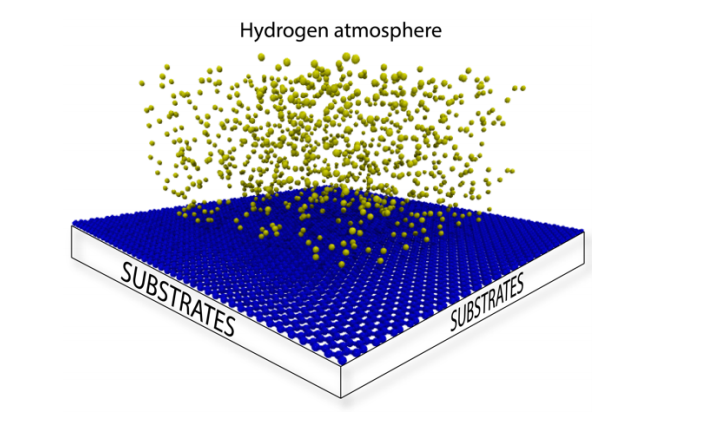
Woellner, Cristiano Francisco; Autreto, Pedro Alves da Silva; Galvao, Douglas S
One Side-Graphene Hydrogenation (Graphone): Substrate Effects Online
2016, visited: 18.01.2016, ((ArXiv preprint)).
Abstract | Links | BibTeX | Tags: Graphane, Graphene, graphone, Molecular Dynamics
@online{Woellner2016,
title = {One Side-Graphene Hydrogenation (Graphone): Substrate Effects},
author = {Woellner, Cristiano Francisco and Autreto, Pedro Alves da Silva and Galvao, Douglas S},
url = {http://arxiv.org/abs/1601.04484},
year = {2016},
date = {2016-01-18},
urldate = {2016-01-18},
abstract = {Recent studies on graphene hydrogenation processes showed that hydrogenation occurs
via island growing domains, however how the substrate can affect the hydrogenation dynamics
and/or pattern formation has not been yet properly investigated. In this work we have addressed
these issues through fully atomistic reactive molecular dynamics simulations. We investigated
the structural and dynamical aspects of the hydrogenation of graphene membranes (one-side
hydrogenation, the so called graphone structure) on different substrates (graphene, few-layers
graphene, graphite and platinum). Our results also show that the observed hydrogenation rates
are very sensitive to the substrate type. For all investigated cases, the largest fraction of
hydrogenated carbon atoms was for platinum substrates. Our results also show that a significant
number of randomly distributed H clusters are formed during the early stages of the
hydrogenation process, regardless of the type of substrate and temperature. These results suggest
that, similarly to graphane formation, large perfect graphone-like domains are unlikely to be
formed. These findings are especially important since experiments have showed that cluster
formation influences the electronic transport properties in hydrogenated graphene.},
note = {(ArXiv preprint)},
keywords = {Graphane, Graphene, graphone, Molecular Dynamics},
pubstate = {published},
tppubtype = {online}
}
via island growing domains, however how the substrate can affect the hydrogenation dynamics
and/or pattern formation has not been yet properly investigated. In this work we have addressed
these issues through fully atomistic reactive molecular dynamics simulations. We investigated
the structural and dynamical aspects of the hydrogenation of graphene membranes (one-side
hydrogenation, the so called graphone structure) on different substrates (graphene, few-layers
graphene, graphite and platinum). Our results also show that the observed hydrogenation rates
are very sensitive to the substrate type. For all investigated cases, the largest fraction of
hydrogenated carbon atoms was for platinum substrates. Our results also show that a significant
number of randomly distributed H clusters are formed during the early stages of the
hydrogenation process, regardless of the type of substrate and temperature. These results suggest
that, similarly to graphane formation, large perfect graphone-like domains are unlikely to be
formed. These findings are especially important since experiments have showed that cluster
formation influences the electronic transport properties in hydrogenated graphene.
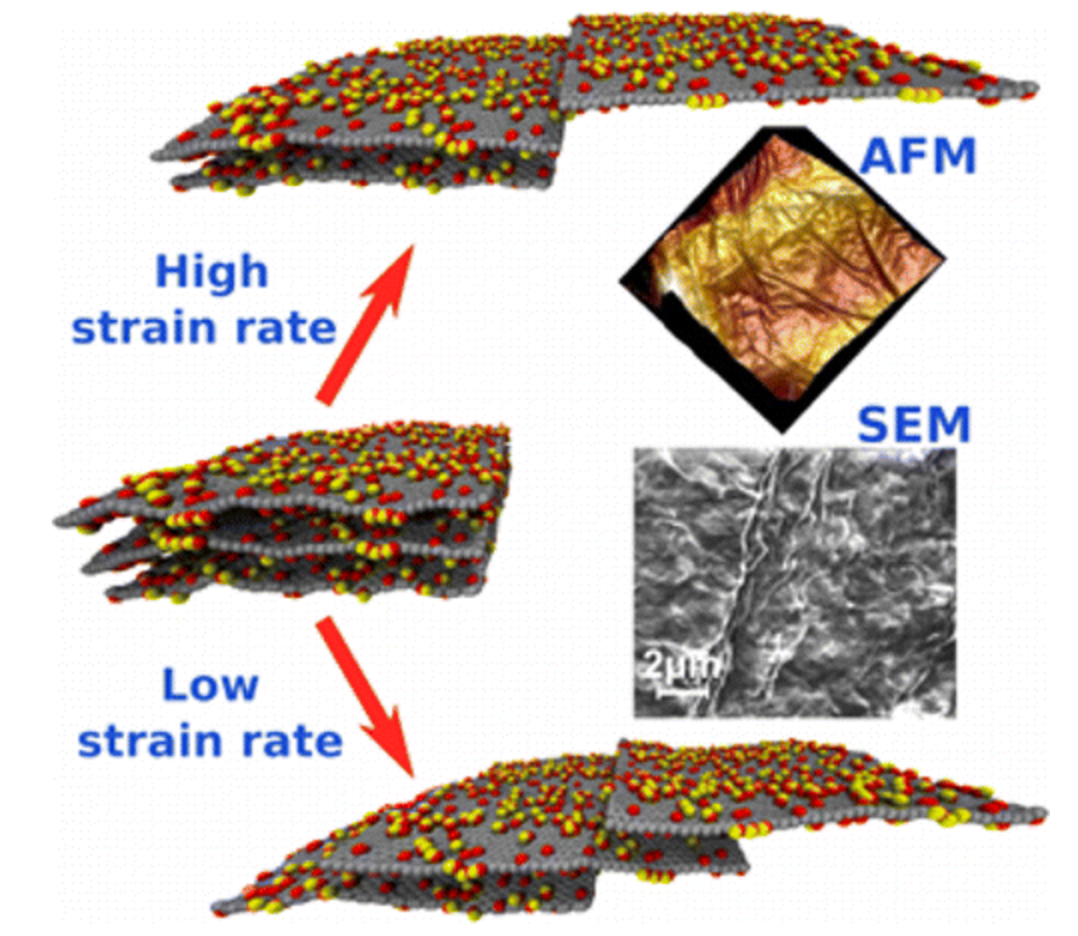
Vinod, Soumya; Tiwary, Chandra Sekhar; Machado, Leonardo Dantas; Ozden, Sehmus; Shaw, Preston; Cho, Juny; Vajtai, Robert; Galvao, Douglas Soares; Ajayan, Pulickel M
Strain Rate Dependent Shear Plasticity in Graphite Oxide Journal Article
In: Nano Letters, vol. 16, no. 2, pp. 1127–1131, 2016.
Abstract | Links | BibTeX | Tags: graphene oxide, Molecular Dynamics, plasticity
@article{Vinod2016,
title = {Strain Rate Dependent Shear Plasticity in Graphite Oxide},
author = {Vinod, Soumya and Tiwary, Chandra Sekhar and Machado, Leonardo Dantas and Ozden, Sehmus and Shaw, Preston and Cho, Juny and Vajtai, Robert and Galvao, Douglas Soares and Ajayan, Pulickel M},
url = {http://pubs.acs.org/doi/abs/10.1021/acs.nanolett.5b04346},
doi = {10.1021/acs.nanolett.5b04346},
year = {2016},
date = {2016-01-16},
journal = {Nano Letters},
volume = {16},
number = {2},
pages = {1127–1131},
abstract = {Graphene oxide film is made of stacked graphene layers with chemical functionalities, and we report that plasticity in the film can be engineered by strain rate tuning. The deformation behavior and plasticity of such functionalized layered systems is dominated by shear slip between individual layers and interaction between functional groups. Stress–strain behavior and theoretical models suggest that the deformation is strongly strain rate dependent and undergoes brittle to ductile transition with decreasing strain rate.},
keywords = {graphene oxide, Molecular Dynamics, plasticity},
pubstate = {published},
tppubtype = {article}
}
2015
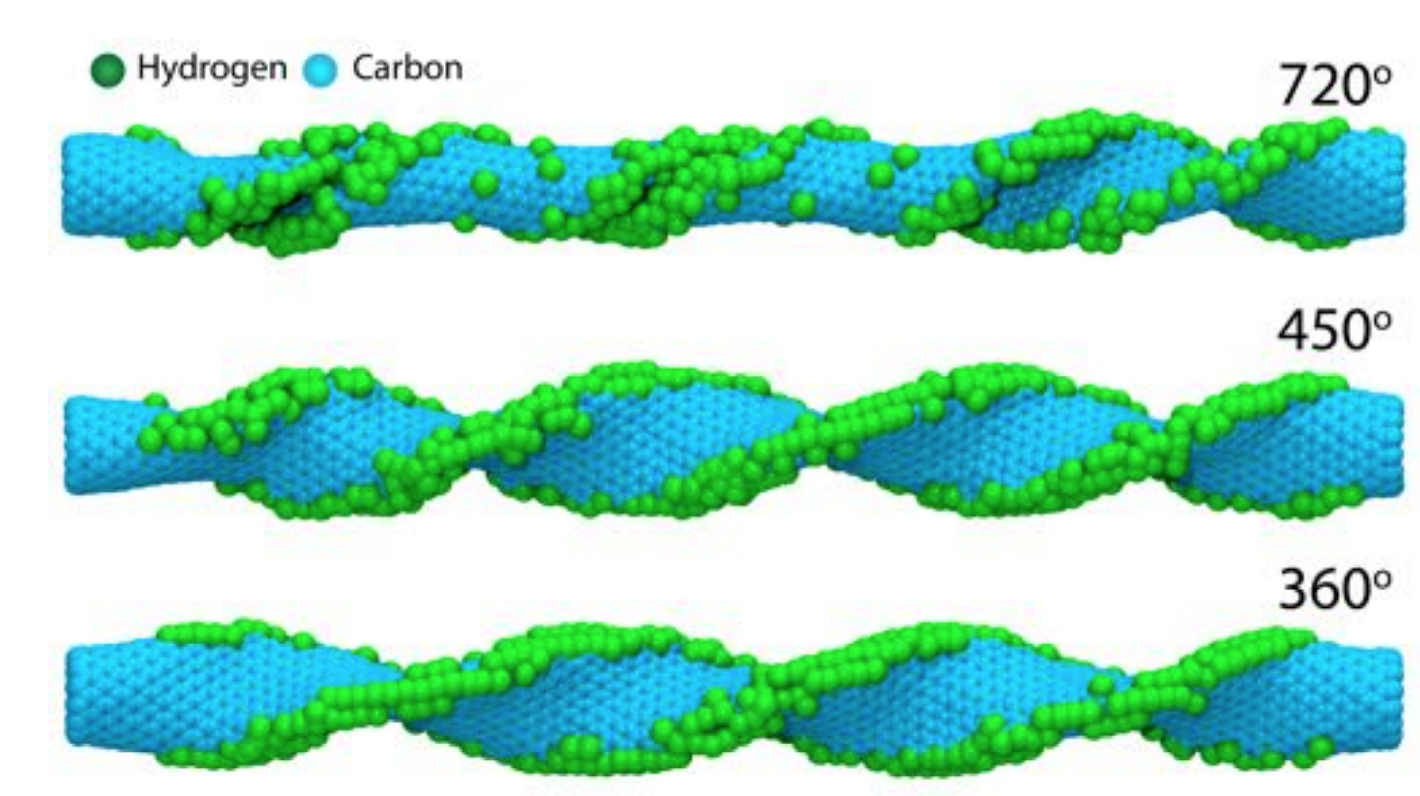
de Sousa, Jose M.; Autreto, Pedro A. S.; Galvao, Douglas S.
Hydrogenation Dynamics of Twisted Carbon Nanotubes Online
2015, (ArXiv preprint).
Abstract | Links | BibTeX | Tags: Carbon Nanotubes, Hydrogenation, Mechanical Properties, Molecular Dynamics
@online{deSousa2015,
title = {Hydrogenation Dynamics of Twisted Carbon Nanotubes},
author = {Jose M. de Sousa and Pedro A. S. Autreto and Douglas S. Galvao},
url = {http://arxiv.org/abs/1510.00265},
year = {2015},
date = {2015-10-01},
abstract = {Carbon Nanotubes (CNTs) are one of the most important materials in nanotechnology. In some of their technological applications (electromechanical oscillators and mechanical actuators for artificial muscles, for instance), it is necessary to subject them to large deformations. Although this frequently happens in air, there are only few studies about the interaction of deformed CNTs with the atmosphere and the dynamics of these processes has not yet been addressed. In this work, we have investigated, through fully atomistic reactive molecular dynamics simulations, the process of hydrogenation of highly twisted CNTs. Our results show that hydrogenation effective ratio is directly related to the tube twist angle values and can lead to twisted tube fractures with well defined patterns (unzip-like). Our results also show that these fracture processes can be exploited to controllably produce graphene nanoribbons.},
note = {ArXiv preprint},
keywords = {Carbon Nanotubes, Hydrogenation, Mechanical Properties, Molecular Dynamics},
pubstate = {published},
tppubtype = {online}
}

Chandra Sekhar Tiwary Dibyendu Chakravarty, Leonardo Dantas Machado
Zirconia-Nanoparticle-Reinforced Morphology-Engineered Graphene-Based Foams Journal Article
In: Advanced Materials, vol. 27, no. 31, pp. 4534–4543, 2015.
Abstract | Links | BibTeX | Tags: Electronic Structure, Mechanical Properties, Mole, Molecular Dynamics, Nanoparticles, Zirconia
@article{Chakravarty2015,
title = {Zirconia-Nanoparticle-Reinforced Morphology-Engineered Graphene-Based Foams},
author = { Dibyendu Chakravarty , Chandra Sekhar Tiwary , Leonardo Dantas Machado ,
Gustavo Brunetto , Soumya Vinod , Ram Manohar Yadav , Douglas S. Galvao ,
Shrikant V. Joshi , Govindan Sundararajan, Pulickel M. Ajayan },
url = {http://onlinelibrary.wiley.com/doi/10.1002/adma.201502409/full},
doi = {10.1002/adma.201502409},
year = {2015},
date = {2015-07-15},
journal = {Advanced Materials},
volume = {27},
number = {31},
pages = {4534–4543},
abstract = {The morphology of graphene-based foams can be engineered by reinforcing them with nanocrystalline zirconia, thus improving their oil-adsorption capacity; This can be observed experimentally and explained theoretically. Low zirconia fractions yield flaky microstructures where zirconia nanoparticles arrest propagating cracks. Higher zirconia concentrations possess a mesh-like interconnected structure where the degree of coiling is dependant on the local zirconia content.},
keywords = {Electronic Structure, Mechanical Properties, Mole, Molecular Dynamics, Nanoparticles, Zirconia},
pubstate = {published},
tppubtype = {article}
}
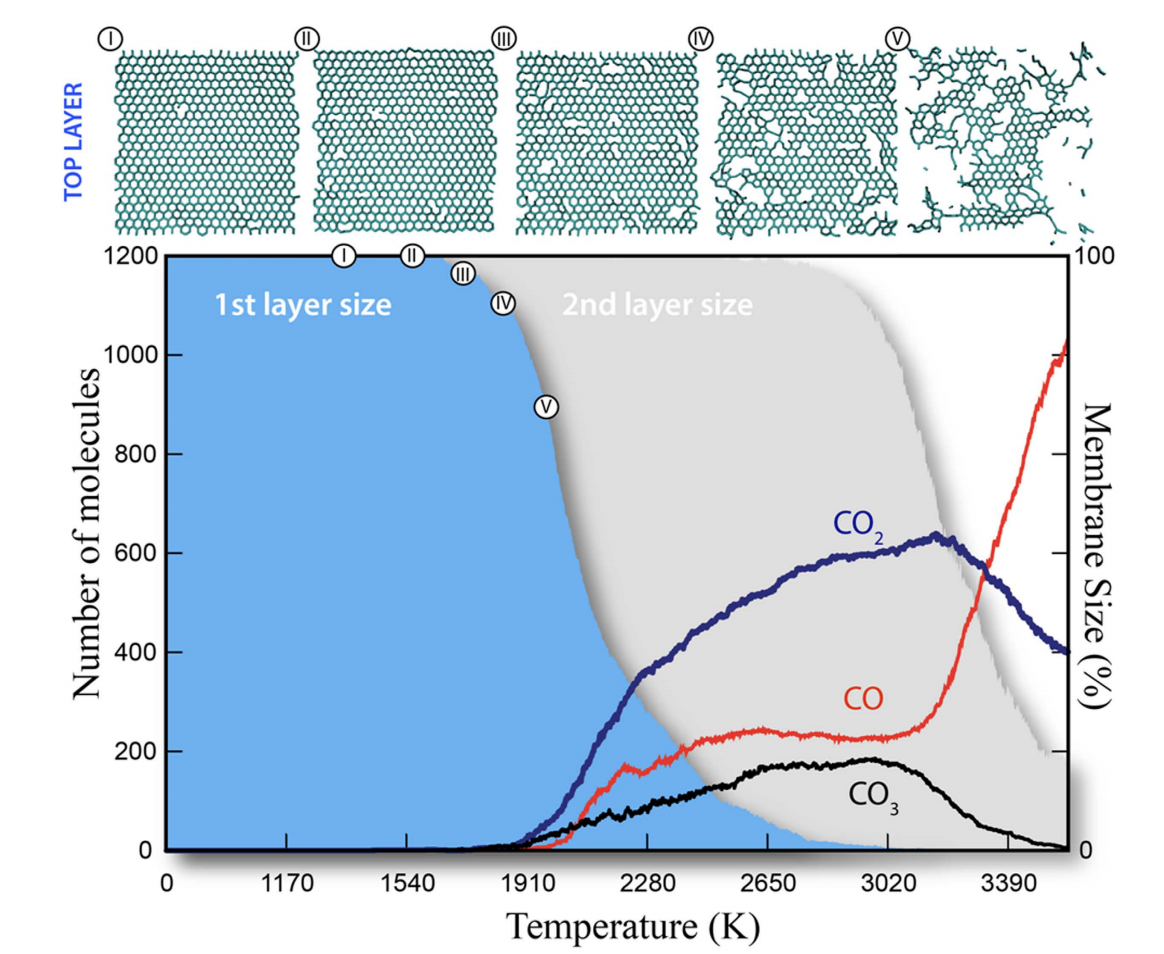
Andrei V Alaferdov Victor A Ermakov, Alfredo R Vaz
Burning Graphene Layer-by-Layer Journal Article
In: Nature Scientific Reports, vol. 5, pp. 11546, 2015.
Abstract | Links | BibTeX | Tags: Burning, Graphene, Molecular Dynamics, TEM
@article{Ermakov2015,
title = {Burning Graphene Layer-by-Layer},
author = {Victor A Ermakov, Andrei V Alaferdov, Alfredo R Vaz, Eric Perim, Pedro AS Autreto, Ricardo Paupitz, Douglas S Galvao, Stanislav A Moshkalev},
url = {http://www.nature.com/articles/srep11546?WT.ec_id=SREP-639-20150630},
doi = {10.1038/srep11546},
year = {2015},
date = {2015-06-23},
journal = {Nature Scientific Reports},
volume = {5},
pages = {11546},
abstract = {Graphene, in single layer or multi-layer forms, holds great promise for future electronics and high-temperature applications. Resistance to oxidation, an important property for high-temperature applications, has not yet been extensively investigated. Controlled thinning of multi-layer graphene (MLG), e.g., by plasma or laser processing is another challenge, since the existing methods produce non-uniform thinning or introduce undesirable defects in the basal plane. We report here that heating to extremely high temperatures (exceeding 2000 K) and controllable layer-by-layer burning (thinning) can be achieved by low-power laser processing of suspended high-quality MLG in air in “cold-wall” reactor configuration. In contrast, localized laser heating of supported samples results in non-uniform graphene burning at much higher rates. Fully atomistic molecular dynamics simulations were also performed to reveal details of oxidation mechanisms leading to uniform layer-by-layer graphene gasification. The extraordinary resistance of MLG to oxidation paves the way to novel high-temperature applications as continuum light source or scaffolding material.},
keywords = {Burning, Graphene, Molecular Dynamics, TEM},
pubstate = {published},
tppubtype = {article}
}
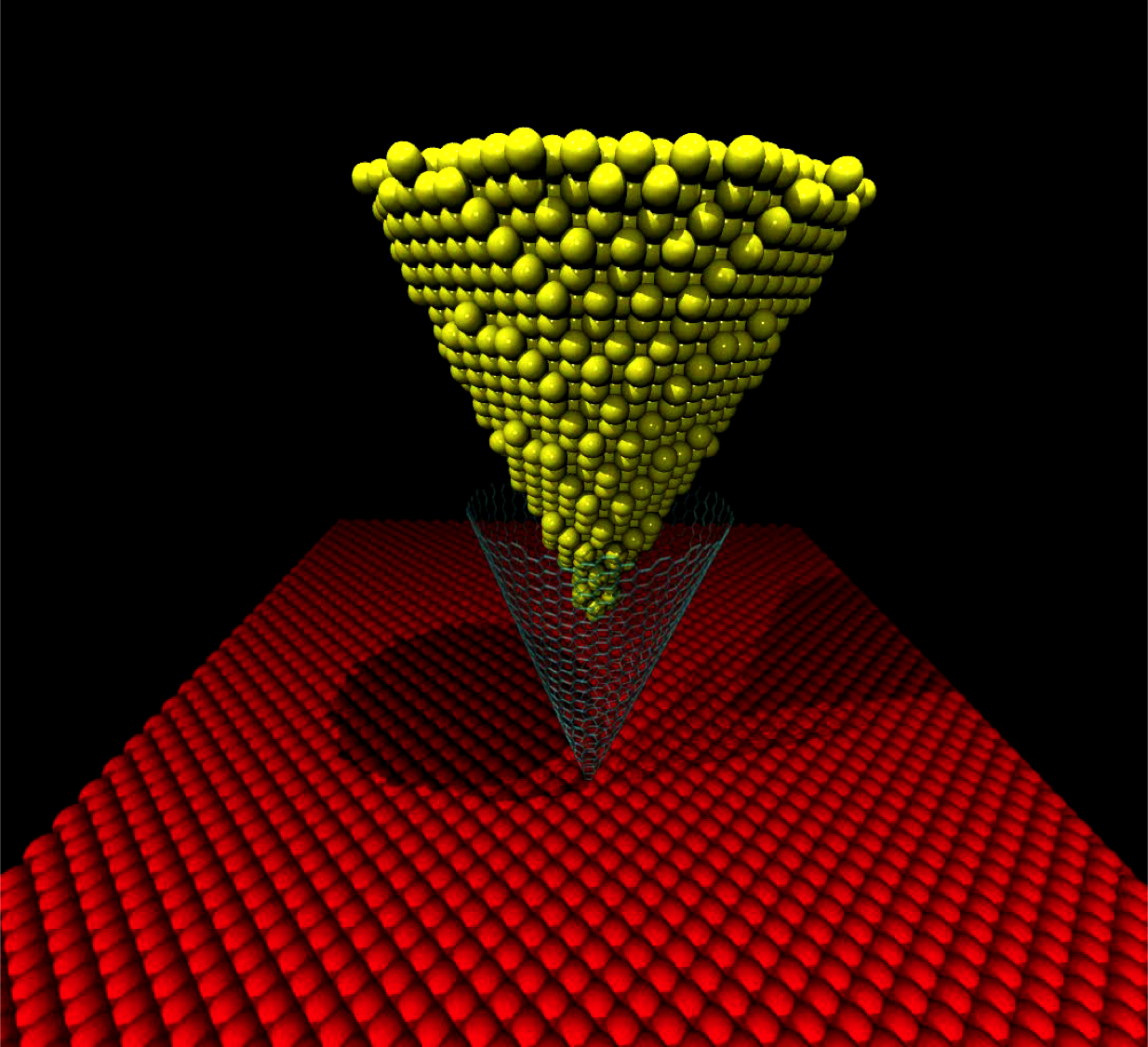
Wesller G Schmidt Abraham G Cano-Marquez, Jenaina Ribeiro-Soares
Enhanced Mechanical Stability of Gold Nanotips through Carbon Nanocone Encapsulation Journal Article
In: Nature Scientific Reports, vol. 5, pp. 10408, 2015.
Abstract | Links | BibTeX | Tags: Gold Nanotips, Molecular Dynamics, Nanocones
@article{Cano-Marquez2015,
title = {Enhanced Mechanical Stability of Gold Nanotips through Carbon Nanocone Encapsulation},
author = {Abraham G Cano-Marquez, Wesller G Schmidt, Jenaina Ribeiro-Soares, Luiz Gustavo Cançado, Wagner N Rodrigues, Adelina P Santos, Clascidia A Furtado, Pedro AS Autreto, Ricardo Paupitz, Douglas S Galvão, Ado Jorio},
url = {http://www.nature.com/articles/srep10408},
doi = {10.1038/srep10408},
year = {2015},
date = {2015-06-17},
journal = {Nature Scientific Reports},
volume = {5},
pages = {10408},
abstract = {Gold is a noble metal that, in comparison with silver and copper, has the advantage of corrosion resistance. Despite its high conductivity, chemical stability and biocompatibility, gold exhibits high plasticity, which limits its applications in some nanodevices. Here, we report an experimental and theoretical study on how to attain enhanced mechanical stability of gold nanotips. The gold tips were fabricated by chemical etching and further encapsulated with carbon nanocones via nanomanipulation. Atomic force microscopy experiments were carried out to test their mechanical stability. Molecular dynamics simulations show that the encapsulated nanocone changes the strain release mechanisms at the nanoscale by blocking gold atomic sliding, redistributing the strain along the whole nanostructure. The carbon nanocones are conducting and can induce magnetism, thus opening new avenues on the exploitation of transport, mechanical and magnetic properties of gold covered by sp2 carbon at the nanoscale.},
keywords = {Gold Nanotips, Molecular Dynamics, Nanocones},
pubstate = {published},
tppubtype = {article}
}
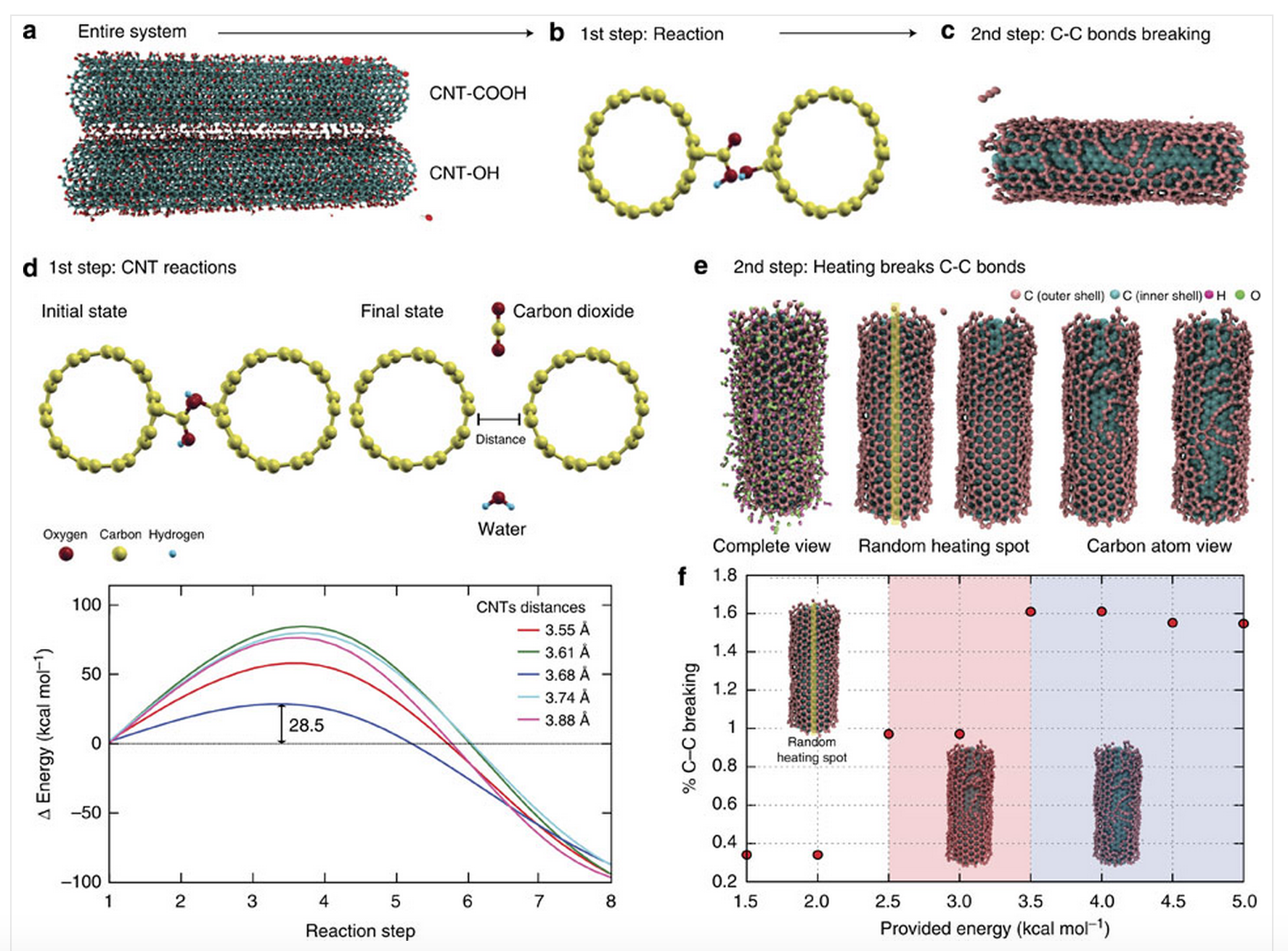
Chandra Sekhar Tiwary Mohamad A Kabbani, Pedro AS Autreto
Ambient solid-state mechano-chemical reactions between functionalized carbon nanotubes Journal Article
In: Nature Communications, vol. 6, pp. 7291, 2015.
Abstract | Links | BibTeX | Tags: Carbon Nanotubes, Chemical Reactions, Electronic Structure, Molecular Dynamics, top20
@article{Kabbani2015,
title = {Ambient solid-state mechano-chemical reactions between functionalized carbon nanotubes},
author = {Mohamad A Kabbani, Chandra Sekhar Tiwary, Pedro AS Autreto, Gustavo Brunetto, Anirban Som, KR Krishnadas, Sehmus Ozden, Ken P Hackenberg, Yongi Gong, Douglas S Galvao, Robert Vajtai, Ahmad T Kabbani, Thalappil Pradeep, Pulickel M Ajayan},
url = {http://www.nature.com/ncomms/2015/150615/ncomms8291/full/ncomms8291.html},
doi = {10.1038/ncomms8291},
year = {2015},
date = {2015-06-15},
journal = {Nature Communications},
volume = {6},
pages = {7291},
abstract = {Carbon nanotubes can be chemically modified by attaching various functionalities to their surfaces, although harsh chemical treatments can lead to their break-up into graphene nanostructures. On the other hand, direct coupling between functionalities bound on individual nanotubes could lead to, as yet unexplored, spontaneous chemical reactions. Here we report an ambient mechano-chemical reaction between two varieties of nanotubes, carrying predominantly carboxyl and hydroxyl functionalities, respectively, facilitated by simple mechanical grinding of the reactants. The purely solid-state reaction between the chemically differentiated nanotube species produces condensation products and unzipping of nanotubes due to local energy release, as confirmed by spectroscopic measurements, thermal analysis and molecular dynamic simulations.},
keywords = {Carbon Nanotubes, Chemical Reactions, Electronic Structure, Molecular Dynamics, top20},
pubstate = {published},
tppubtype = {article}
}
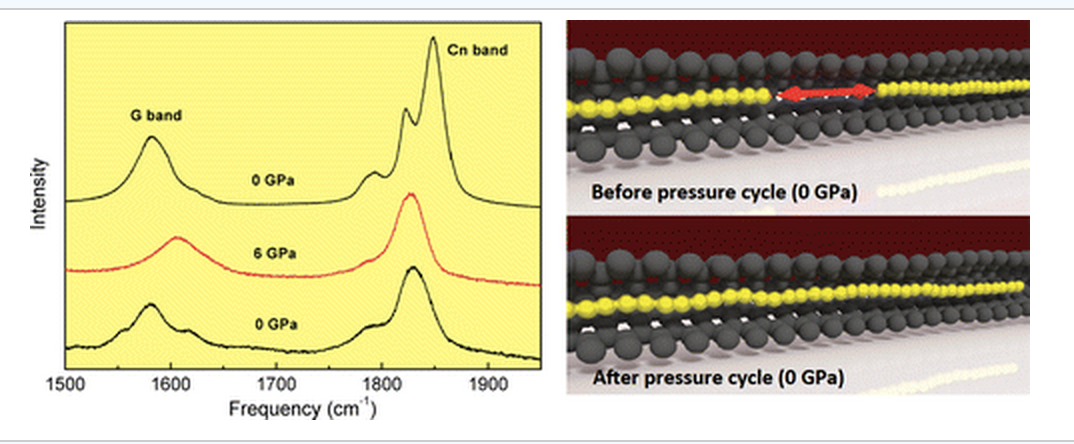
Acrísio L Aguiar Nadia Ferreira Andrade, Yoong Ahm Kim
Linear Carbon Chains Under High Pressure Conditions Journal Article
In: The Journal of Physical Chemistry C, vol. 119, no. 19, pp. 10669–10676, 2015.
Abstract | Links | BibTeX | Tags: Atomic Chains, Carbon Nanotubes, Electronic Structure, Molecular Dynamics, Raman
@article{Andrade2015,
title = {Linear Carbon Chains Under High Pressure Conditions},
author = {Nadia Ferreira Andrade, Acrísio L Aguiar, Yoong Ahm Kim, Morinobu Endo, Paulo TC Freire, Gustavo Bruneto, Douglas Soares Galvao, Mildred S Dresselhaus, Antonio Gomes Souza Filho},
url = {http://pubs.acs.org/doi/abs/10.1021/acs.jpcc.5b00902},
doi = {10.1021/acs.jpcc.5b00902},
year = {2015},
date = {2015-04-23},
journal = {The Journal of Physical Chemistry C},
volume = {119},
number = {19},
pages = {10669–10676},
abstract = {A high-pressure resonance Raman spectroscopy study of linear carbon chains encapsulated inside multiwalled carbon nanotubes (MWCNTs) is reported. While the frequencies of the tangential modes of carbon nanotubes (G band) harden as the pressure increases, the vibrational frequencies of the chain modes (around 1850 cm–1) decrease, thus indicating a softening of the carbon–carbon bonds in this 1D solid. Pressure-induced irreversible structural changes in the linear carbon chains are unveiled by the red shift in the vibrational modes when pressure is released. These results have been interpreted as being due to a coalescence of carbon chains, and this hypothesis is supported by state-of-the-art atomistic reactive molecular dynamics simulations.},
keywords = {Atomic Chains, Carbon Nanotubes, Electronic Structure, Molecular Dynamics, Raman},
pubstate = {published},
tppubtype = {article}
}
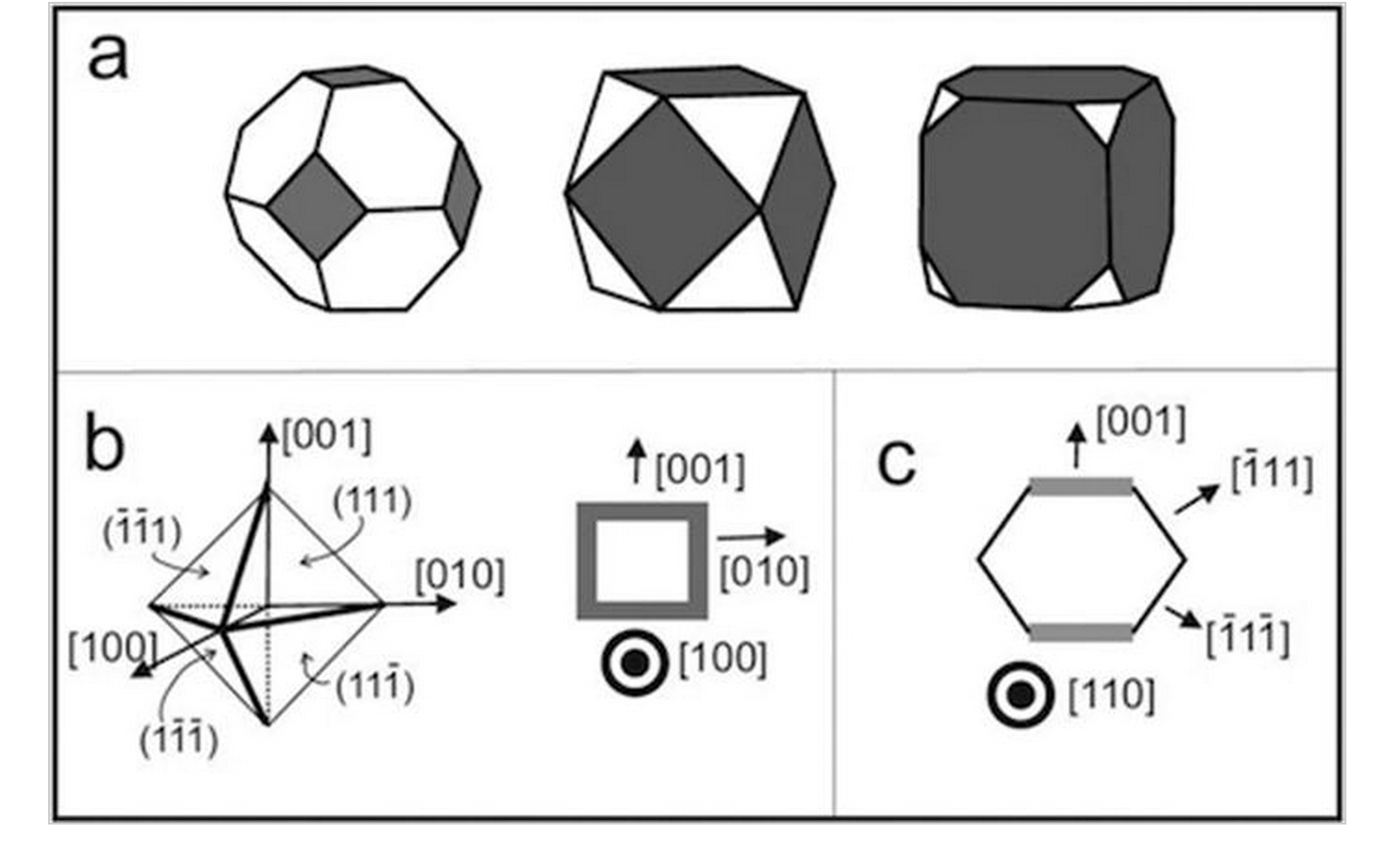
PAS Autreto MJ Lagos, J Bettini
Surface effects on the mechanical elongation of AuCu nanowires: De-alloying and the formation of mixed suspended atomic chains Journal Article
In: Journal of Applied Physics, vol. 117, no. 9, pp. 094301, 2015.
Abstract | Links | BibTeX | Tags: Metallic Nanowires, Molecular Dynamics, TEM, Theory of Electronic Indices
@article{Lagos2015,
title = {Surface effects on the mechanical elongation of AuCu nanowires: De-alloying and the formation of mixed suspended atomic chains},
author = {MJ Lagos, PAS Autreto, J Bettini, F Sato, SO Dantas, DS Galvao, D Ugarte},
url = {http://scitation.aip.org/content/aip/journal/jap/117/9/10.1063/1.4913625},
doi = {10.1063/1.4913625},
year = {2015},
date = {2015-03-07},
journal = {Journal of Applied Physics},
volume = {117},
number = {9},
pages = {094301},
abstract = {We report here an atomistic study of the mechanical deformation of Au x Cu (1− x ) atomic-size wires (nanowires (NWs)) by means of high resolution transmission electron microscopy experiments. Molecular dynamics simulations were also carried out in order to obtain deeper insights on the dynamical properties of stretched NWs. The mechanical properties are significantly dependent on the chemical composition that evolves in time at the junction; some structures exhibit a remarkable de-alloying behavior. Also, our results represent the first experimental realization of mixed linear atomic chains (LACs) among transition and noble metals; in particular, surface energies induce chemical gradients on NW surfaces that can be exploited to control the relative LAC compositions (different number of gold and copper atoms). The implications of these results for nanocatalysis and spin transport of one-atom-thick metal wires are addressed.},
keywords = {Metallic Nanowires, Molecular Dynamics, TEM, Theory of Electronic Indices},
pubstate = {published},
tppubtype = {article}
}
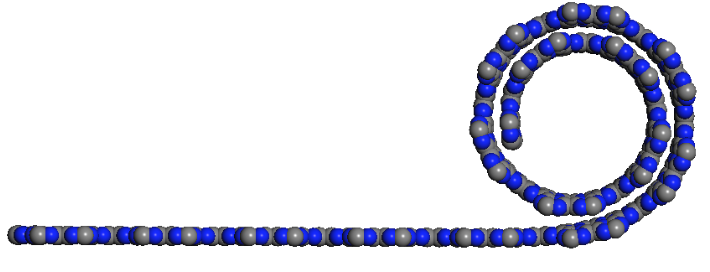
Eric Perim, Douglas S. Galvao
Novel Nanoscroll Structures from Carbon Nitride Layers Online
2015, (ArXiv Draft MRS Proceedings, 1726, mrsf14-1726-j05-02 (2015)).
Abstract | Links | BibTeX | Tags: carbon nitride, Molecular Dynamics, Scrolls
@online{Perim2015,
title = {Novel Nanoscroll Structures from Carbon Nitride Layers},
author = {Eric Perim, Douglas S. Galvao},
url = {http://arxiv.org/abs/1502.00260},
year = {2015},
date = {2015-02-02},
abstract = {Nanoscrolls consist of sheets rolled up into a papyrus-like form. Their open ends produce great radial flexibility, which can be exploited for a large variety of applications, from actuators to hydrogen storage. They have been successfully synthesized from different materials, including carbon and boron nitride. In this work we have investigated, through fully atomistic molecular dynamics simulations, the dynamics of scroll formation for a series of graphene-like carbon nitride (CN) two-dimensional systems: g-CN, triazine-based (g-C3N4), and heptazine-based (g-C3N4). Carbon nitride (CN) structures have been attracting great attention since their prediction as super hard materials. Recently, graphene-like carbon nitride (g-CN) structures have been synthesized with distinct stoichiometry and morphologies. By combining these unique CN characteristics with the structural properties inherent to nanoscrolls new nanostructures with very attractive mechanical and electronic properties could be formed. Our results show that stable nanoscrolls can be formed for all of CN structures we have investigated here. As the CN sheets have been already synthesized, these new scrolled structures are perfectly feasible and within our present-day technology.},
note = {ArXiv Draft MRS Proceedings, 1726, mrsf14-1726-j05-02 (2015)},
keywords = {carbon nitride, Molecular Dynamics, Scrolls},
pubstate = {published},
tppubtype = {online}
}
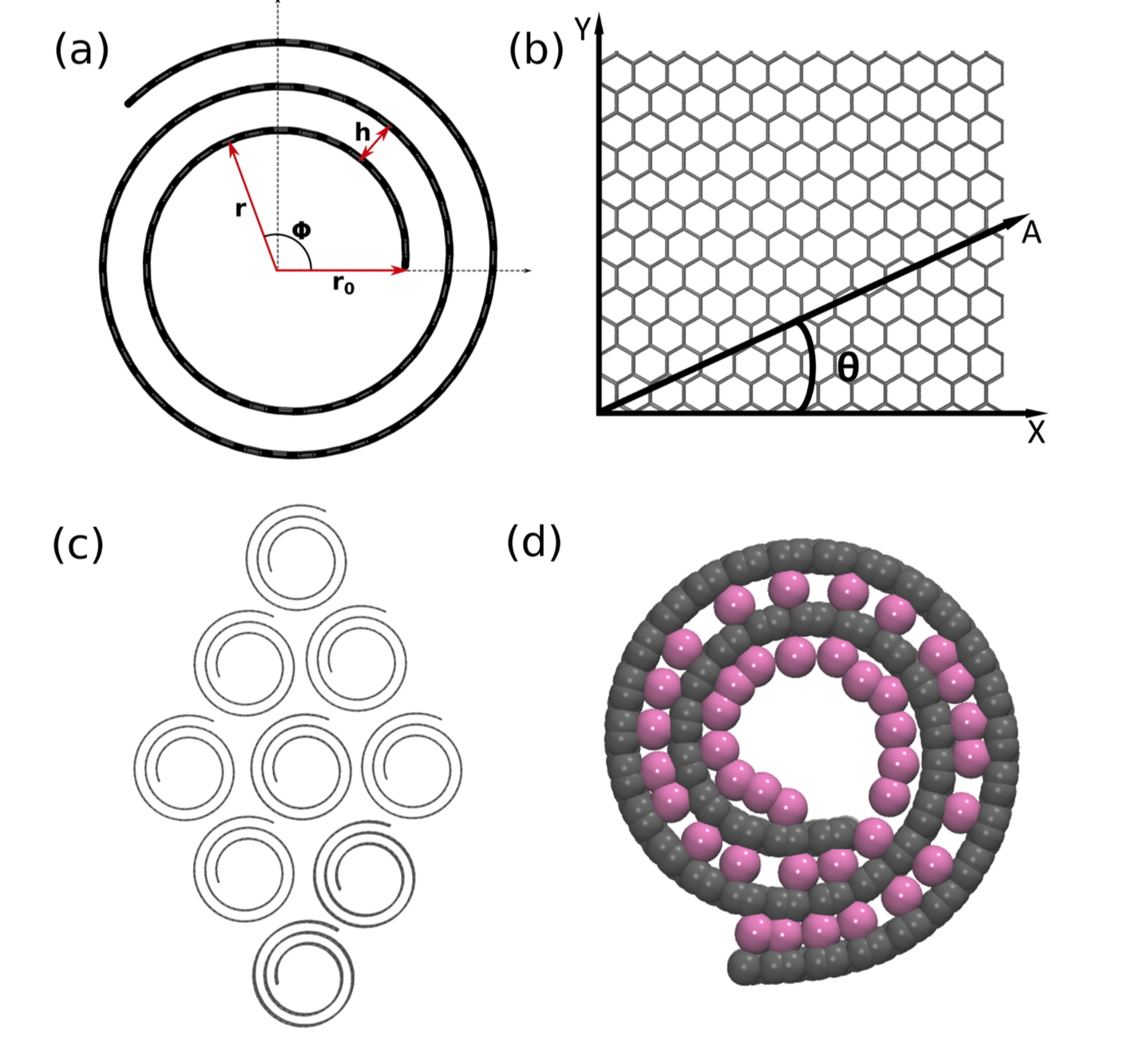
L. D. Machado E. Perim, D. S. Galvao
A Brief Review on Syntheses, Structures and Applications of Nanoscrolls Online
2015, (ArXiv draft of Frontiers in Materials, 1 pp. 31, 2014).
Abstract | Links | BibTeX | Tags: Molecular Dynamics, Scrolls
@online{Perim2015b,
title = {A Brief Review on Syntheses, Structures and Applications of Nanoscrolls},
author = {E. Perim, L. D. Machado, D. S. Galvao},
url = {http://arxiv.org/abs/1501.05711 },
year = {2015},
date = {2015-01-21},
journal = {arXiv preprint 1501.05711v1},
abstract = {Nanoscrolls are papyrus-like nanostructures which present unique properties due to their open ended morphology. These properties can be exploited in a plethora of technological applications, leading to the design of novel and interesting devices. During the past decade, significant advances in the synthesis and characterization of these structures have been made, but many challenges still remain. In this mini review we provide an overview on their history, experimental synthesis methods, basic properties and application perspectives.},
note = {ArXiv draft of Frontiers in Materials, 1 pp. 31, 2014},
keywords = {Molecular Dynamics, Scrolls},
pubstate = {published},
tppubtype = {online}
}
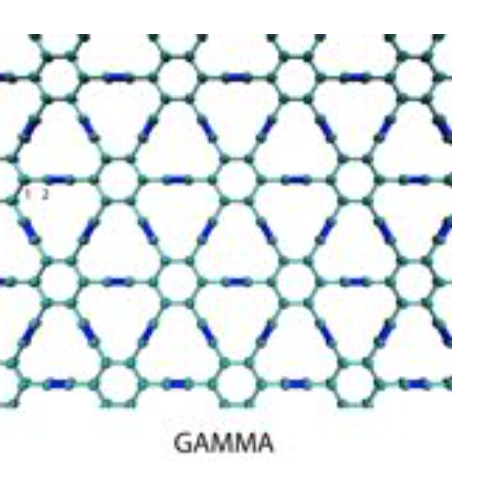
Pedro A. S. Autreto, Douglas S. Galvao
Site dependent hydrogenation in Graphynes: A Fully Atomistic Molecular Dynamics Investigation Online
2015, (ArXiv draft of MRS Proceedings, 1726, mrsf14-1726-j02-02 (2015)).
Abstract | Links | BibTeX | Tags: Graphynes, Hydrogenation, Molecular Dynamics
@online{Autreto2015,
title = {Site dependent hydrogenation in Graphynes: A Fully Atomistic Molecular Dynamics Investigation},
author = {Pedro A. S. Autreto, Douglas S. Galvao},
url = {http://arxiv.org/abs/1501.04521},
year = {2015},
date = {2015-01-19},
journal = {arXiv preprint 1501.04521},
abstract = {Graphyne is a generic name for a carbon allotrope family of 2D structures, where acetylenic groups connect benzenoid rings, with the coexistence of sp and sp2 hybridized carbon atoms. In this work we have investigated, through fully atomistic reactive molecular dynamics simulations, the dynamics and structural changes of the hydrogenation of ALPHA, BETA, GAMMA graphyne forms. Our results showed that the existence of different sites for hydrogen bonding, related to single and triple bonds, makes the process of incorporating hydrogen atoms into graphyne membranes much more complex than the graphene ones. Our results also show that hydrogenation reactions are strongly site dependent and that the sp-hybridized carbon atoms are the preferential sites to chemical attacks. In our cases, the effectiveness of the hydrogenation (estimated from the number of hydrogen atoms covalently bonded to carbon atoms) follows the ALPHA, BETA, GAMMA graphyne structure ordering.},
note = {ArXiv draft of MRS Proceedings, 1726, mrsf14-1726-j02-02 (2015)},
keywords = {Graphynes, Hydrogenation, Molecular Dynamics},
pubstate = {published},
tppubtype = {online}
}
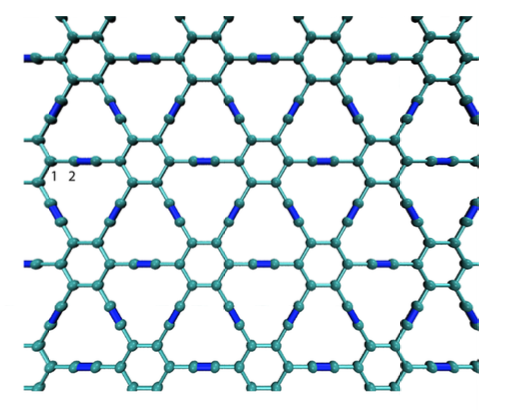
Pedro A. S. Autreto, Douglas S. Galvao
Site Dependent Hydrogenation in Graphynes: A Fully Atomistic Molecular Dynamics Investigation Proceedings
vol. 1726, no. mrsf14-1726-j02-02, 2015, (MRS Proceedings, 1726, mrsf14-1726-j02-02 ).
Abstract | Links | BibTeX | Tags: Graphynes, Hydrogenation, Molecular Dynamics
@proceedings{Autreto2015b,
title = {Site Dependent Hydrogenation in Graphynes: A Fully Atomistic Molecular Dynamics Investigation},
author = {Pedro A. S. Autreto, Douglas S. Galvao},
url = {http://journals.cambridge.org/action/displayAbstract?fromPage=online&aid=9702693&fulltextType=RA&fileId=S1946427415004649},
doi = {10.1557/opl.2015.464},
year = {2015},
date = {2015-01-01},
journal = {Mater. Res. Soc. Symp. Proc. },
volume = {1726},
number = {mrsf14-1726-j02-02},
abstract = {Graphyne is a generic name for a carbon allotrope family of 2D structures, where acetylenic groups connect benzenoid rings, with the coexistence of sp and sp2 hybridized carbon atoms. In this work we have investigated, through fully atomistic reactive molecular dynamics simulations, the dynamics and structural changes of the hydrogenation of α, β, and γ graphyne forms. Our results showed that the existence of different sites for hydrogen bonding, related to single and triple bonds, makes the process of incorporating hydrogen atoms into graphyne membranes much more complex than the graphene ones. Our results also show that hydrogenation reactions are strongly site dependent and that the sp-hybridized carbon atoms are the preferential sites to chemical attacks. In our cases, the effectiveness of the hydrogenation (estimated from the number of hydrogen atoms covalently bonded to carbon atoms) follows the α, β, γ-graphyne structure ordering.},
note = {MRS Proceedings, 1726, mrsf14-1726-j02-02 },
keywords = {Graphynes, Hydrogenation, Molecular Dynamics},
pubstate = {published},
tppubtype = {proceedings}
}
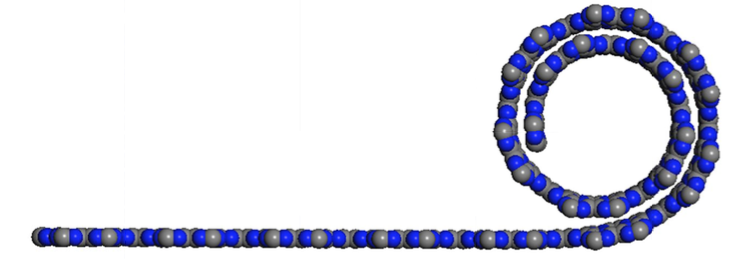
Eric Perim, Douglas S. Galvao
Novel Nanoscroll Structures from Carbon Nitride Layers Proceedings
vol. 1726, no. mrsf14-1726-j05-02, 2015, (MRS Proceedings, 1726, mrsf14-1726-j05-02 ).
Abstract | Links | BibTeX | Tags: carbon nitride, Molecular Dynamics, nanoscrolls
@proceedings{Perim2015b,
title = {Novel Nanoscroll Structures from Carbon Nitride Layers},
author = {Eric Perim, Douglas S. Galvao},
url = {http://journals.cambridge.org/action/displayAbstract?fromPage=online&aid=9700860&fileId=S1946427415004650},
doi = {DOI: 10.1557/opl.2015.465},
year = {2015},
date = {2015-01-01},
volume = {1726},
number = {mrsf14-1726-j05-02},
abstract = {Nanoscrolls consist of sheets rolled up into a papyrus-like form. Their open ends produce great radial flexibility, which can be exploited for a large variety of applications, from actuators to hydrogen storage. They have been successfully synthesized from different materials, including carbon and boron nitride. In this work we have investigated, through fully atomistic molecular dynamics simulations, the dynamics of scroll formation for a series of graphene-like carbon nitride (CN) two-dimensional systems: g-CN, triazine-based (g-C3N4), and heptazine-based (g-C3N4). Carbon nitride (CN) structures have been attracting great attention since their prediction as super hard materials. Recently, graphene-like carbon nitride (g-CN) structures have been synthesized with distinct stoichiometry and morphologies. By combining these unique CN characteristics with the structural properties inherent to nanoscrolls new nanostructures with very attractive mechanical and electronic properties could be formed. Our results show that stable nanoscrolls can be formed for all of CN structures we have investigated here. As the CN sheets have been already synthesized, these new scrolled structures are perfectly feasible and within our present-day technology.},
note = {MRS Proceedings, 1726, mrsf14-1726-j05-02 },
keywords = {carbon nitride, Molecular Dynamics, nanoscrolls},
pubstate = {published},
tppubtype = {proceedings}
}
http://scholar.google.com/citations?hl=en&user=95SvbM8AAAAJ


